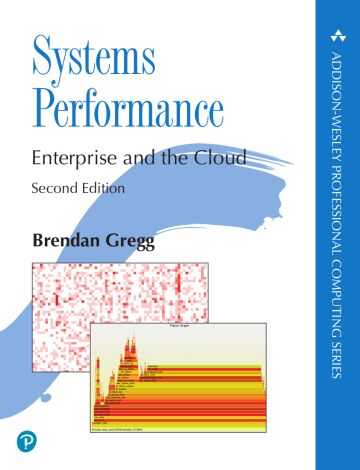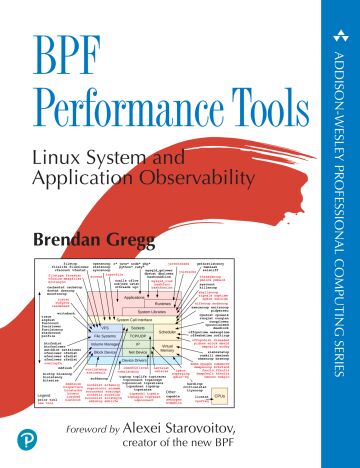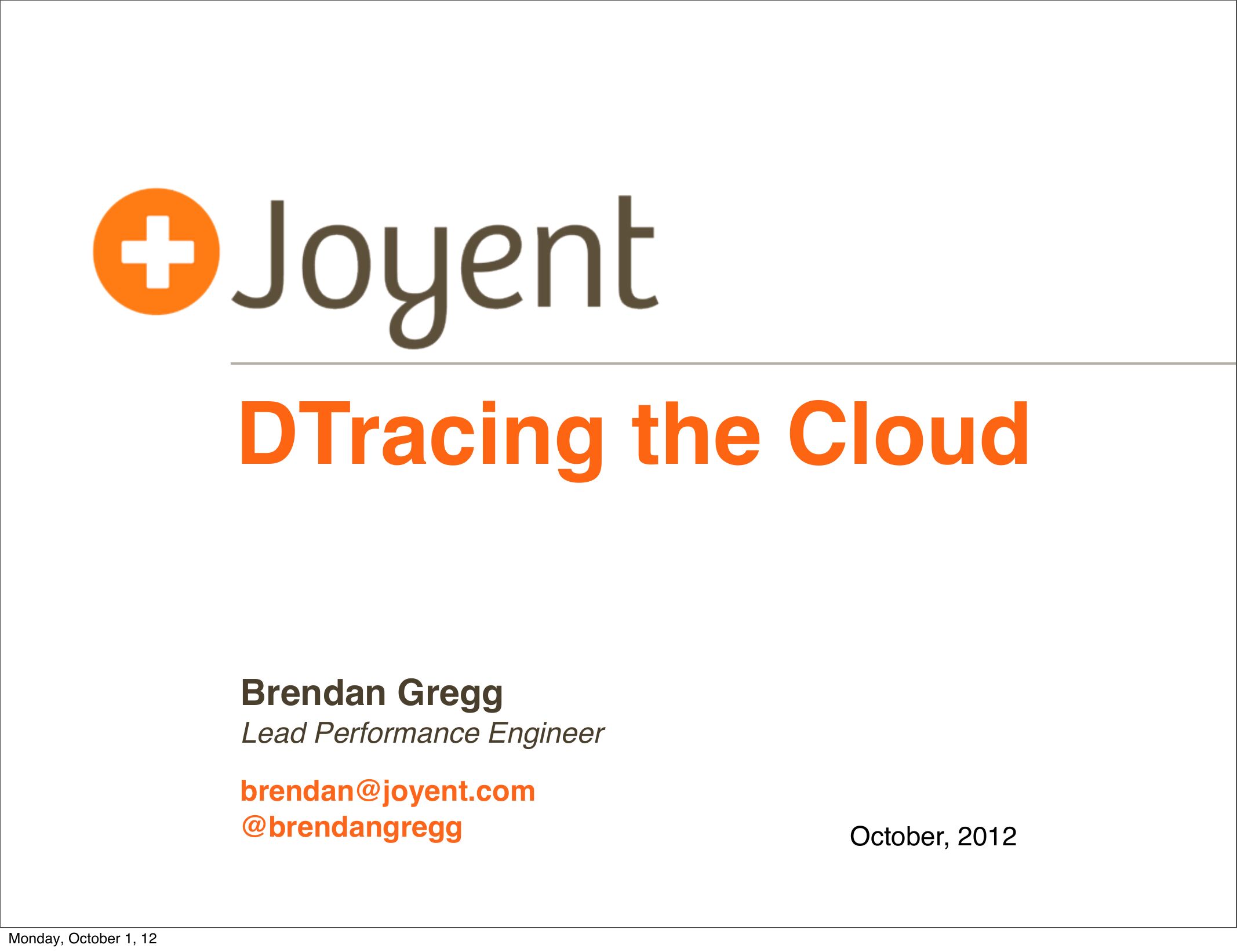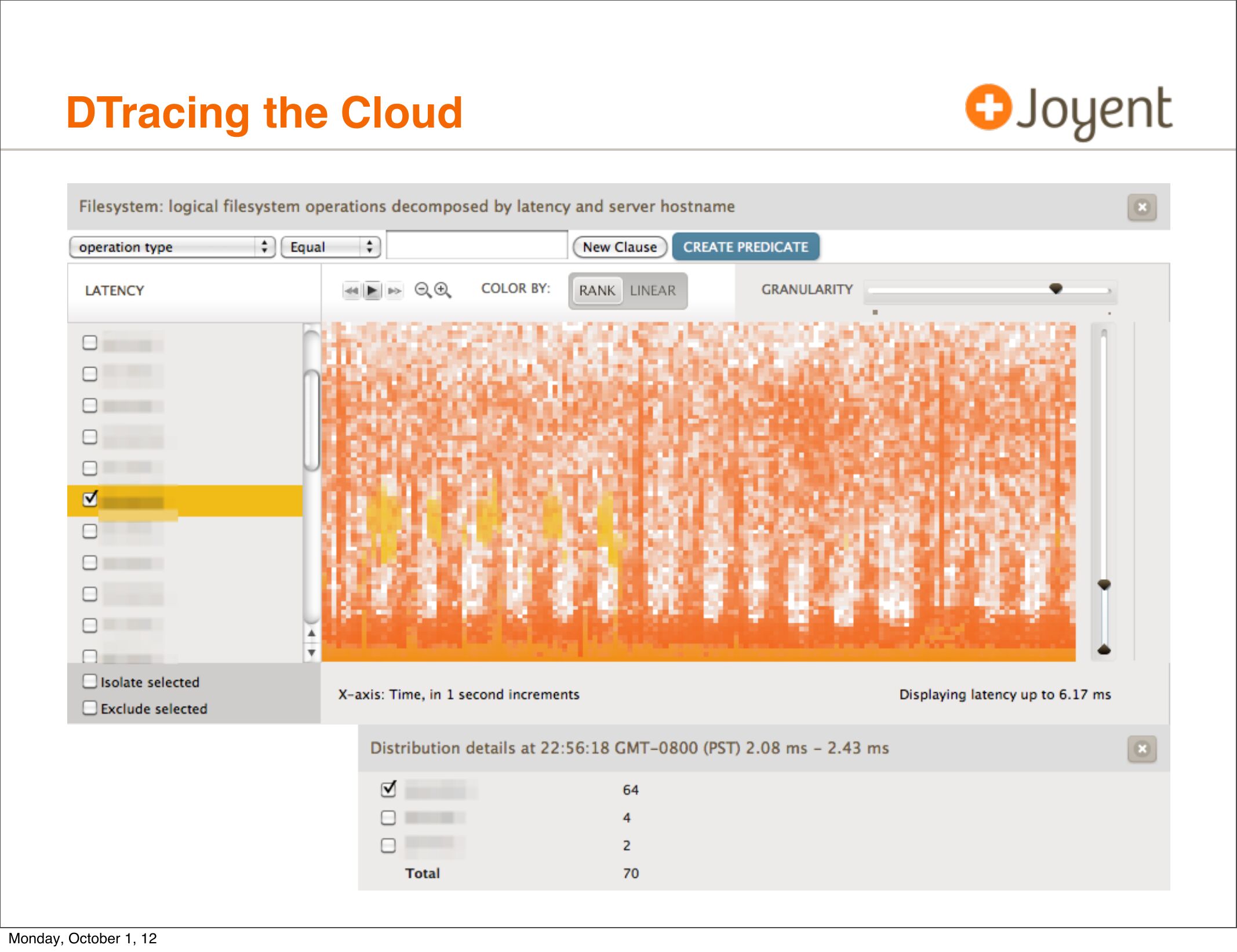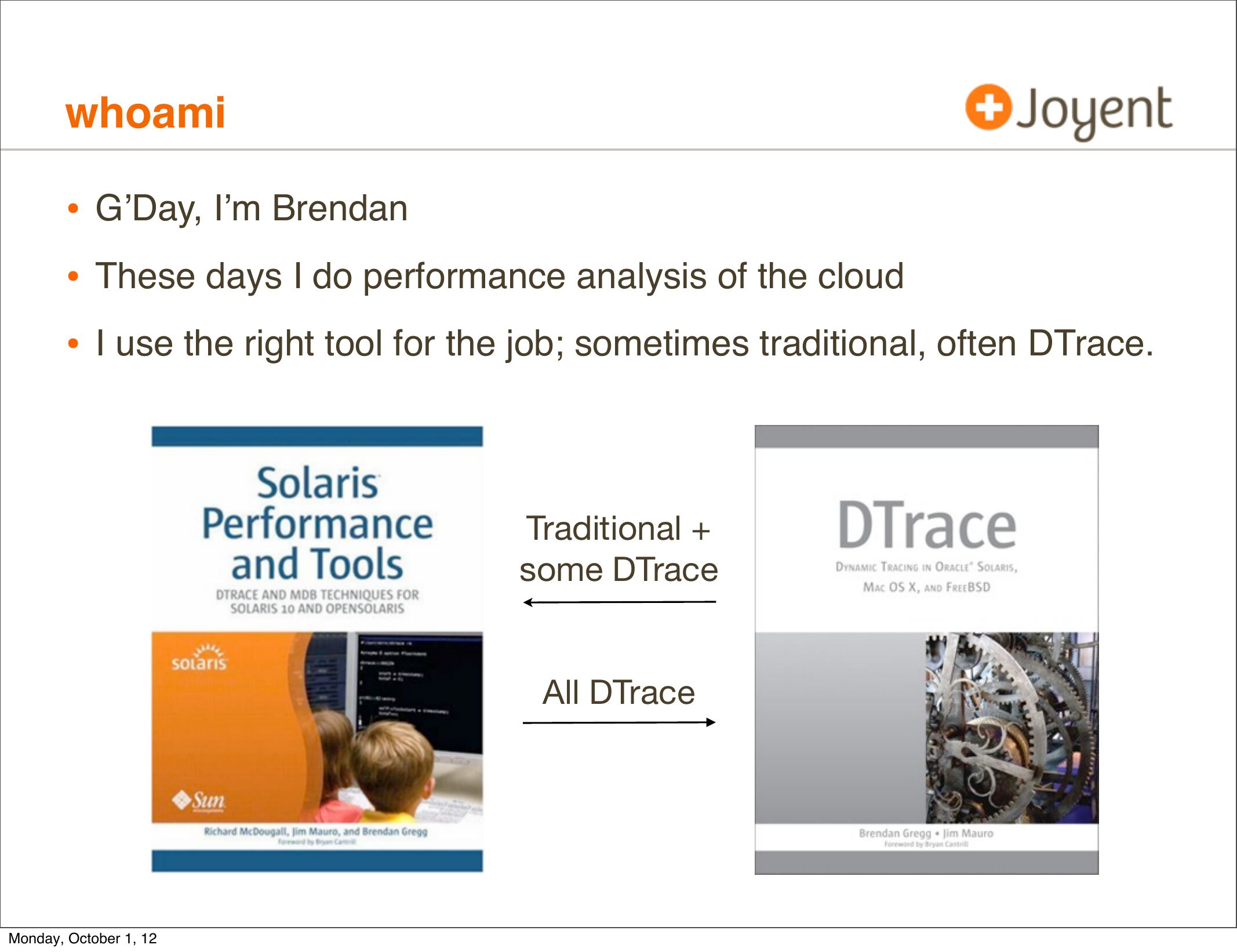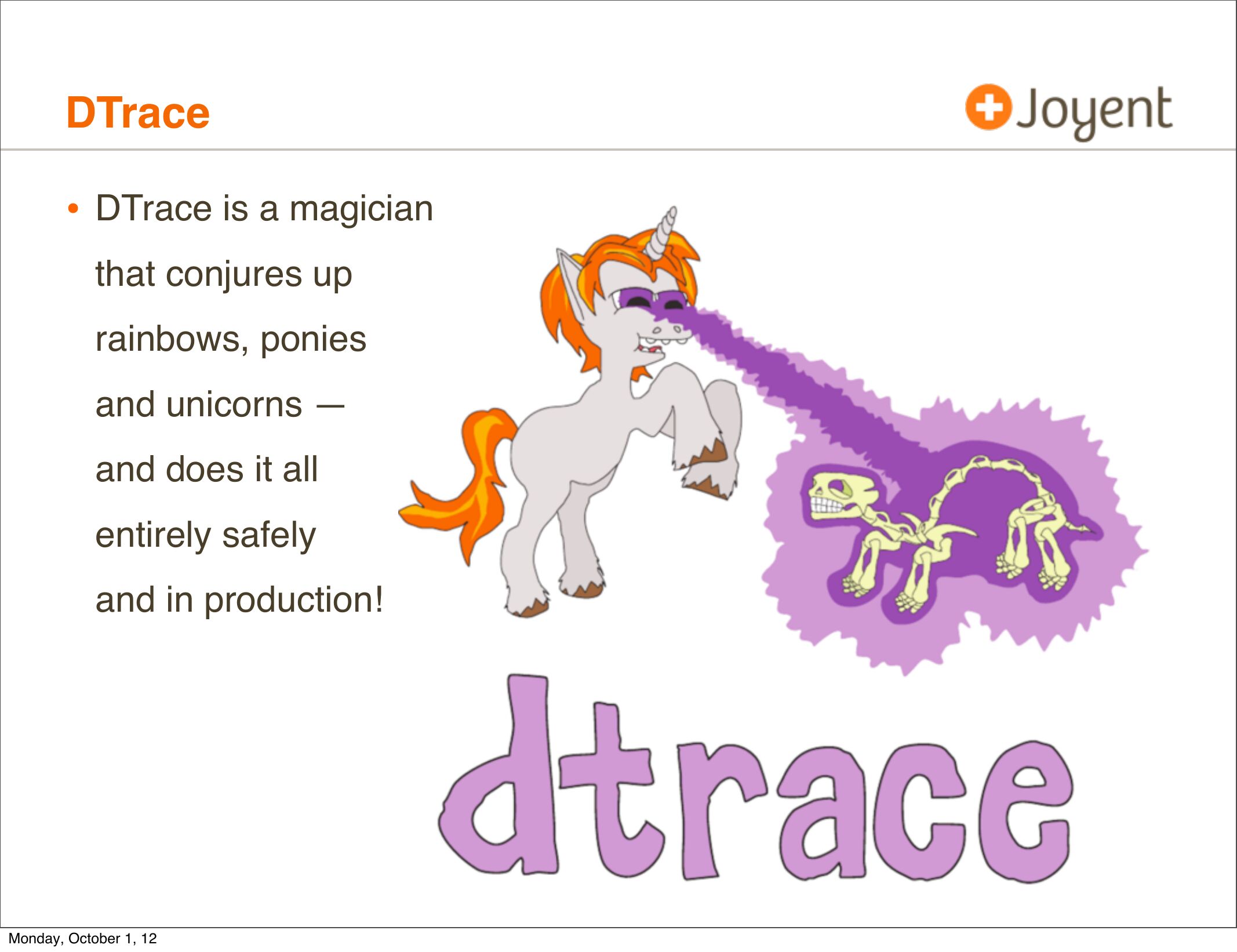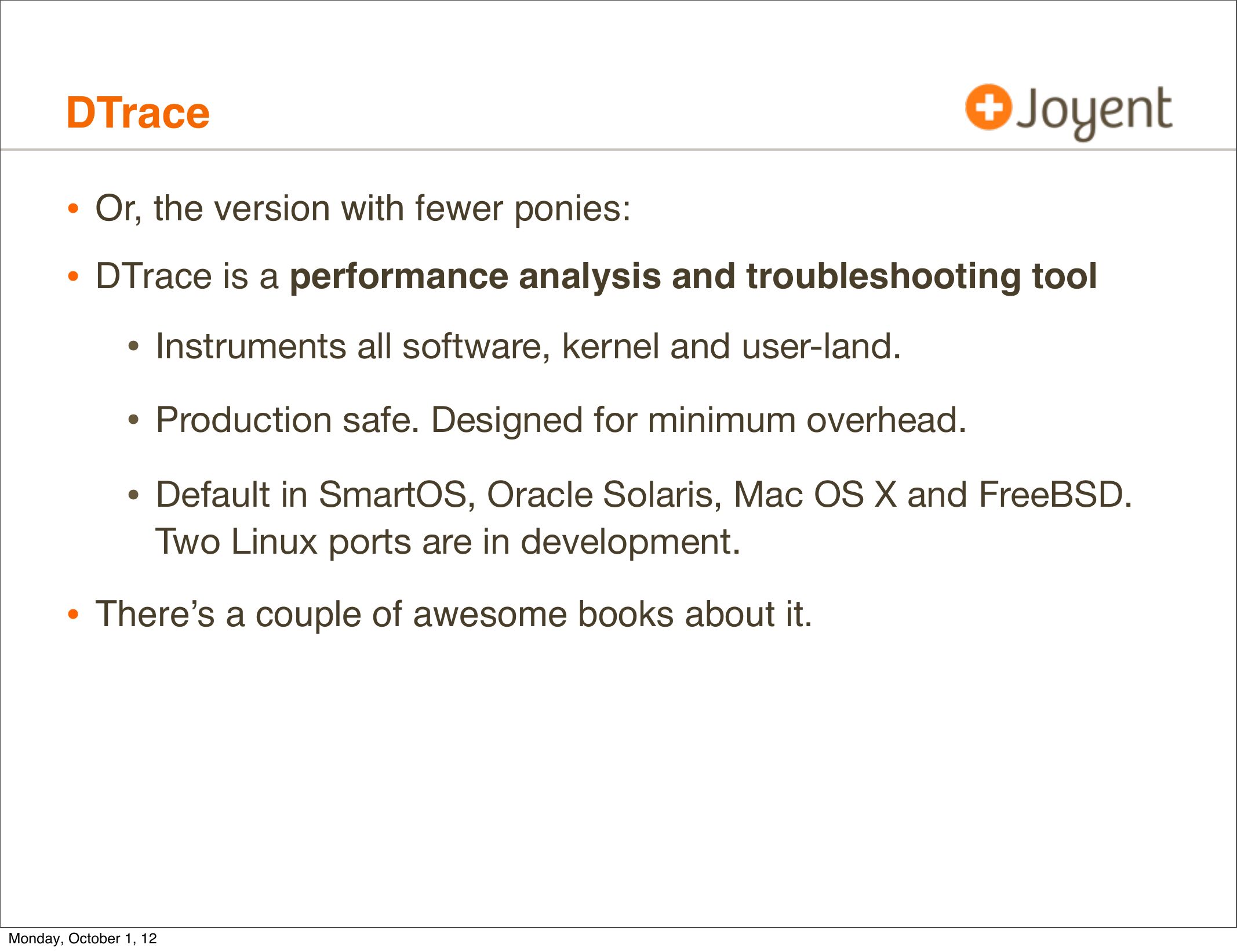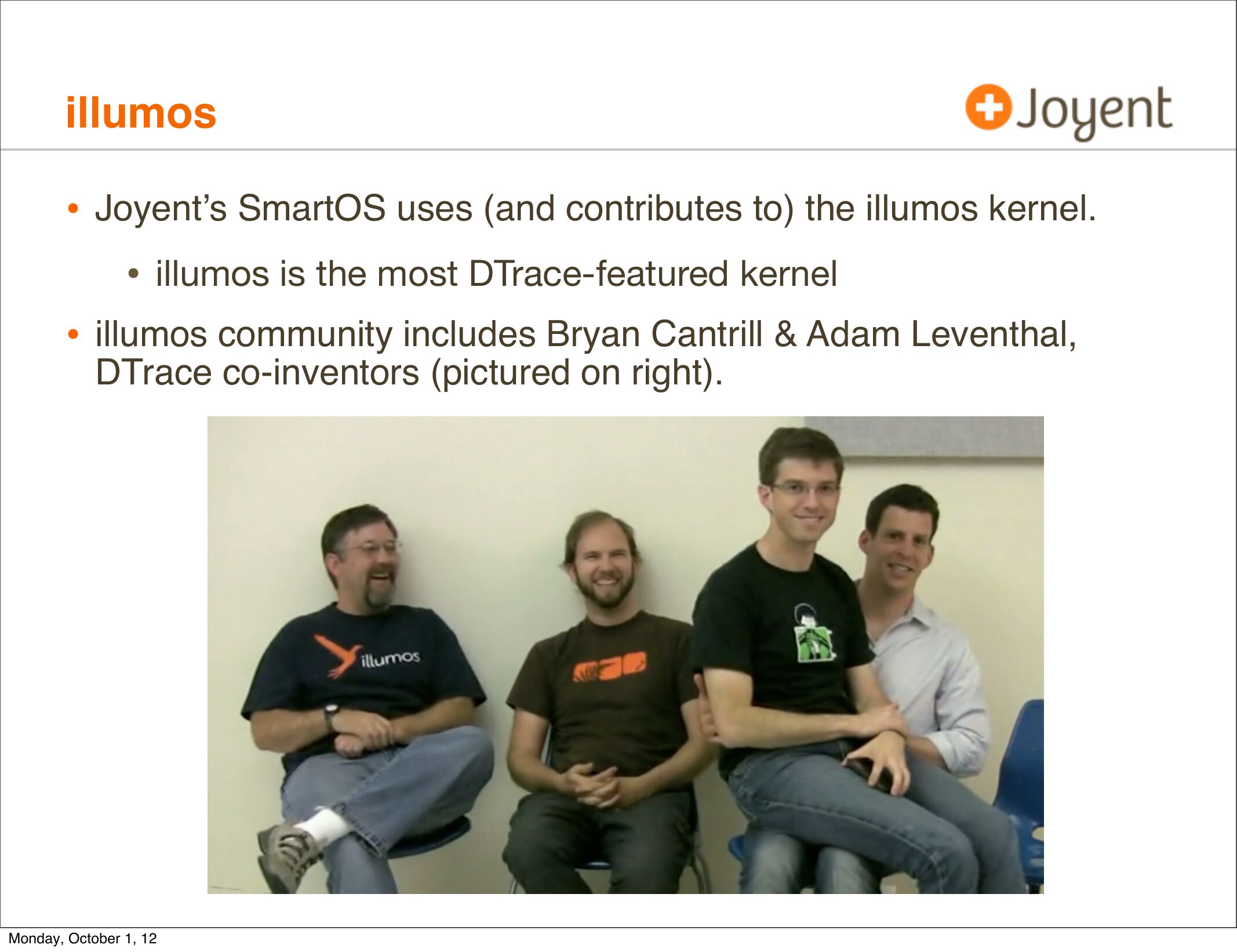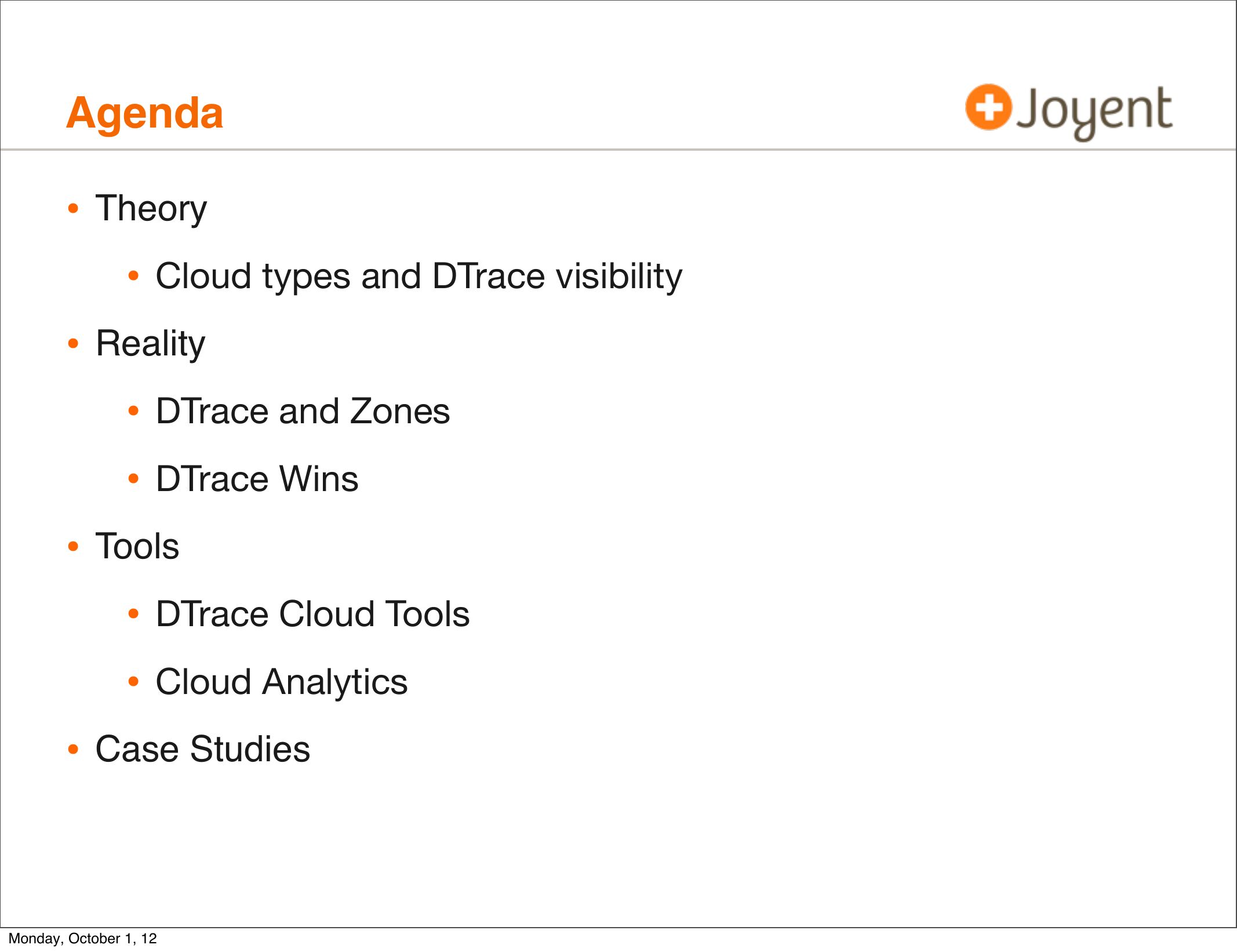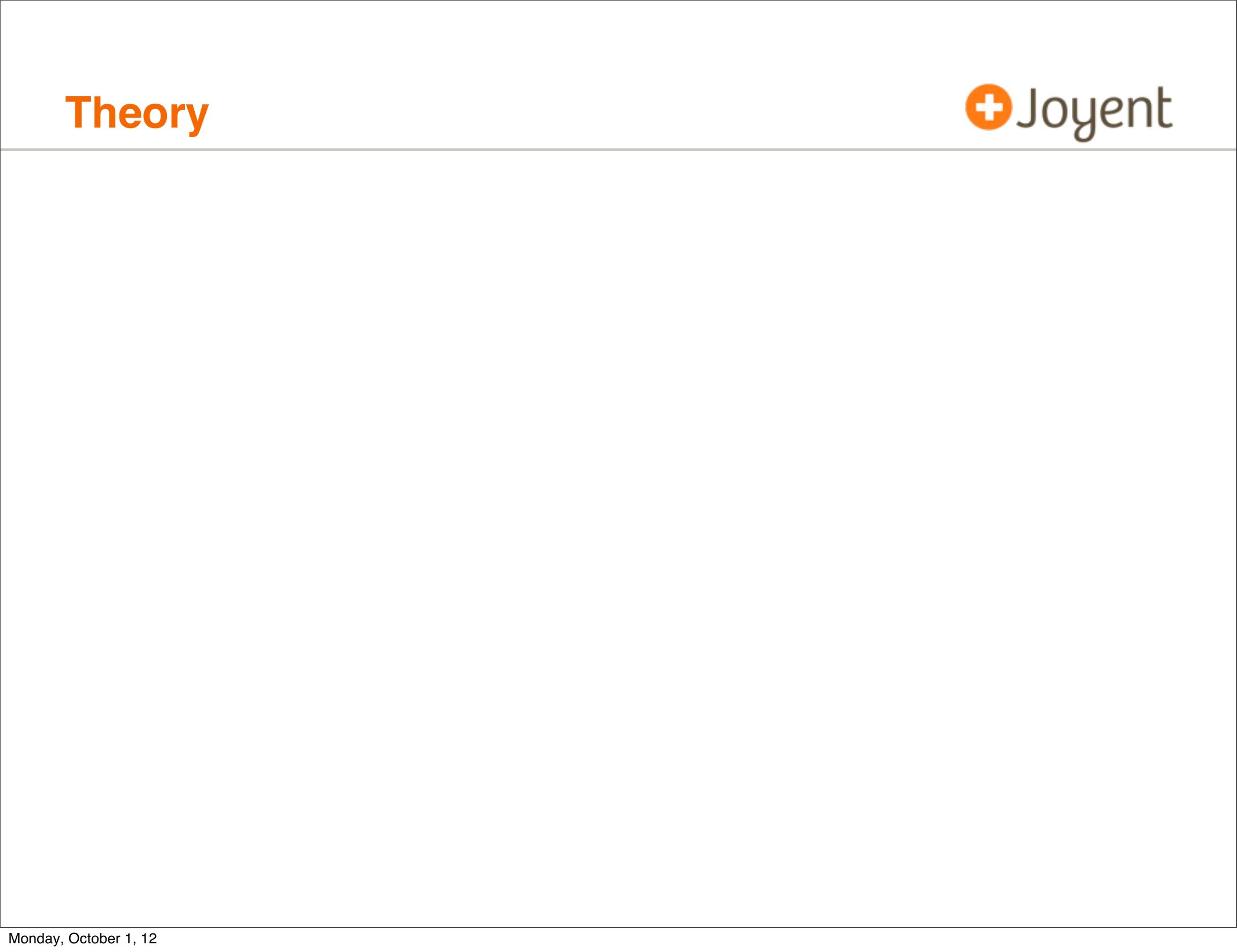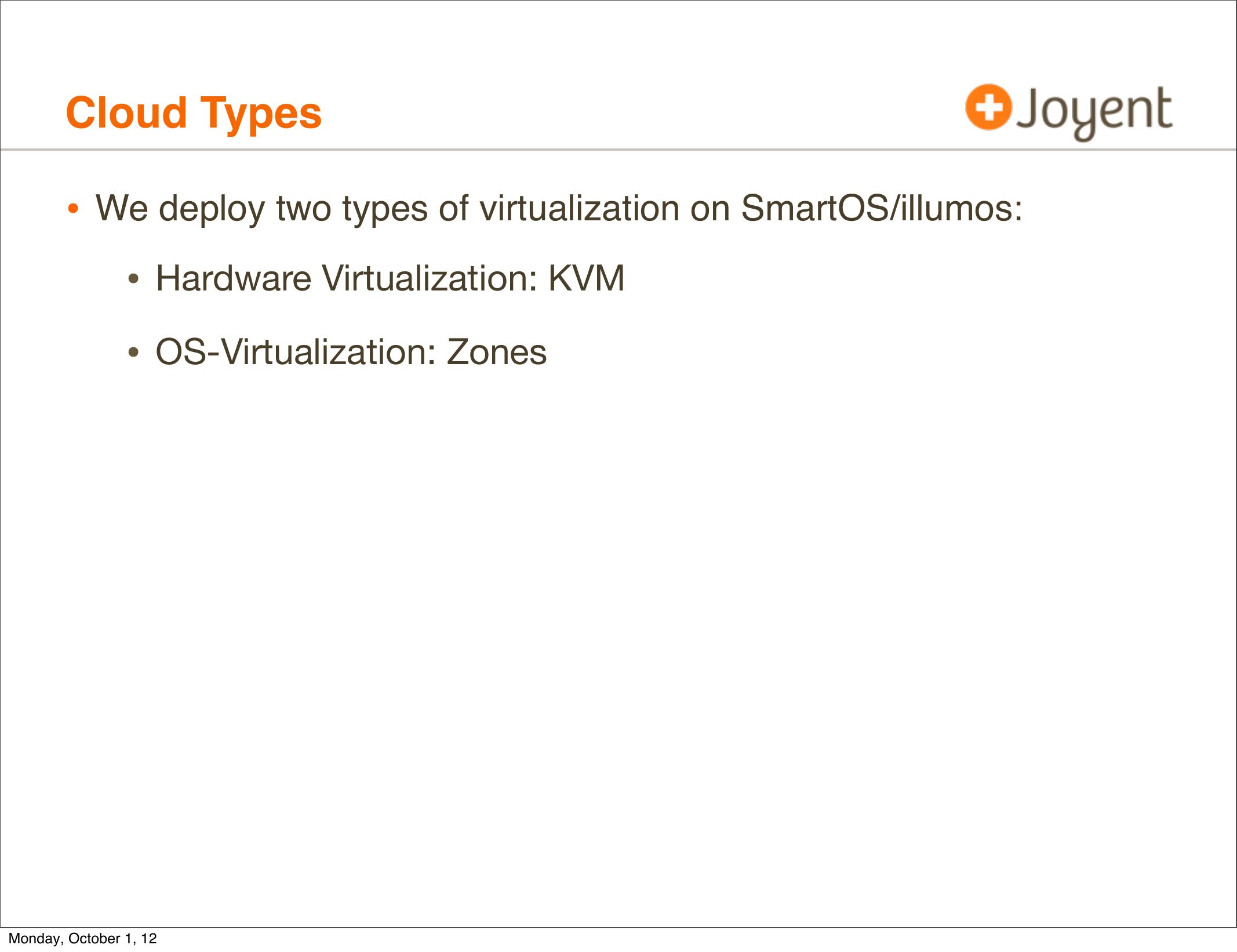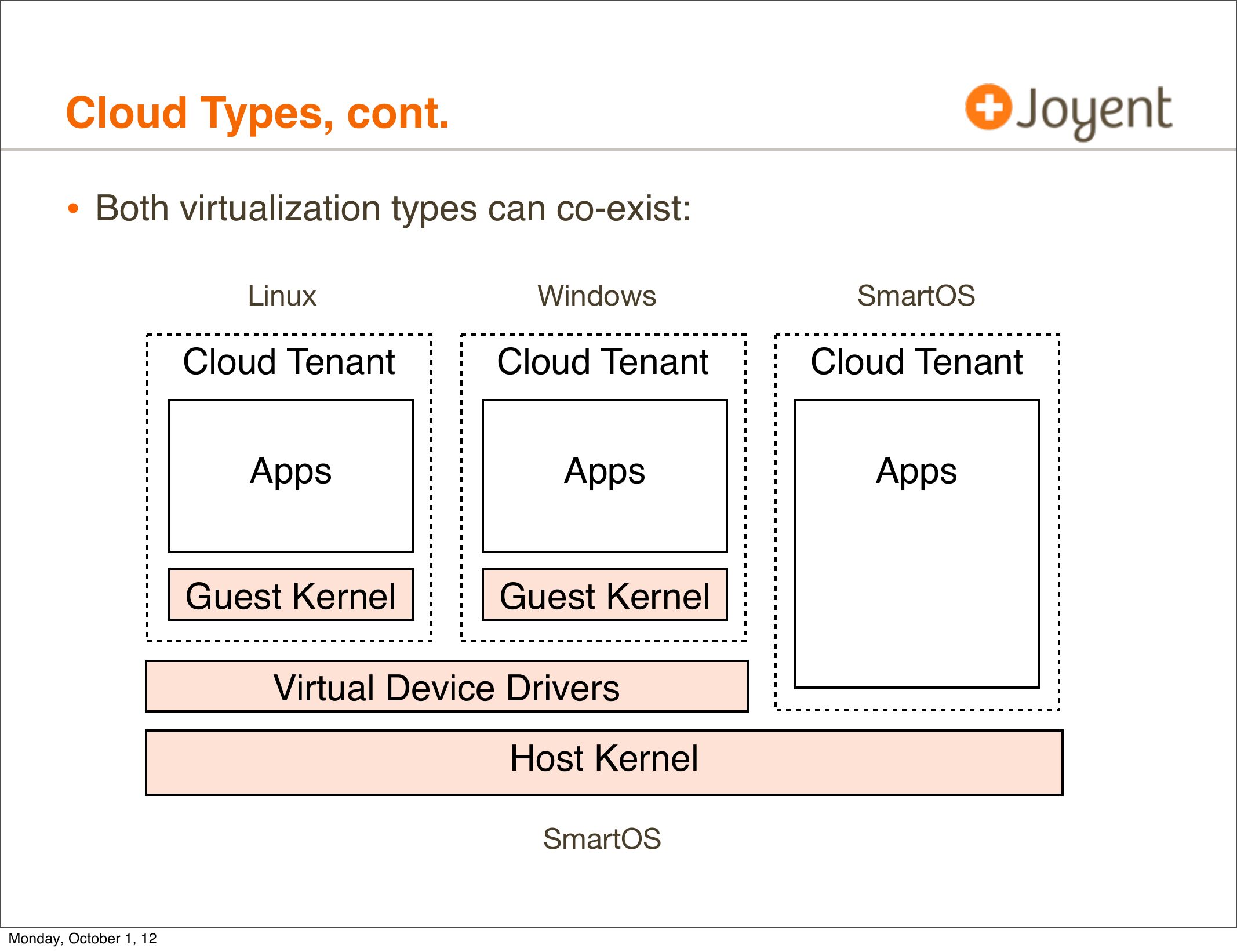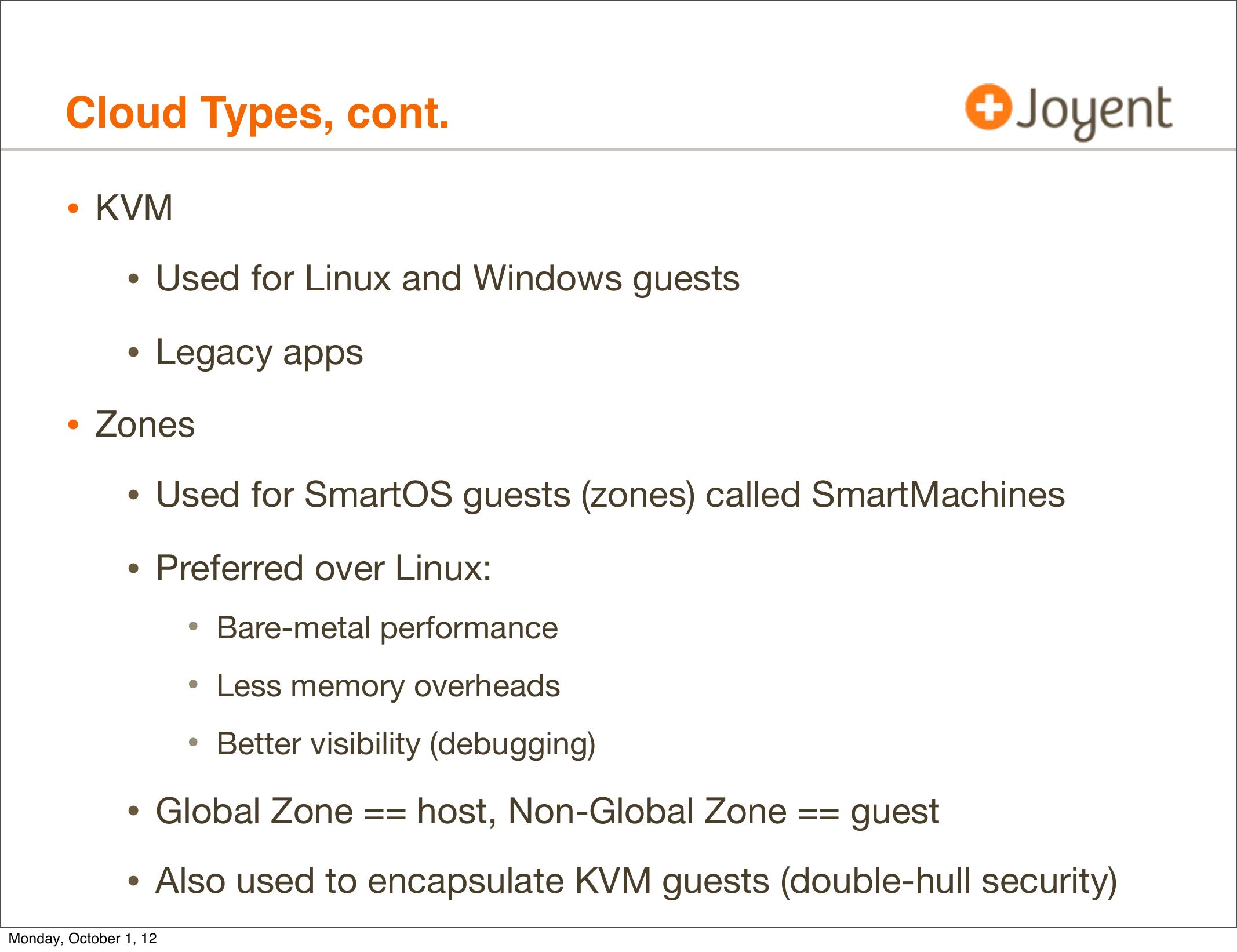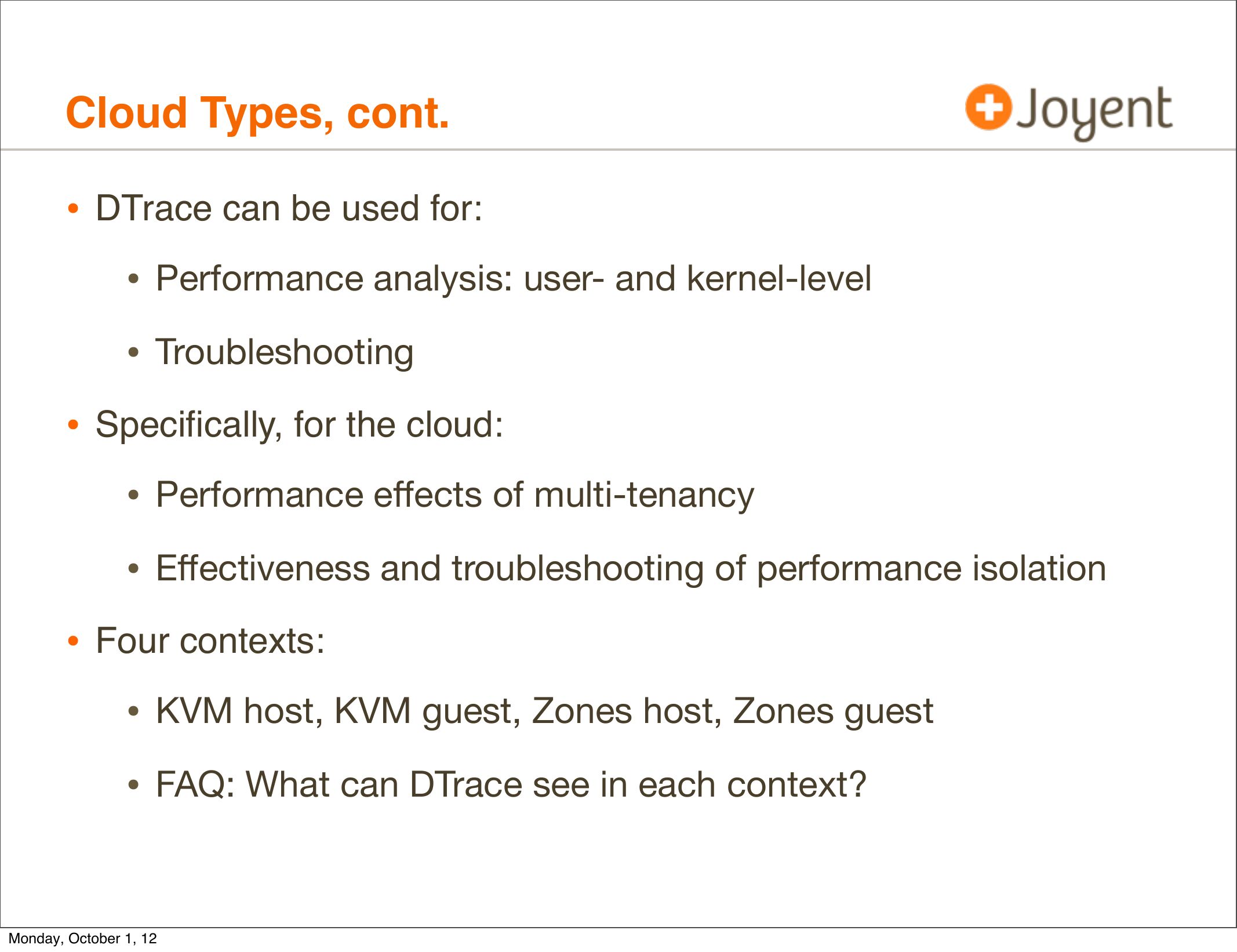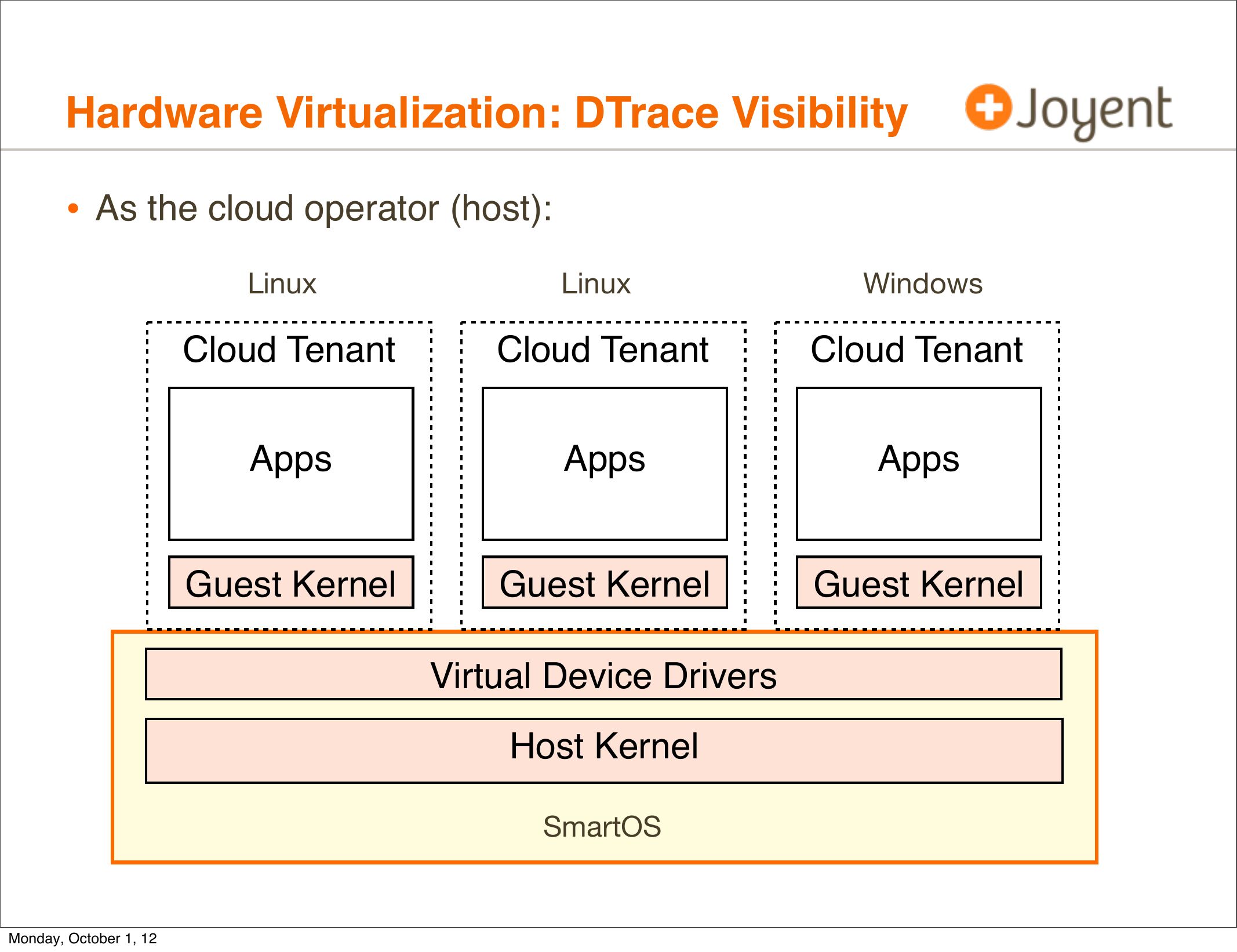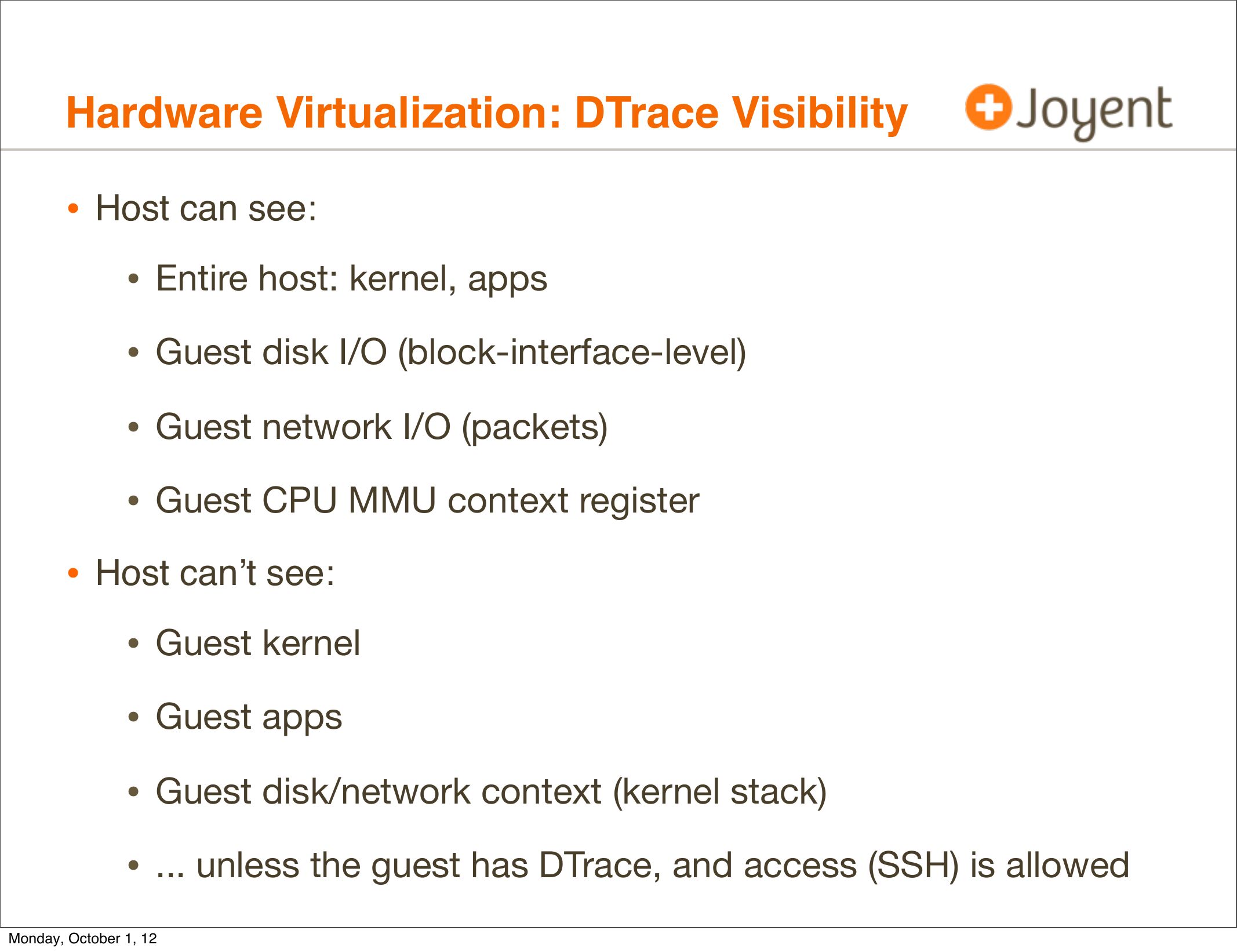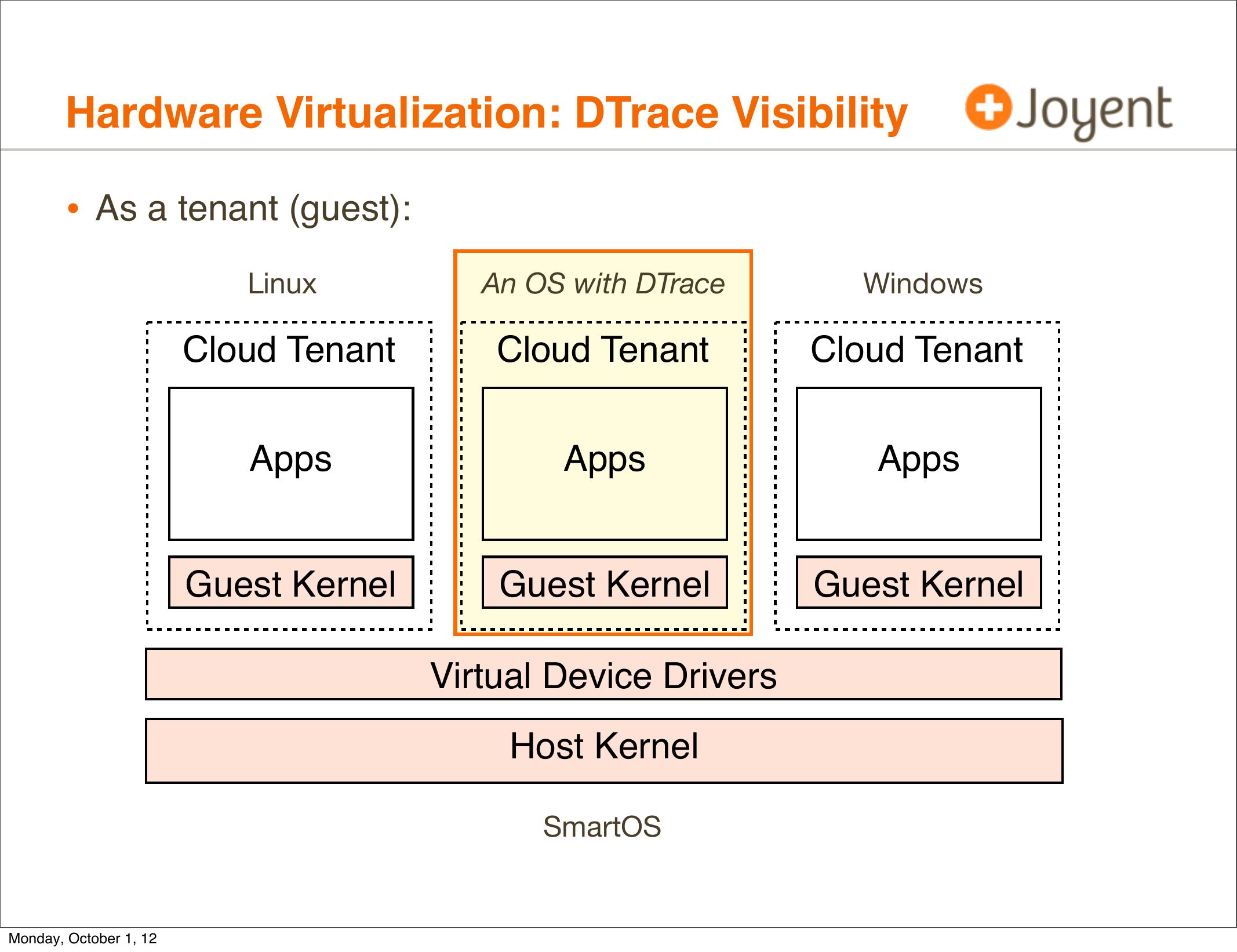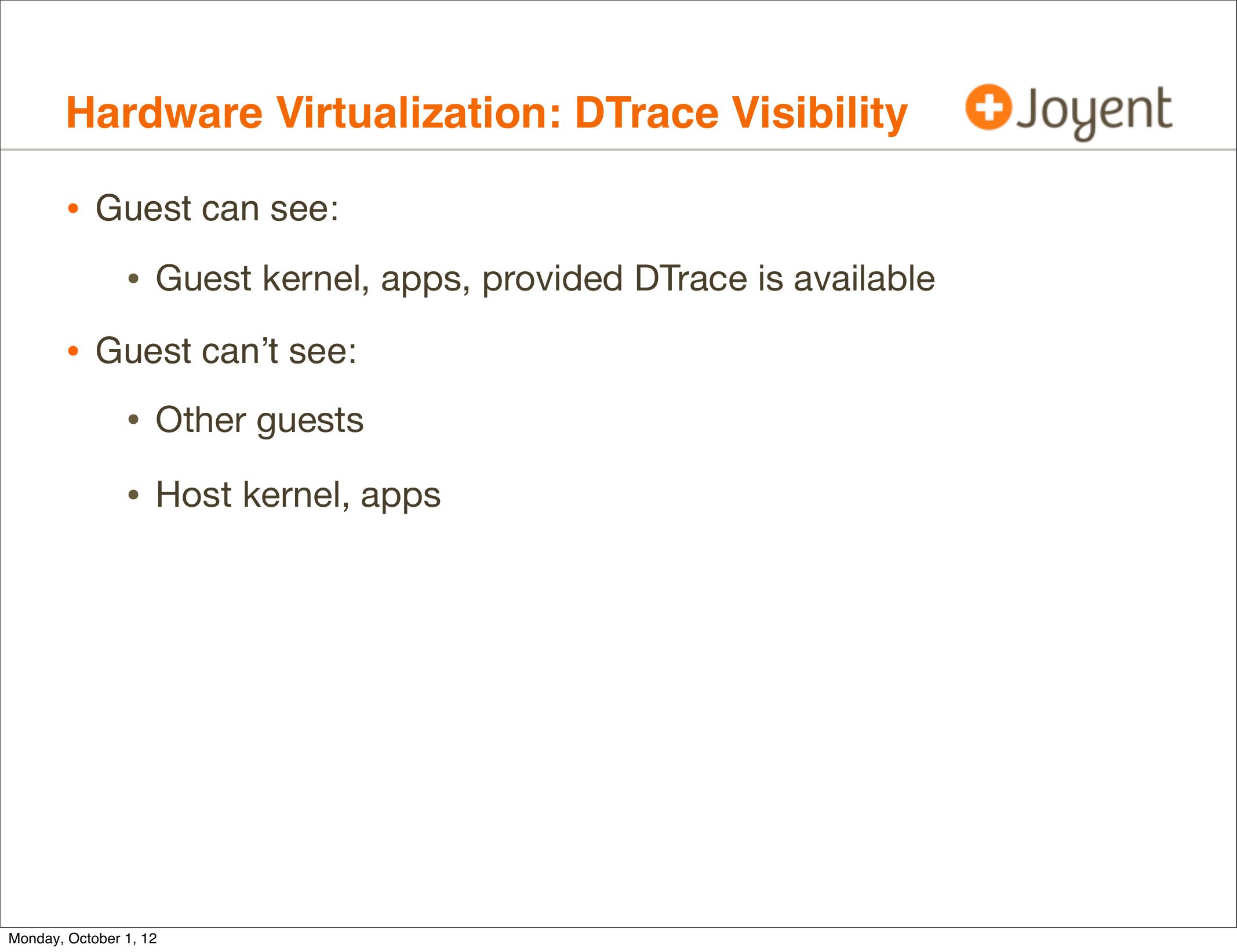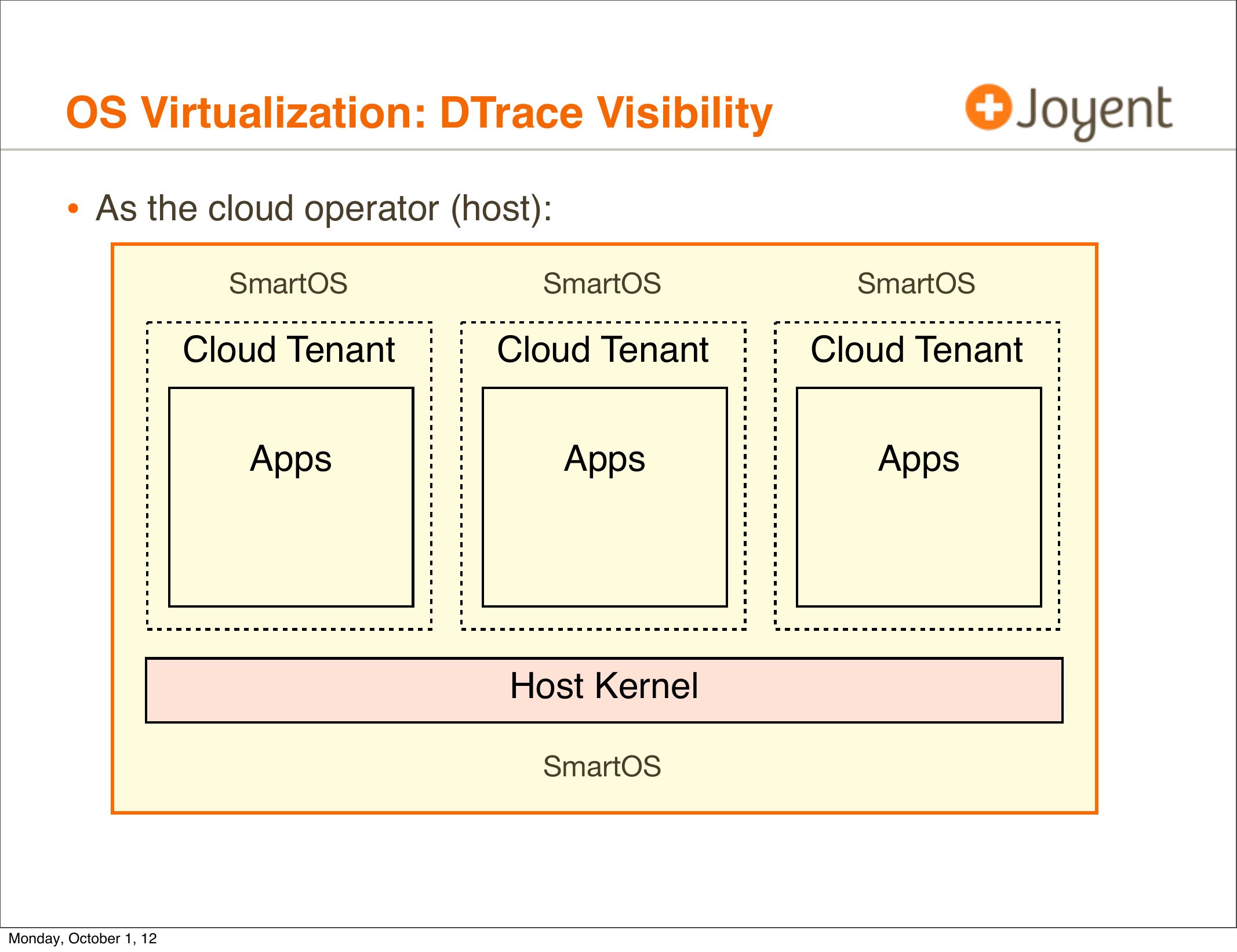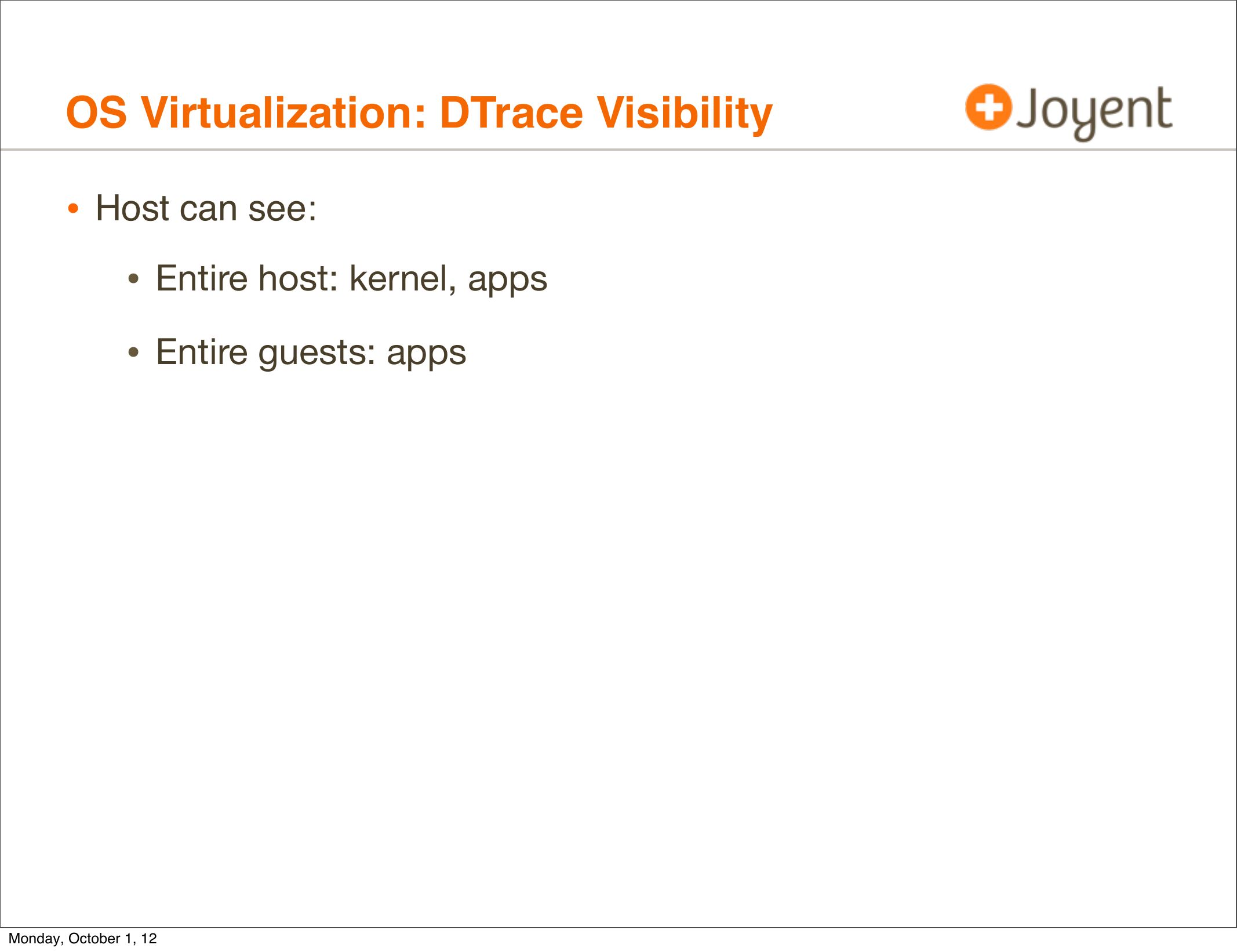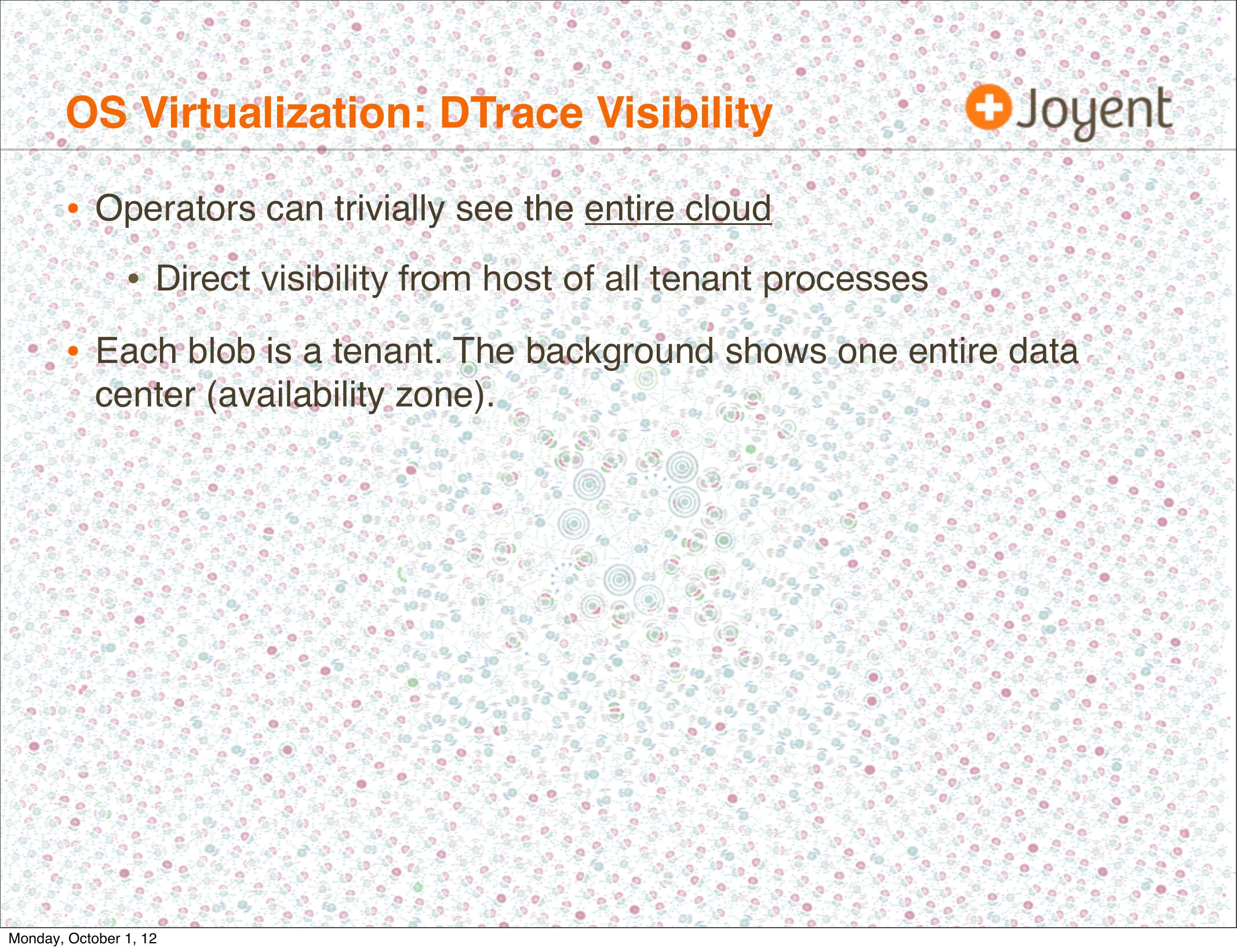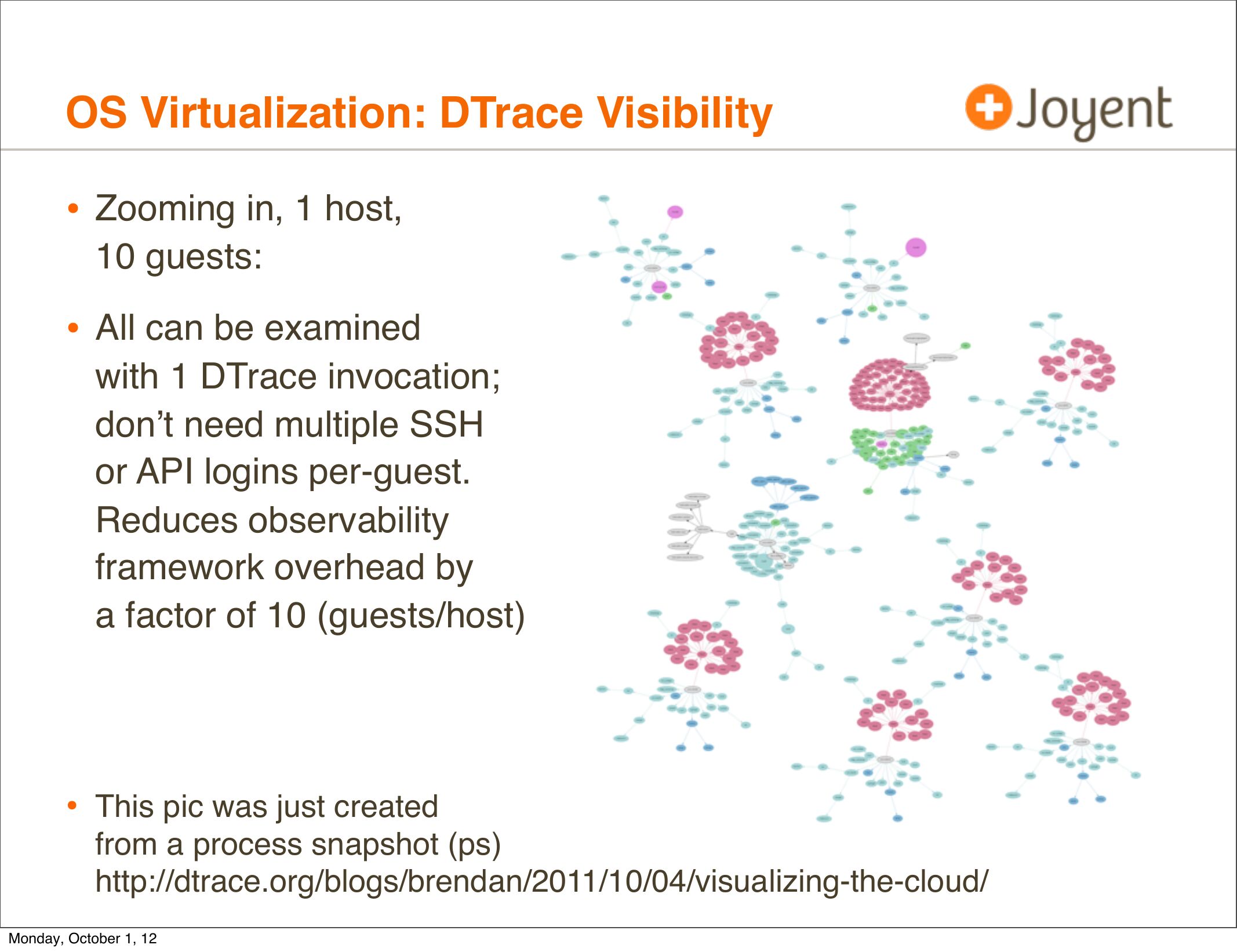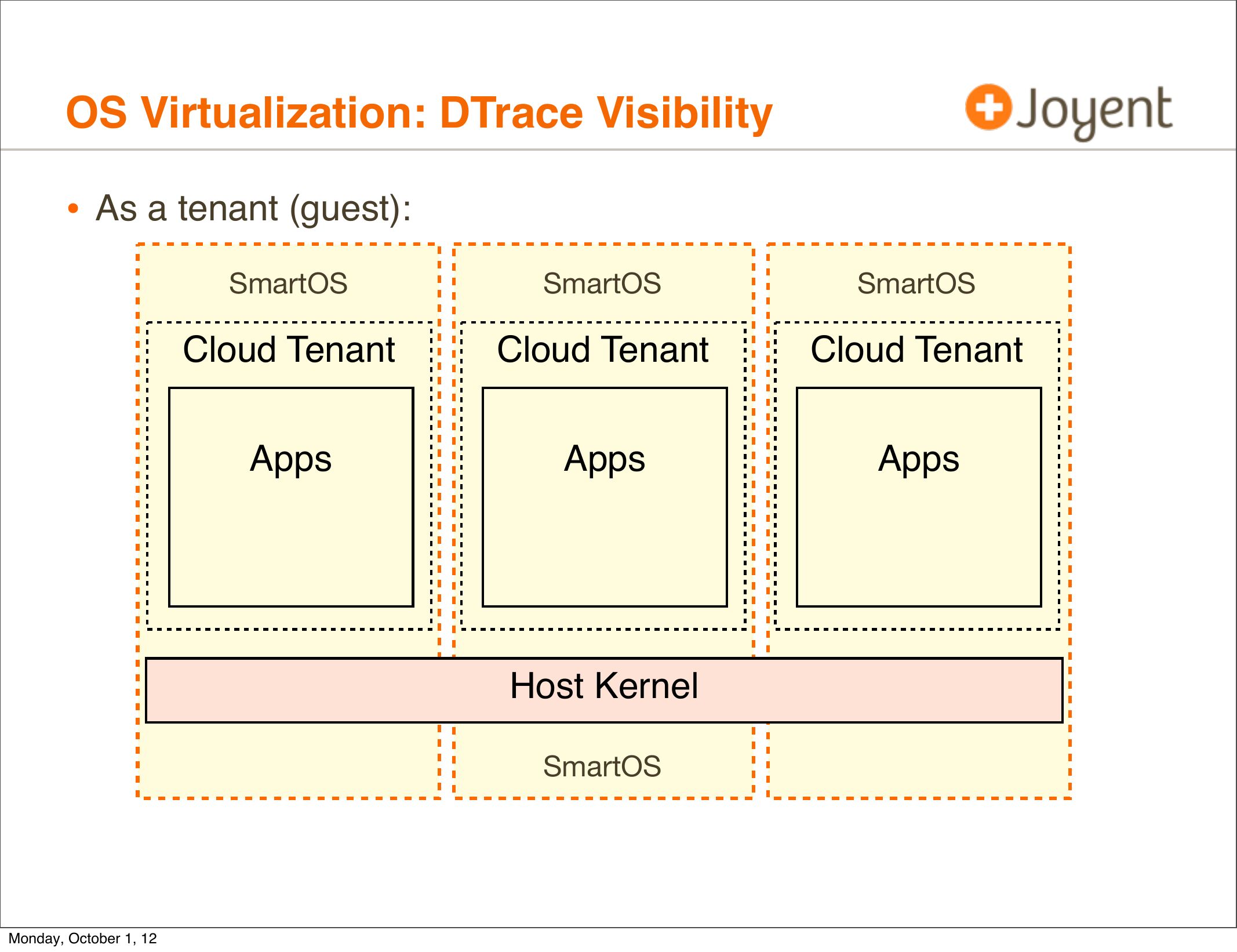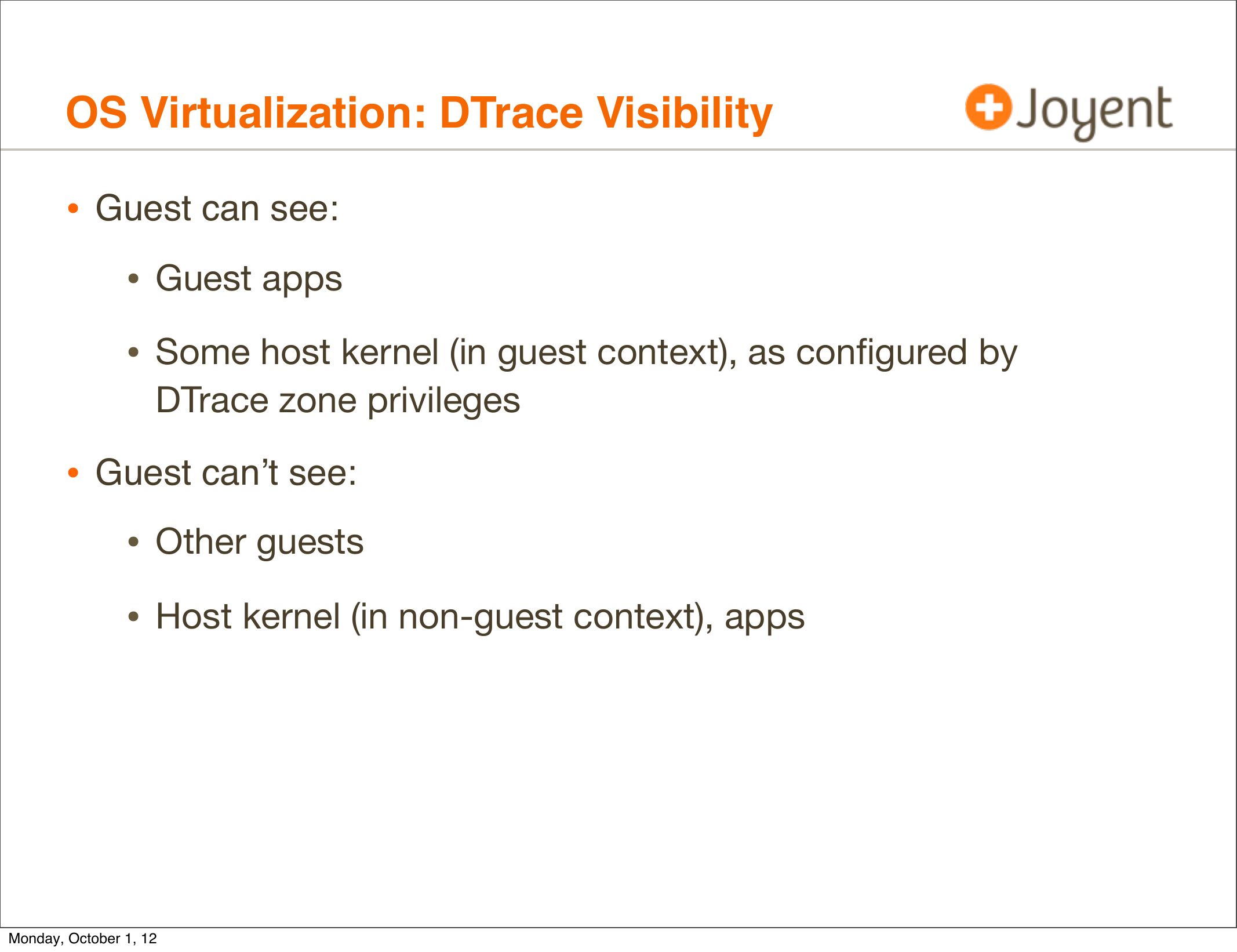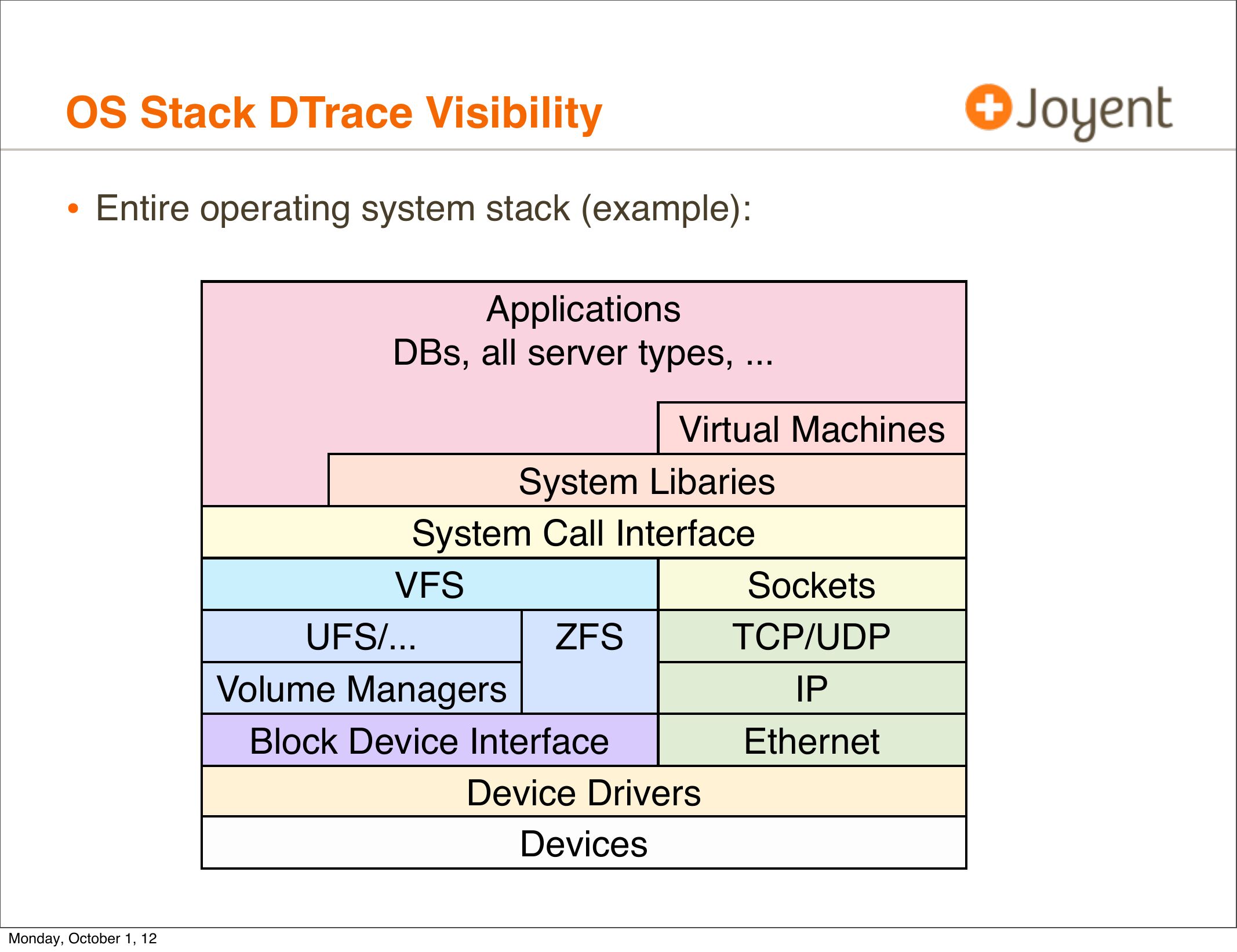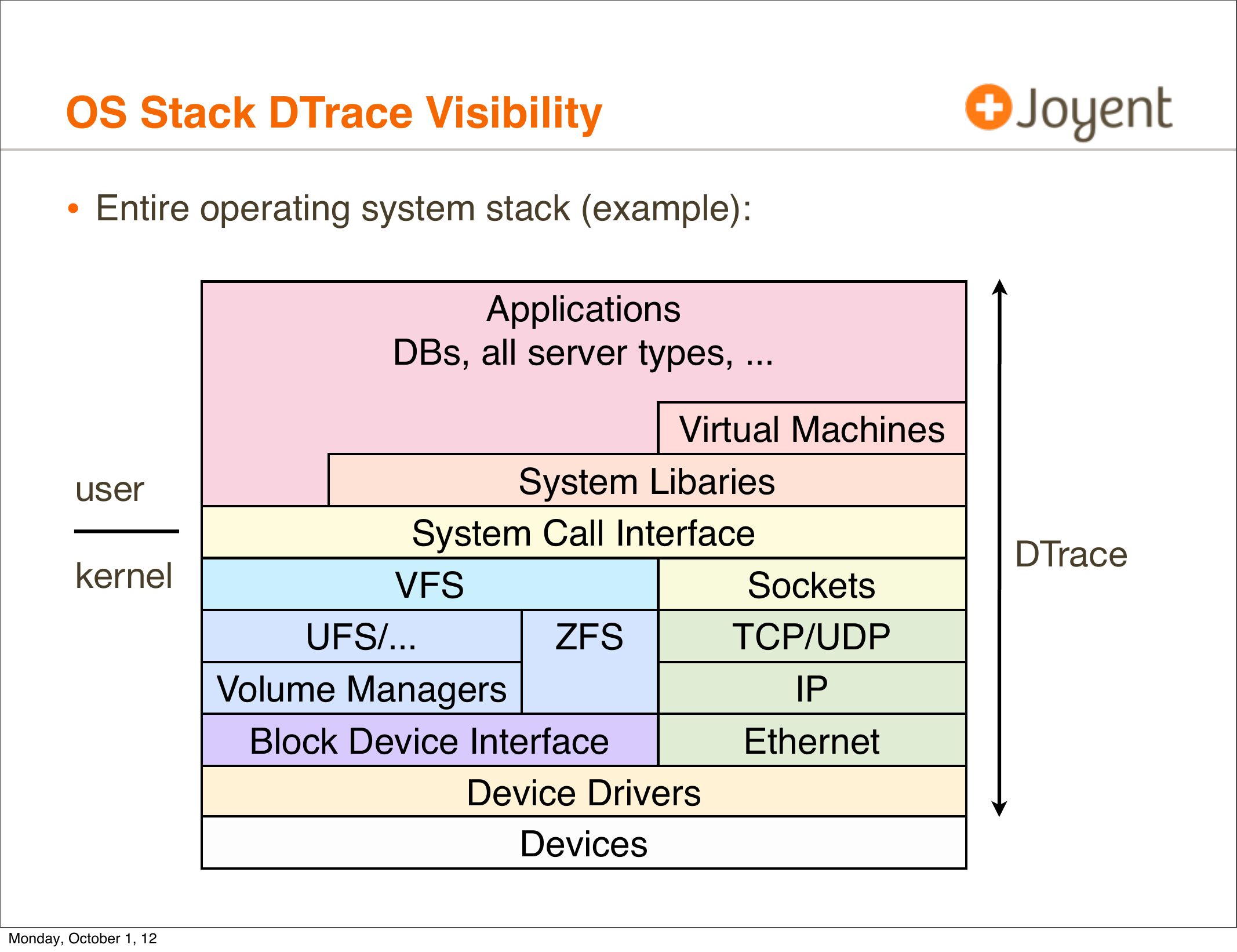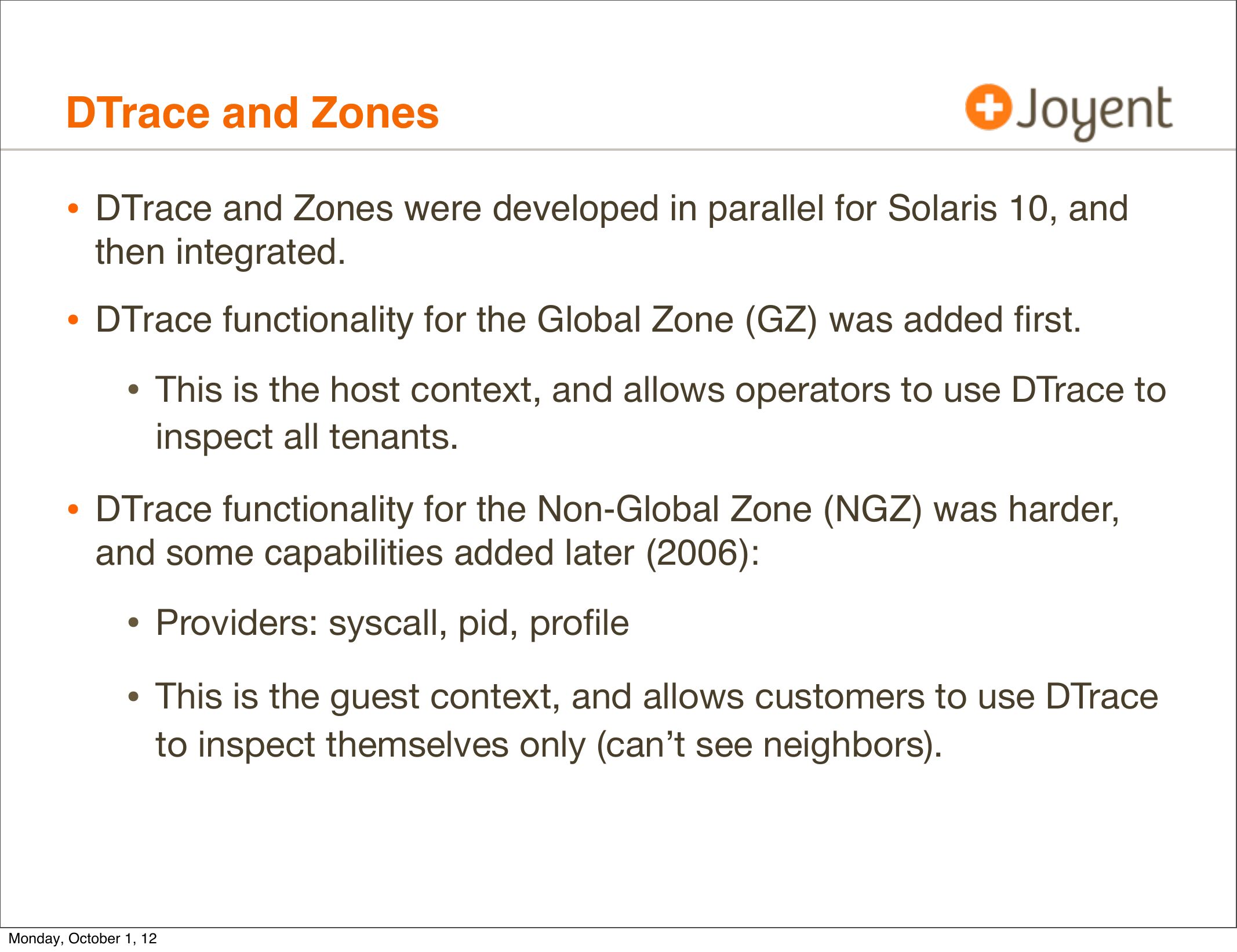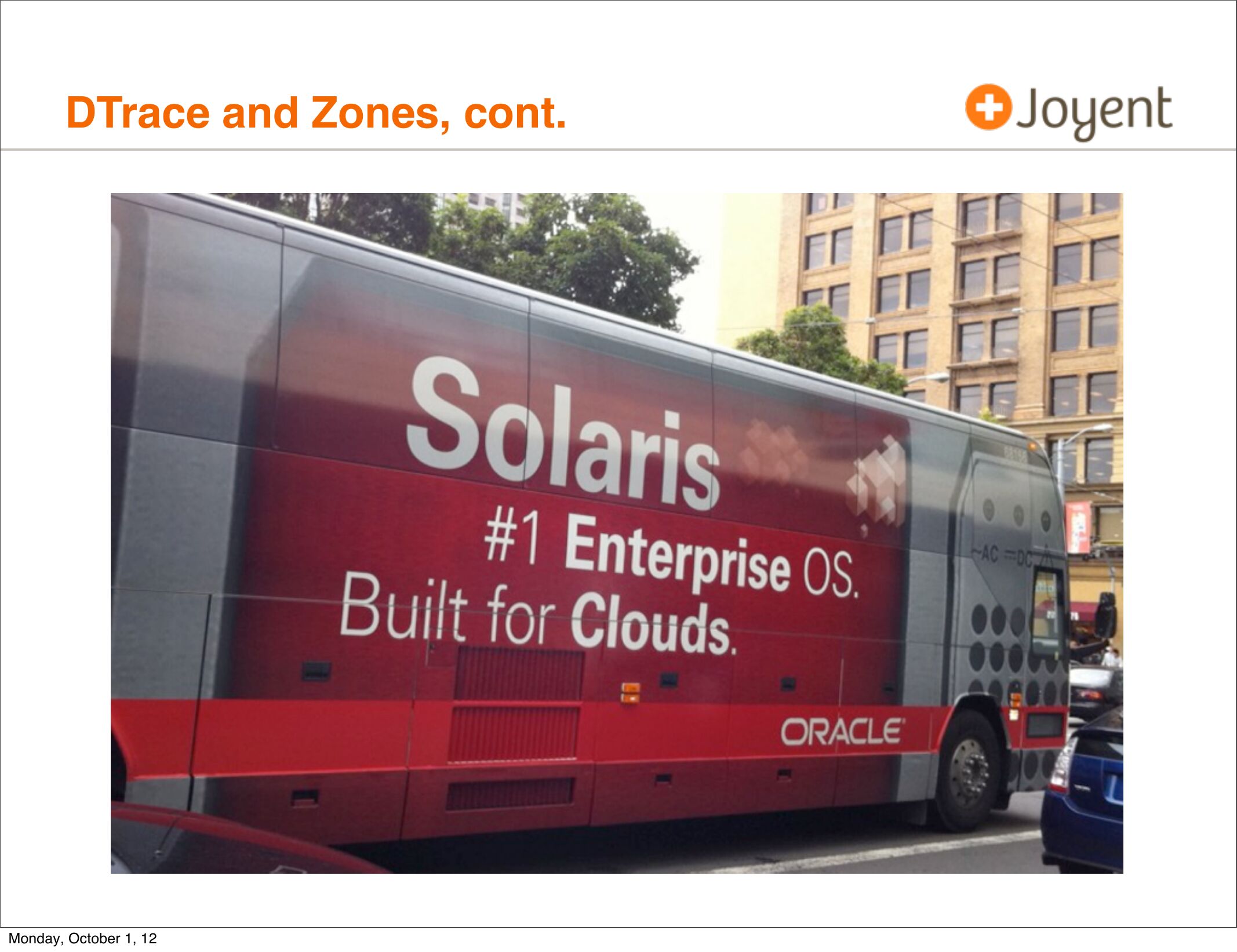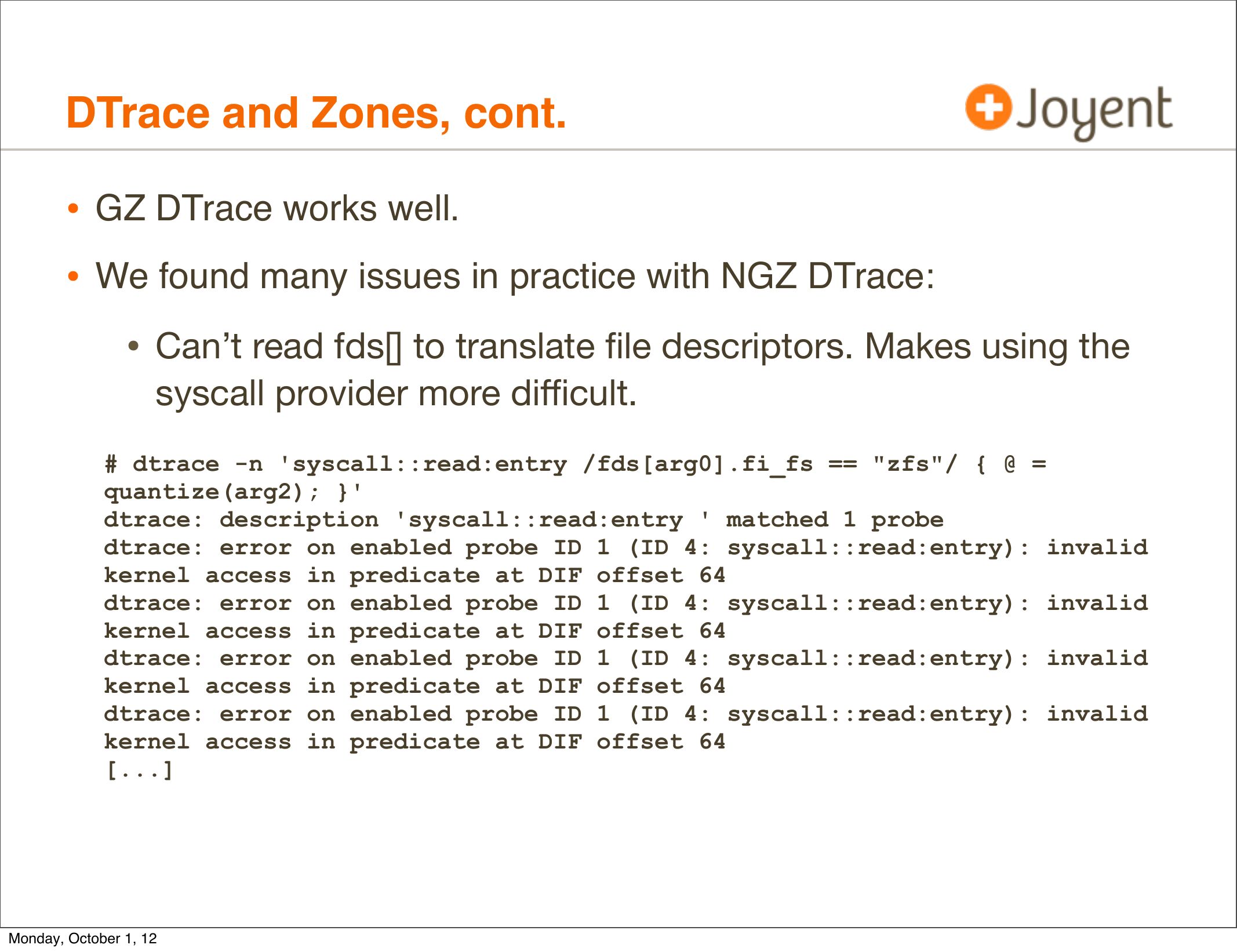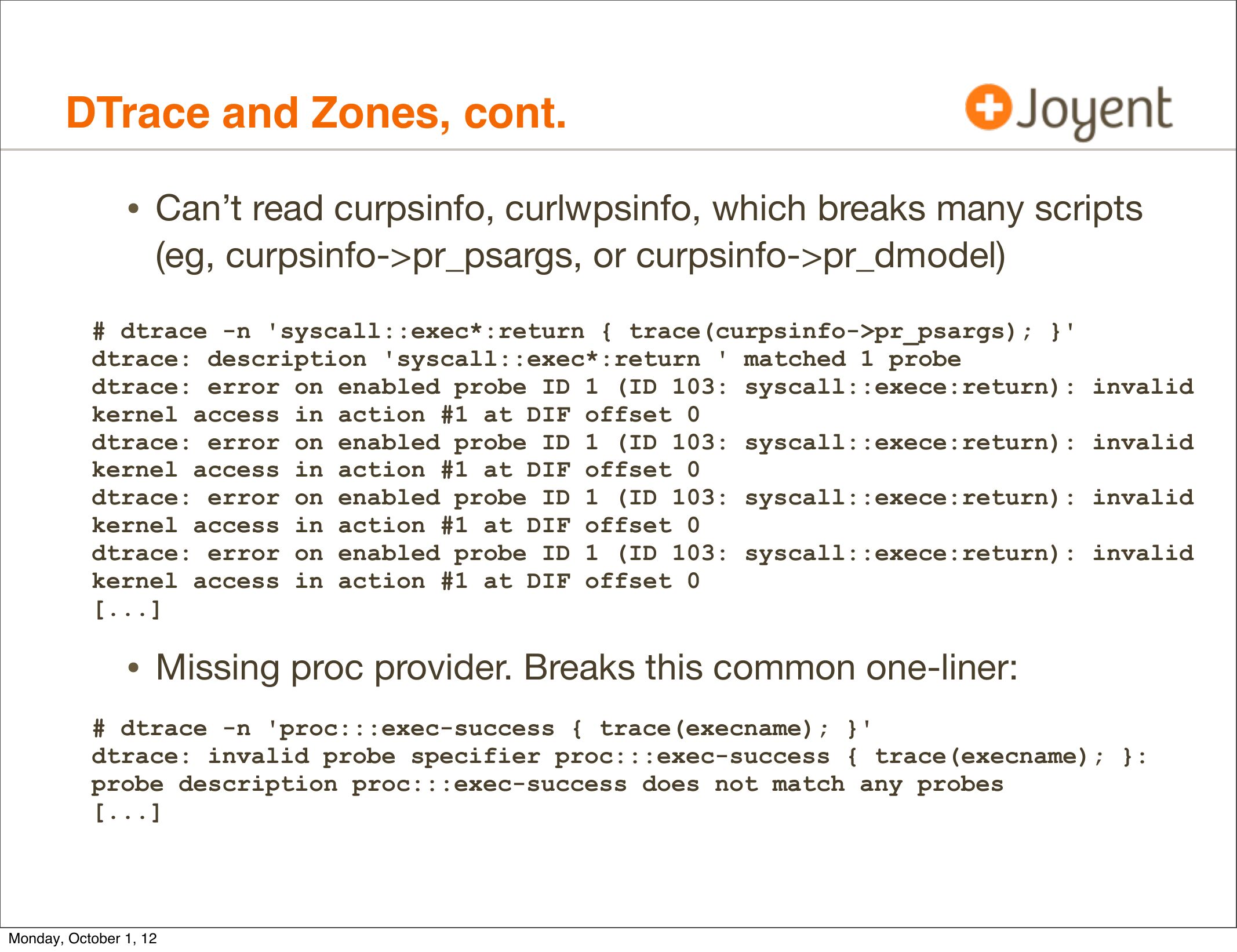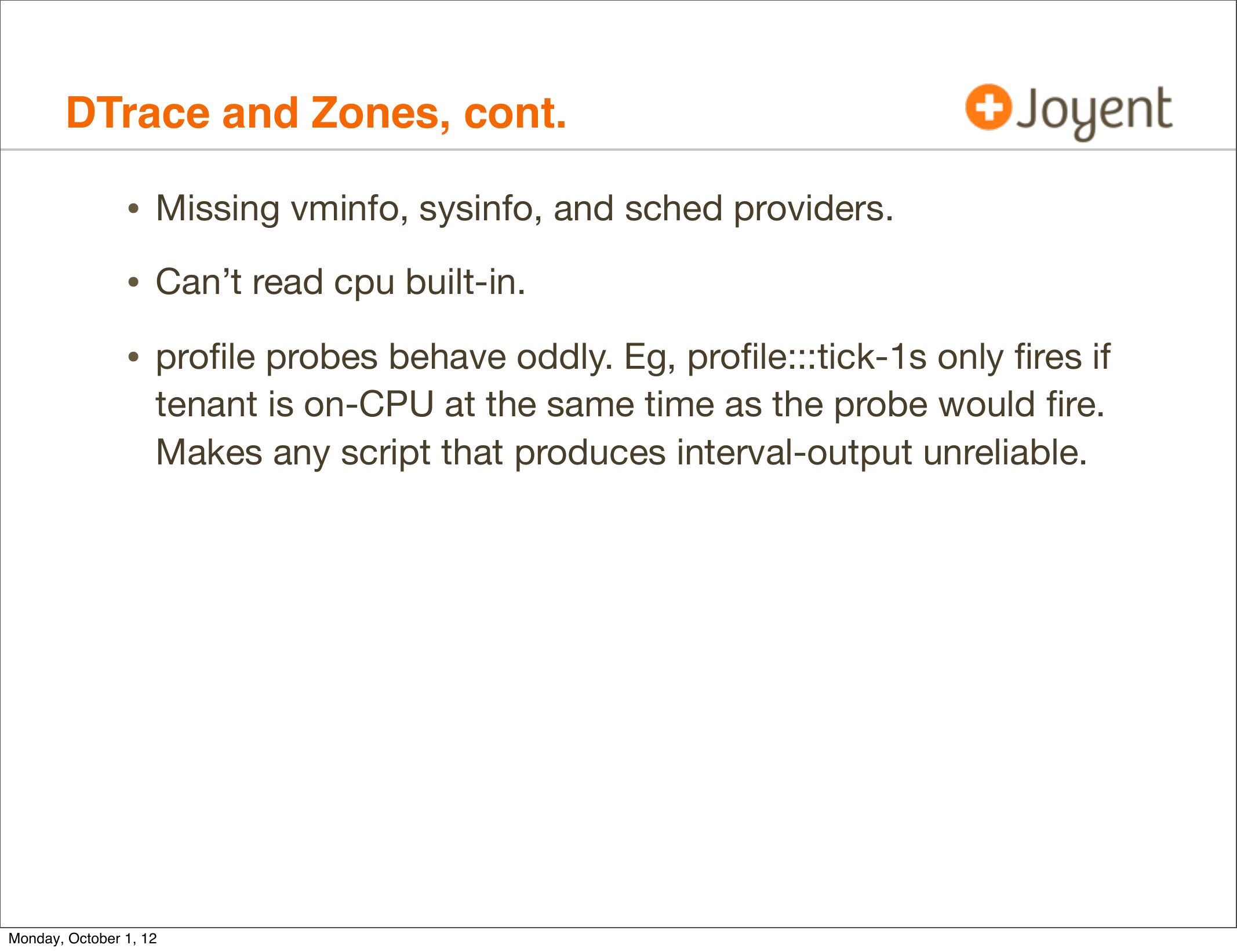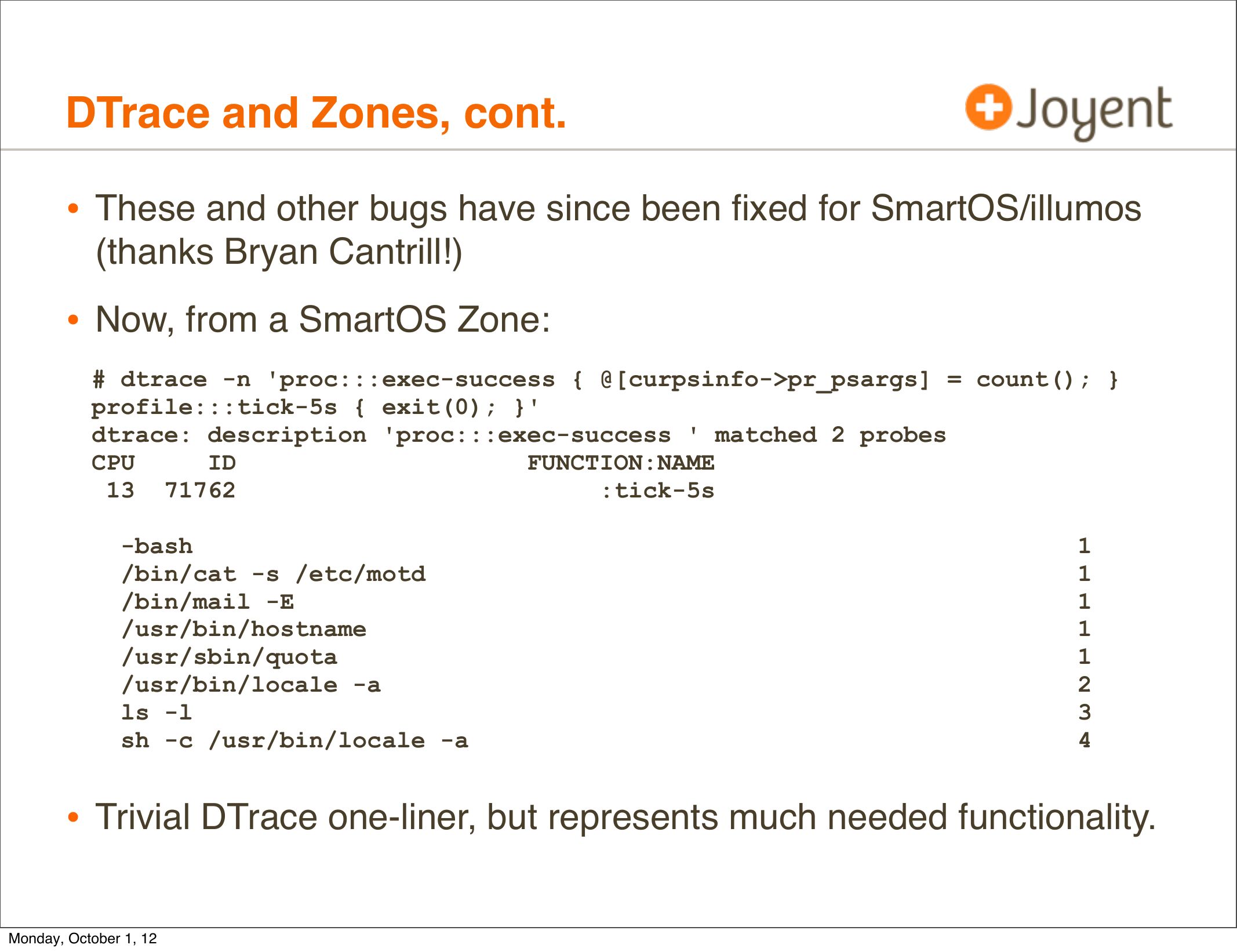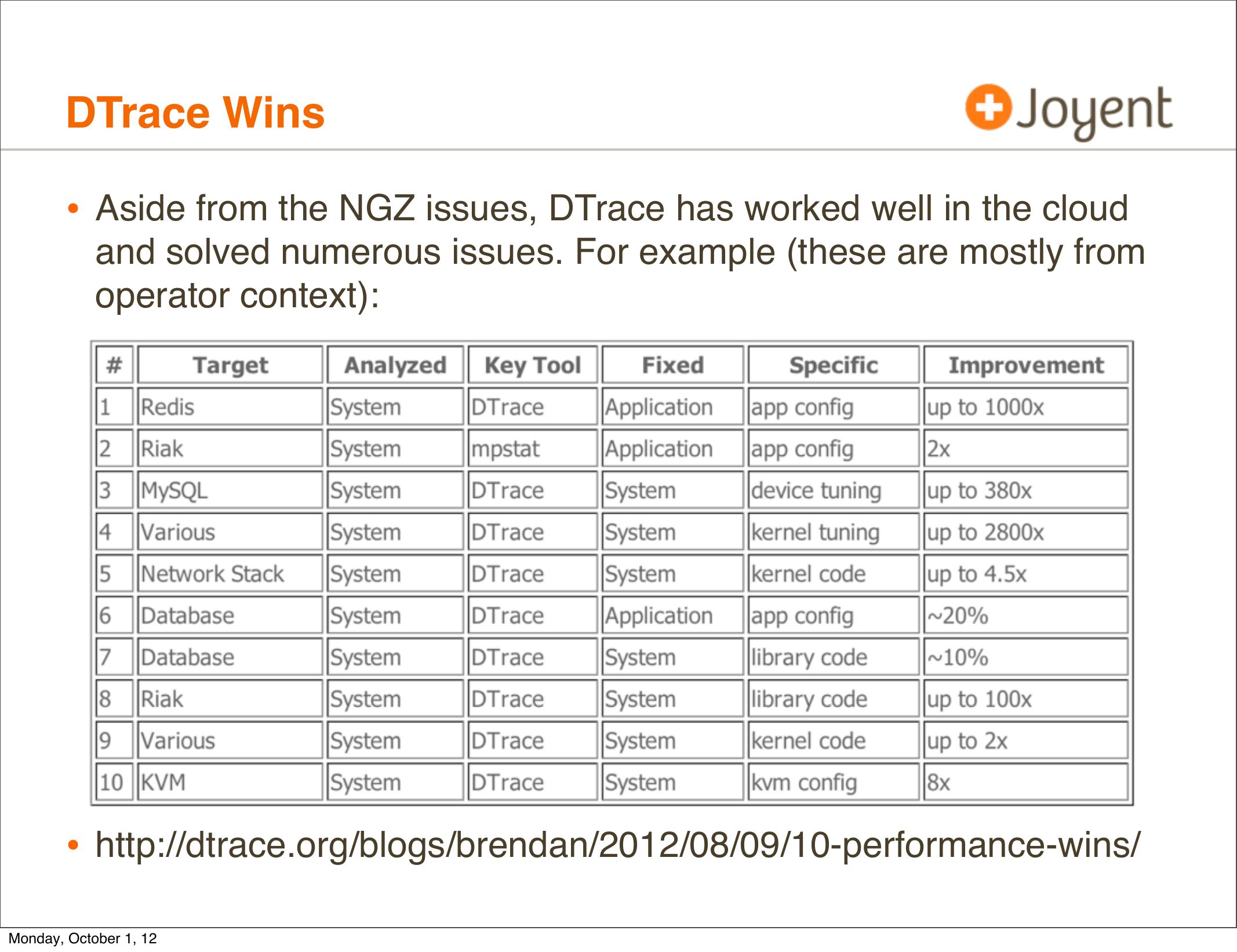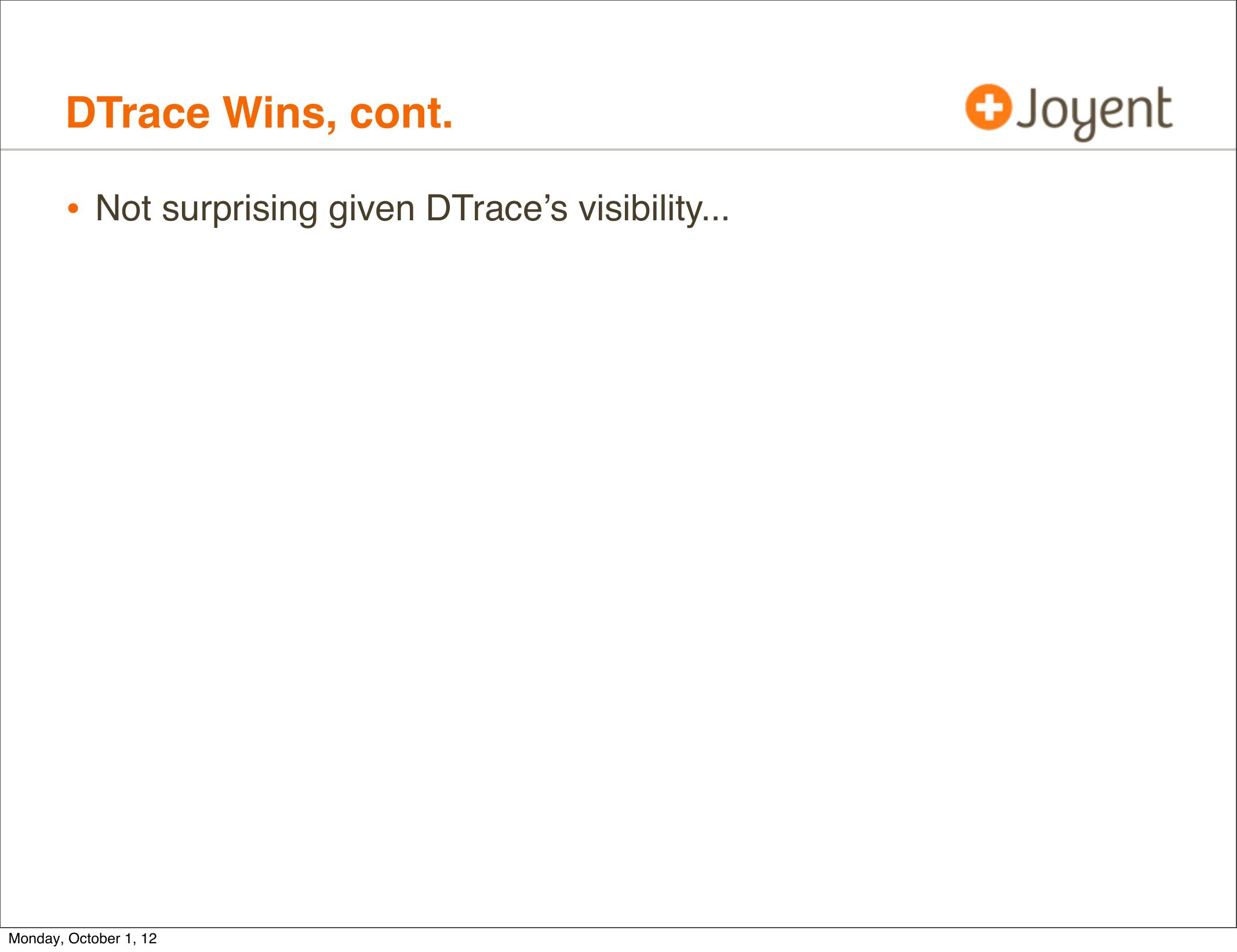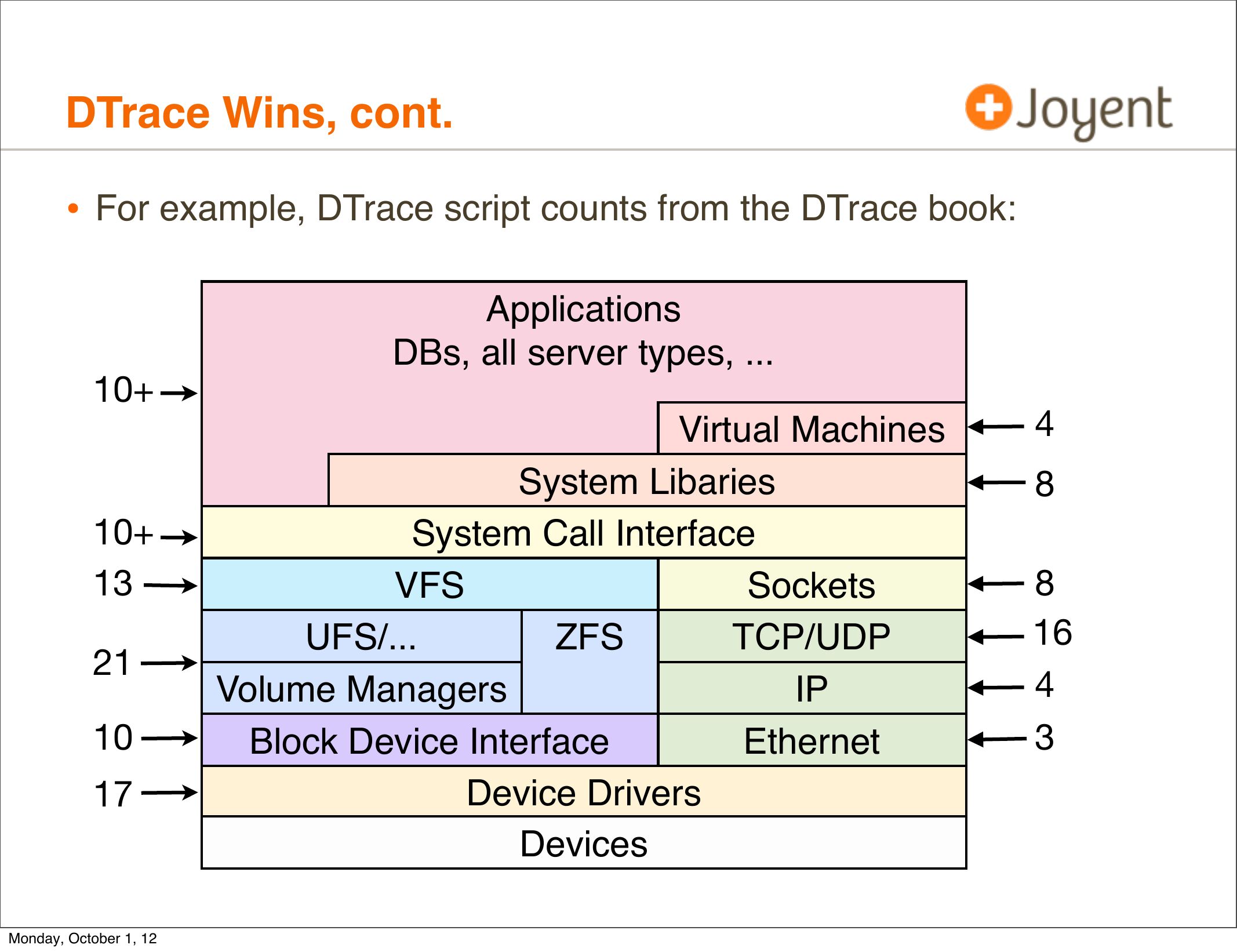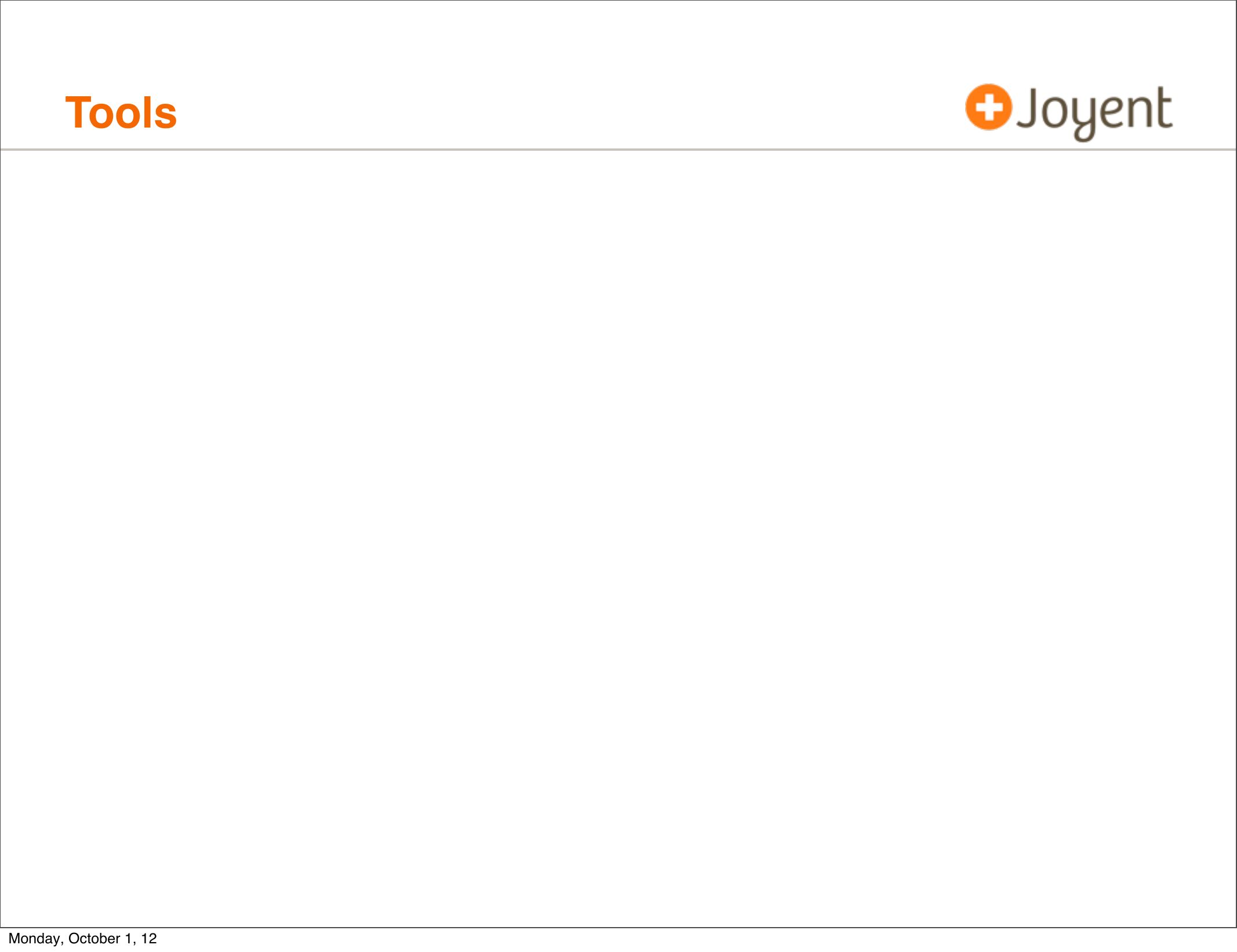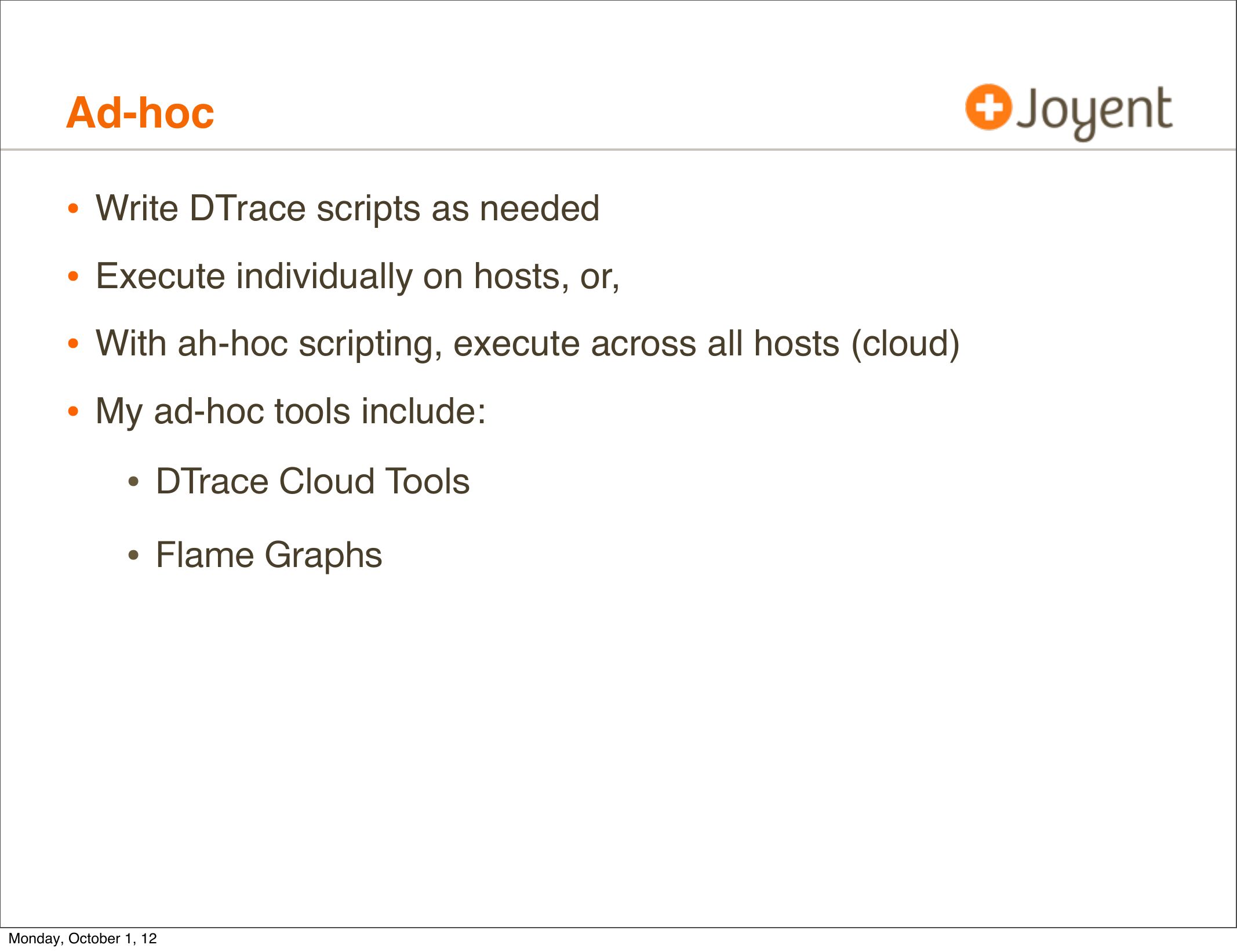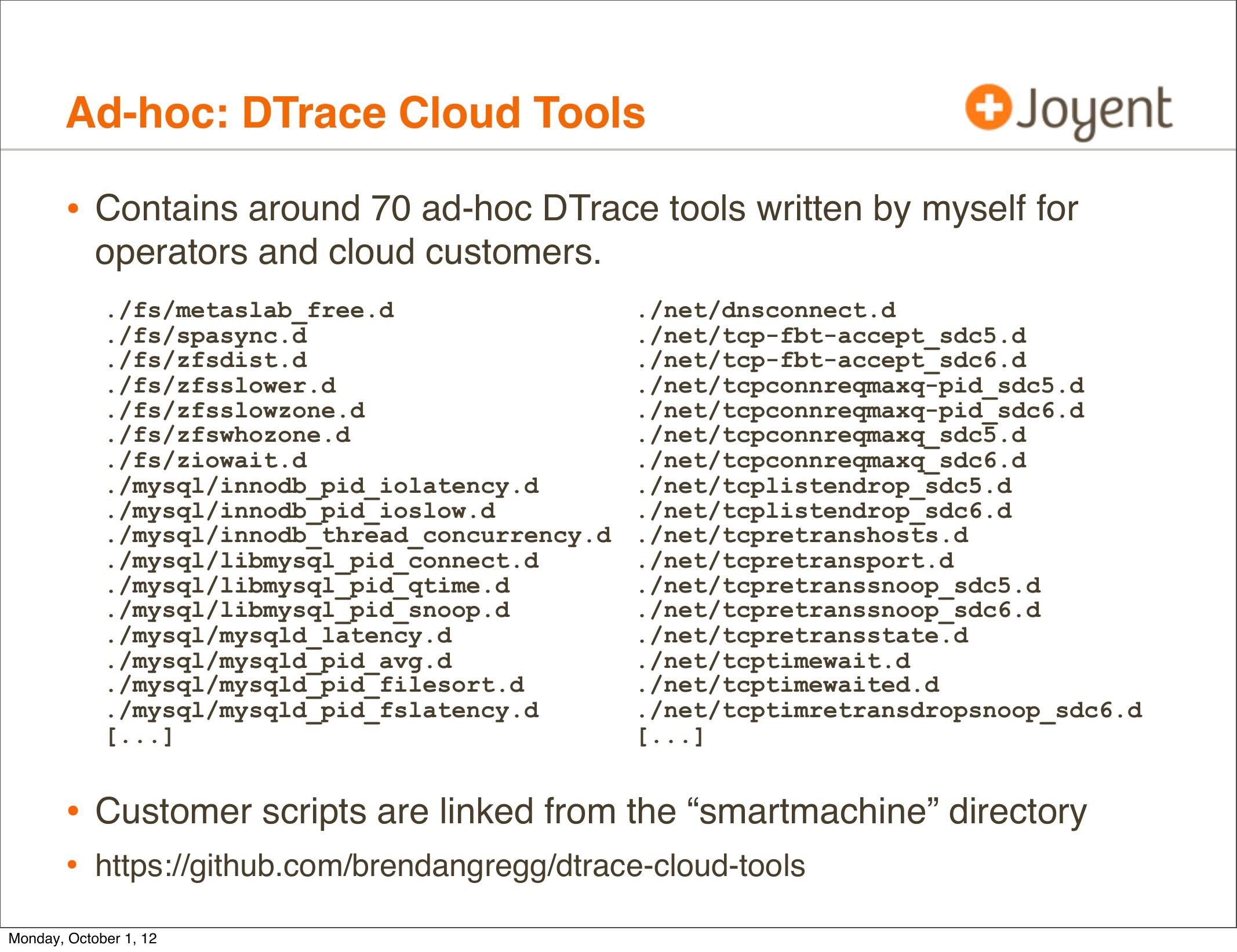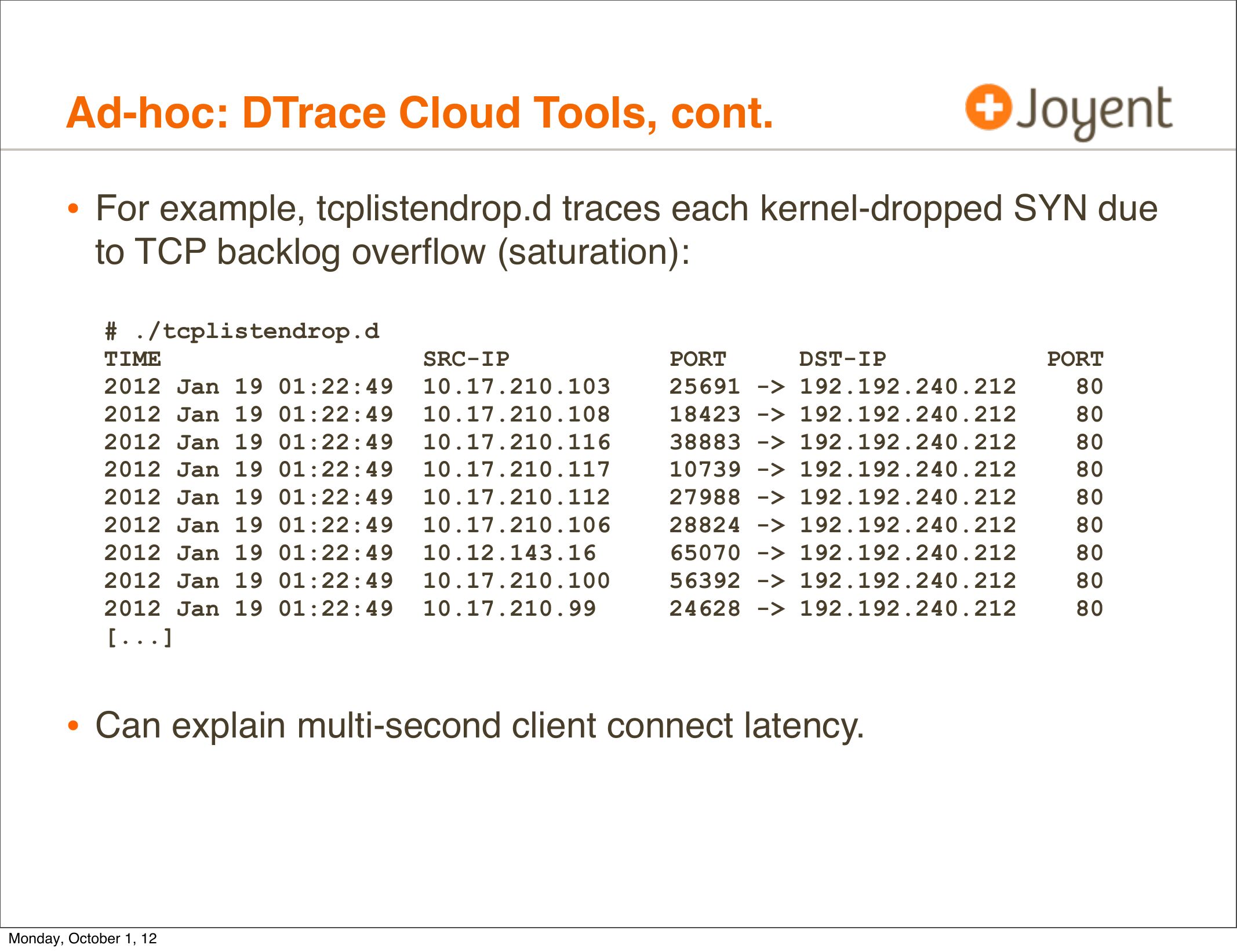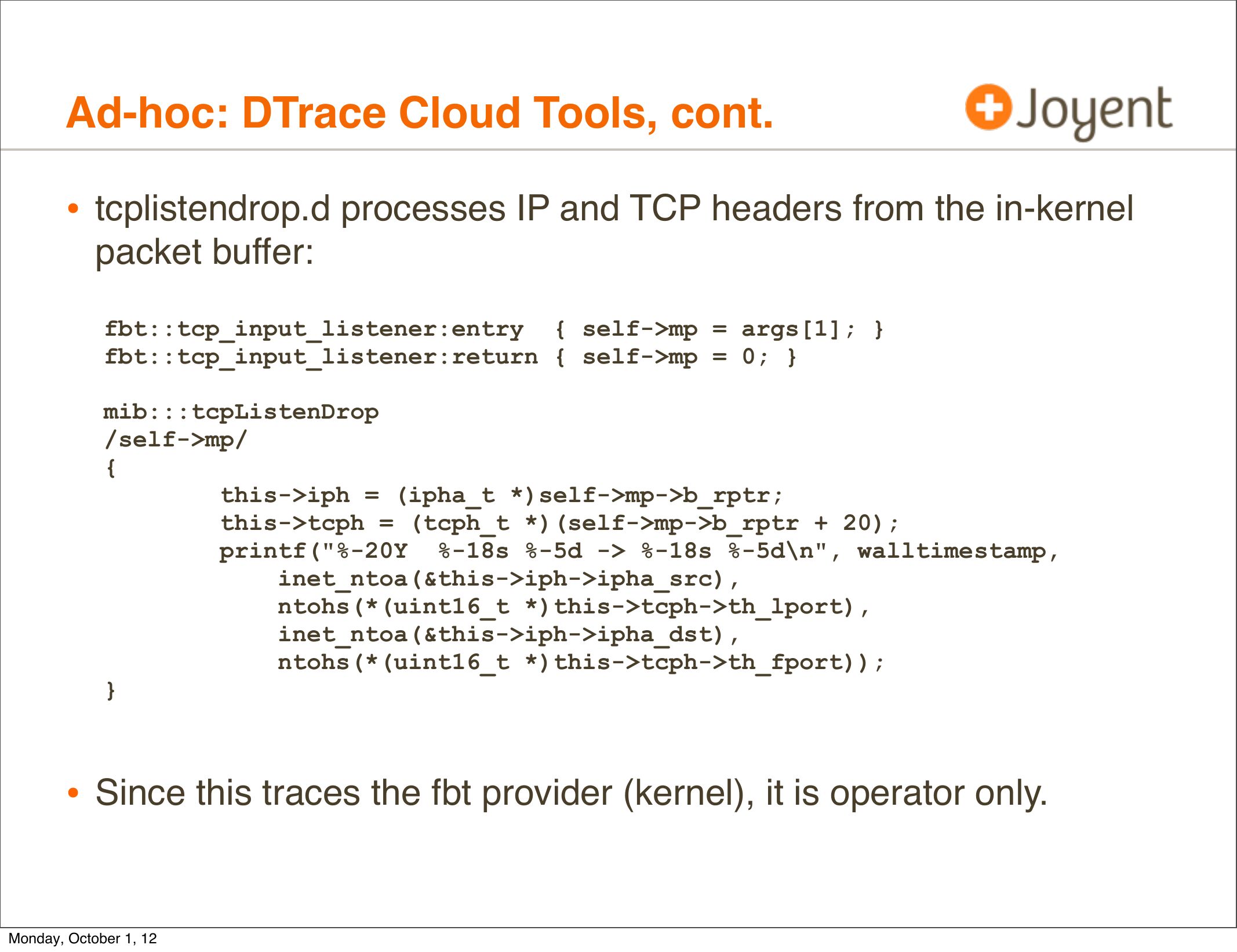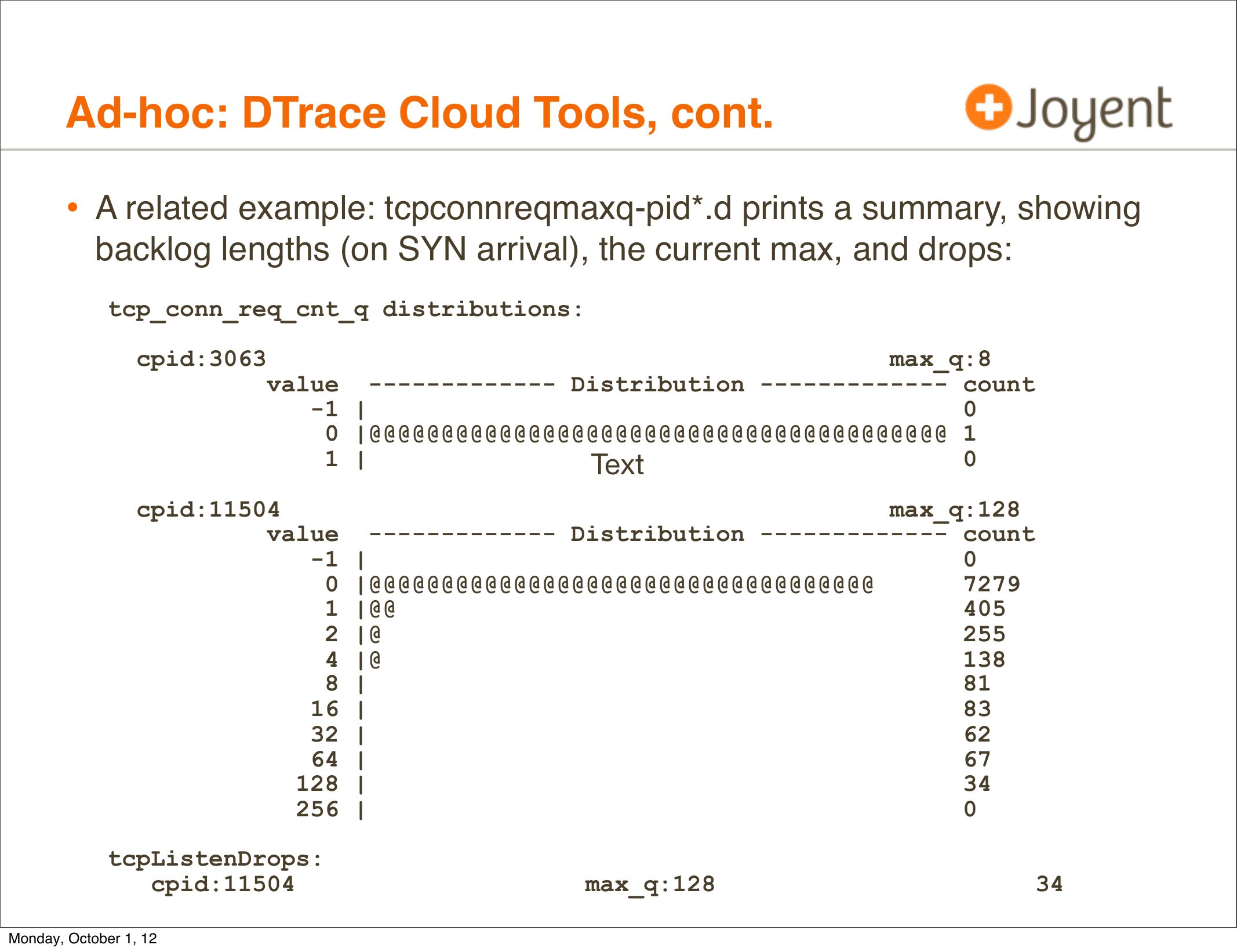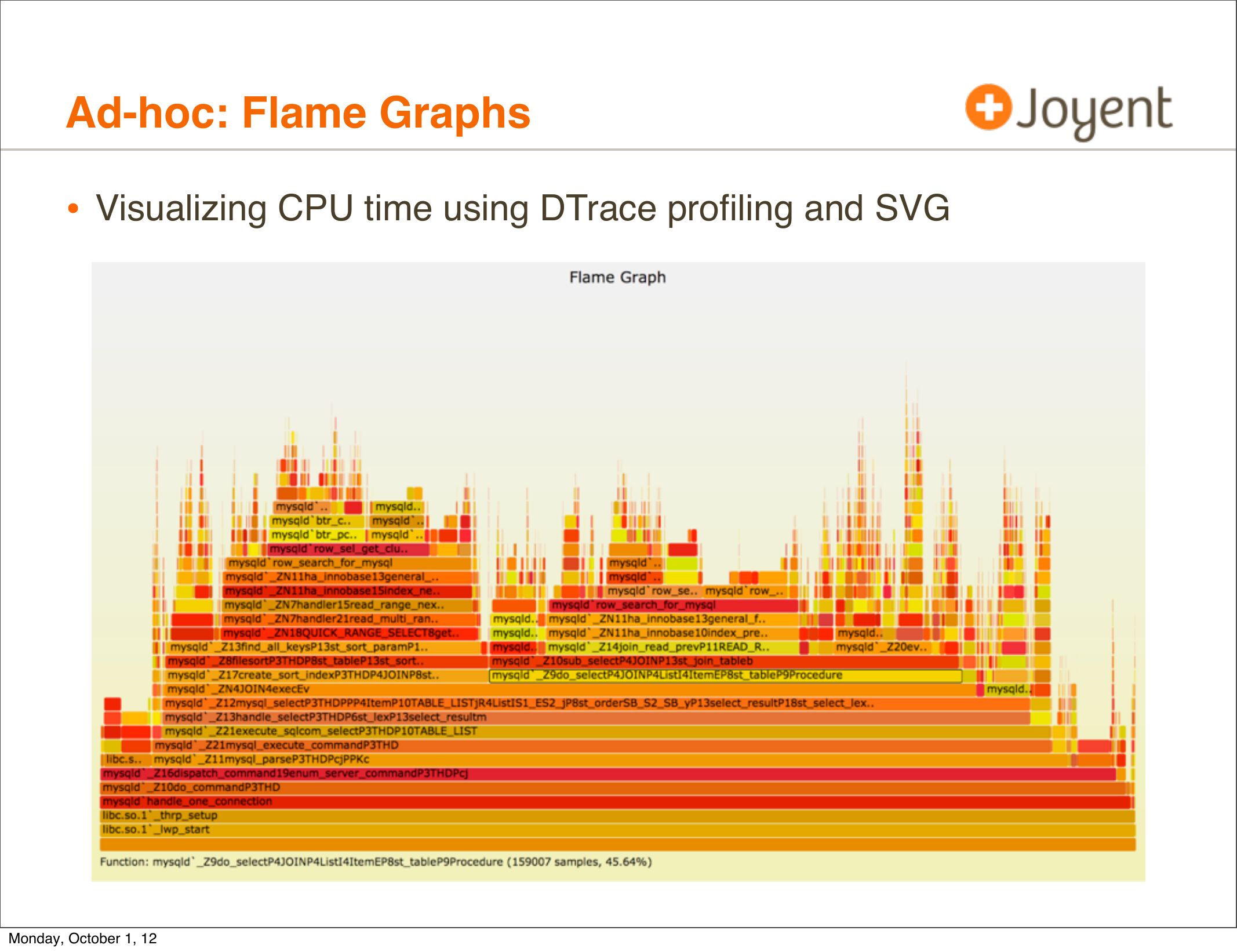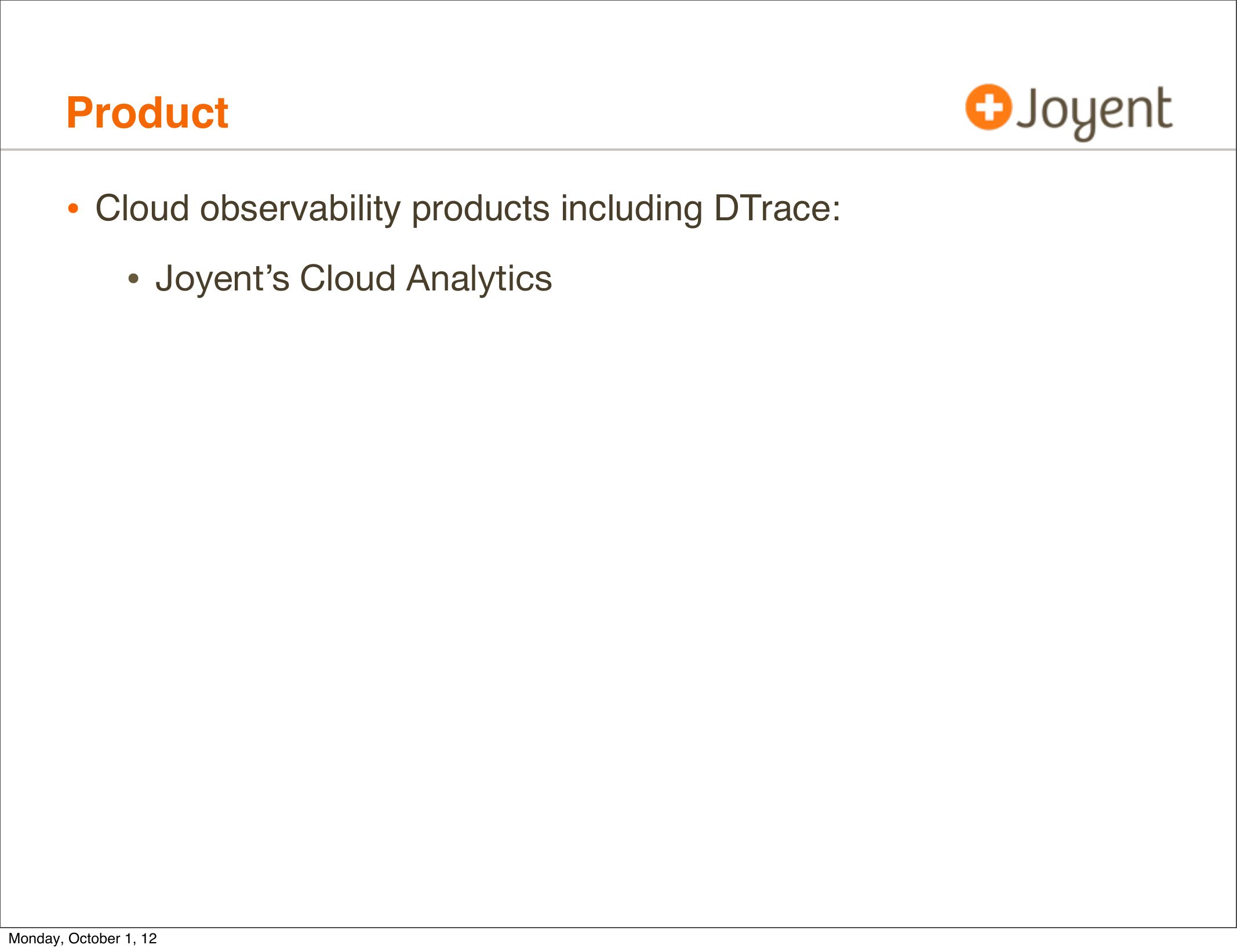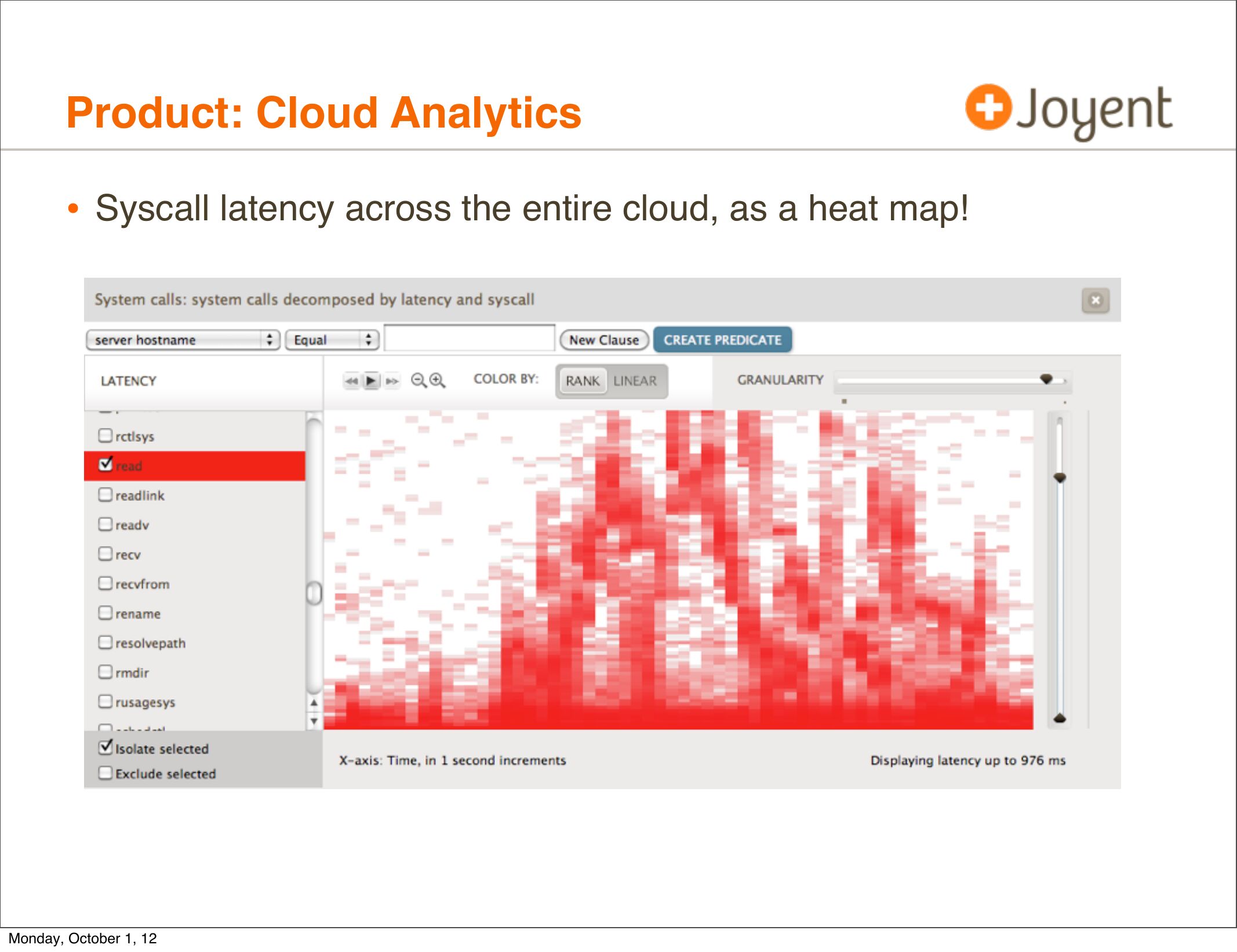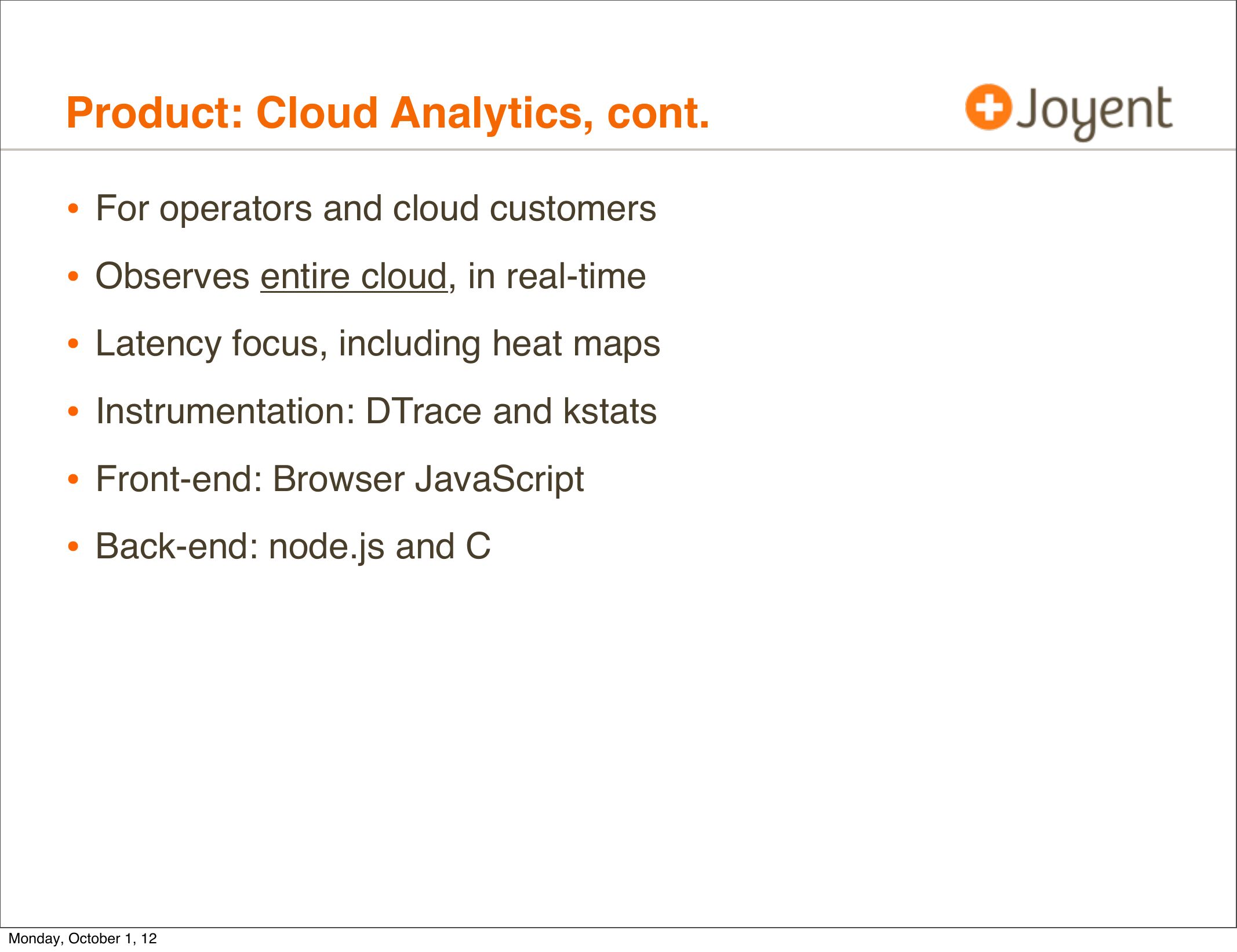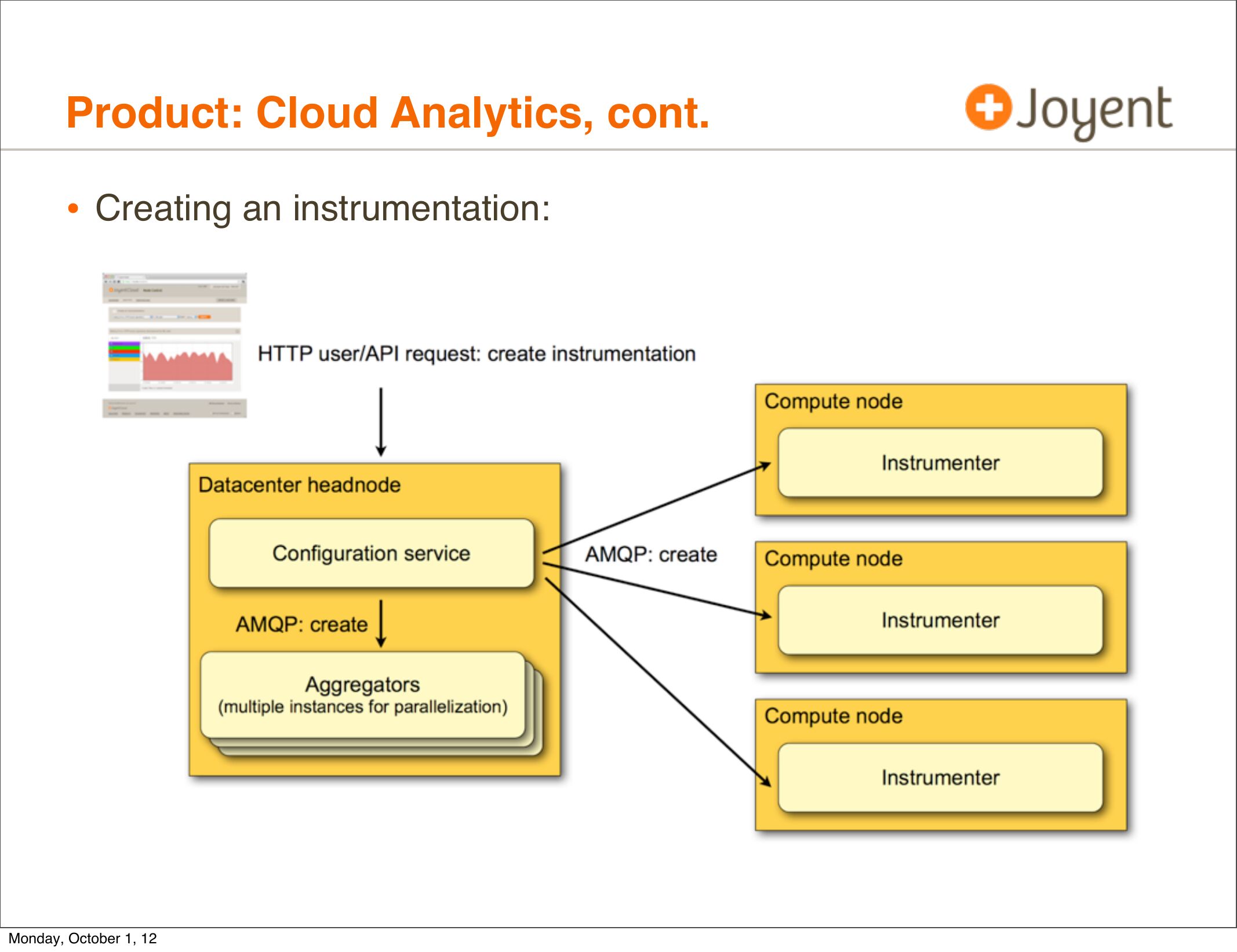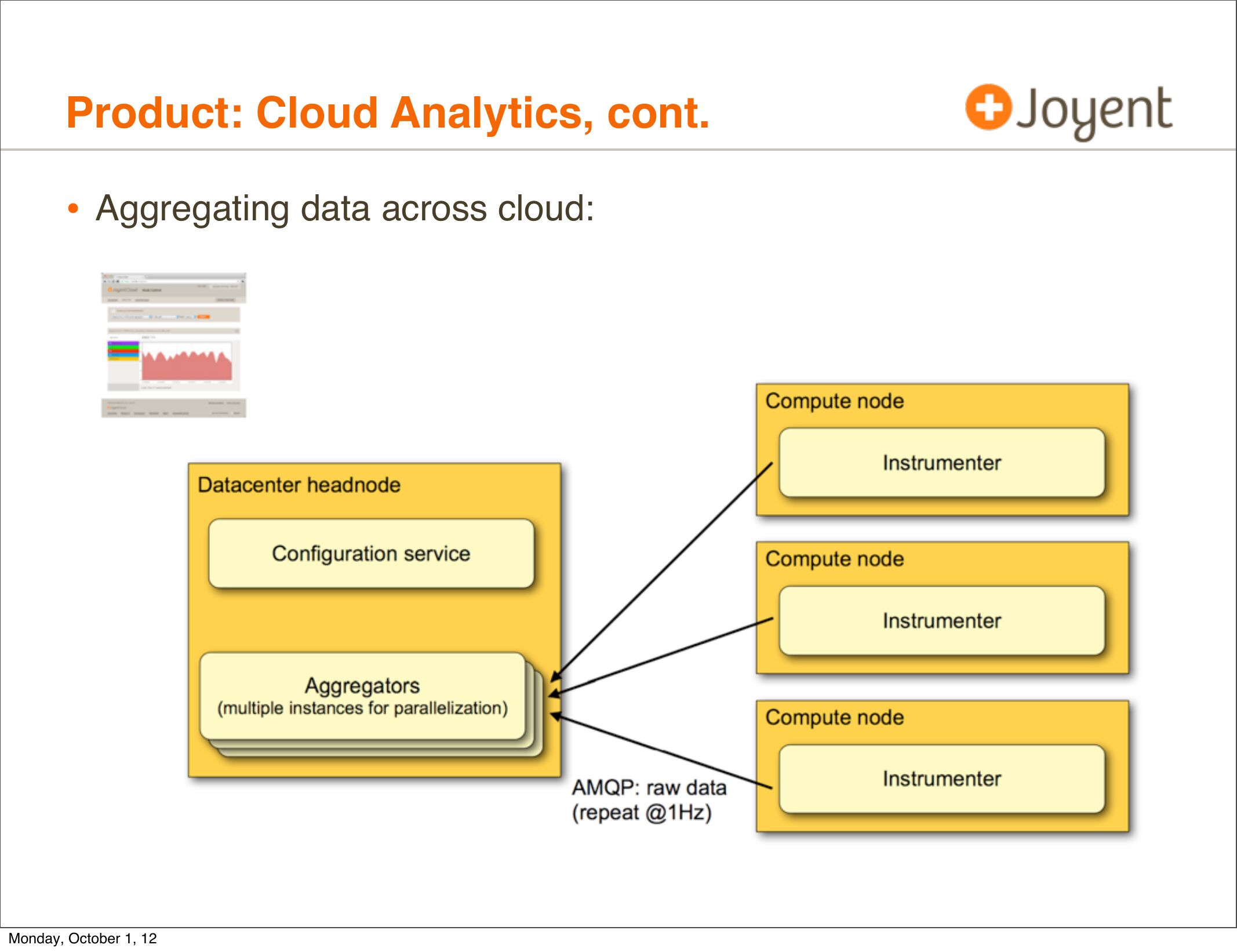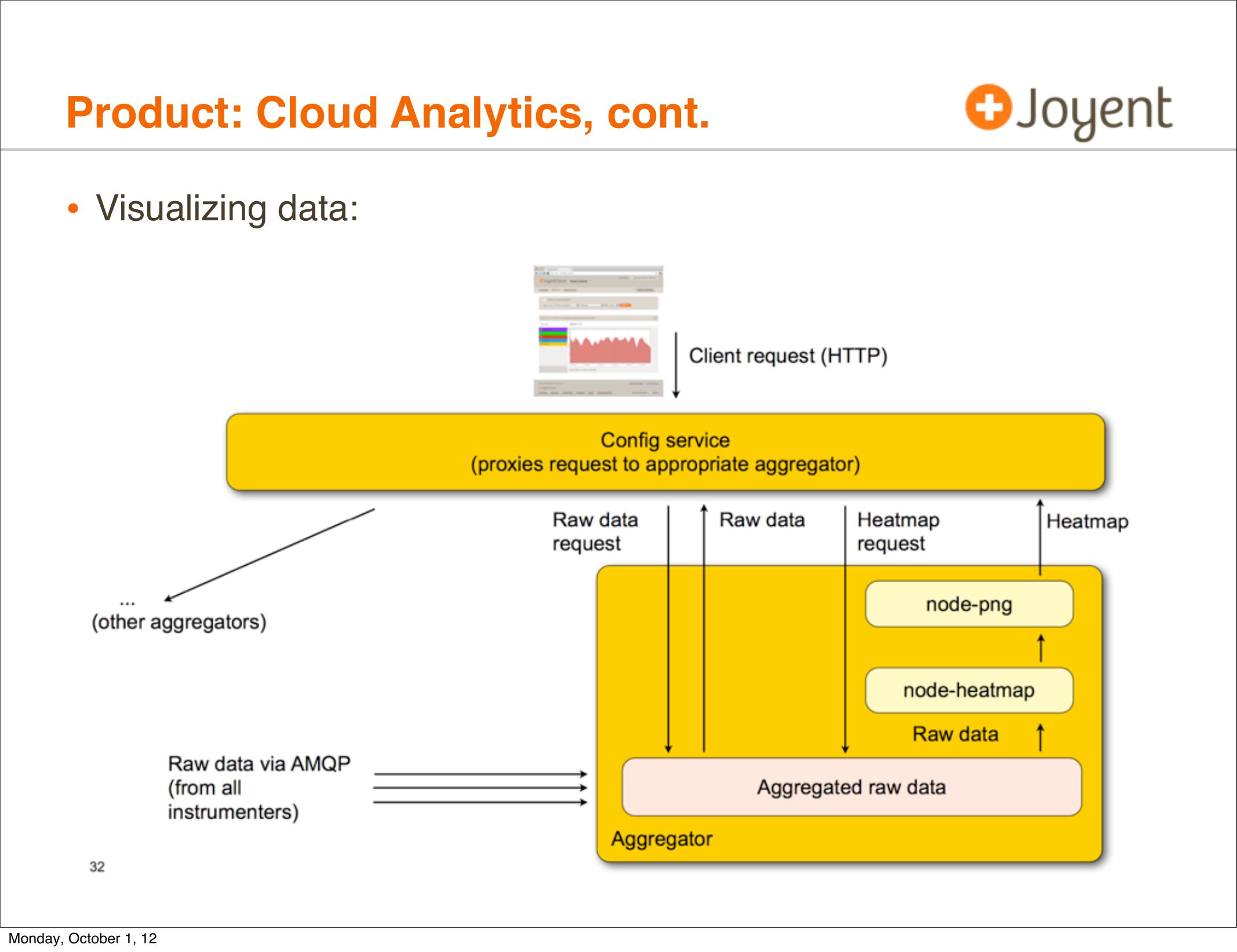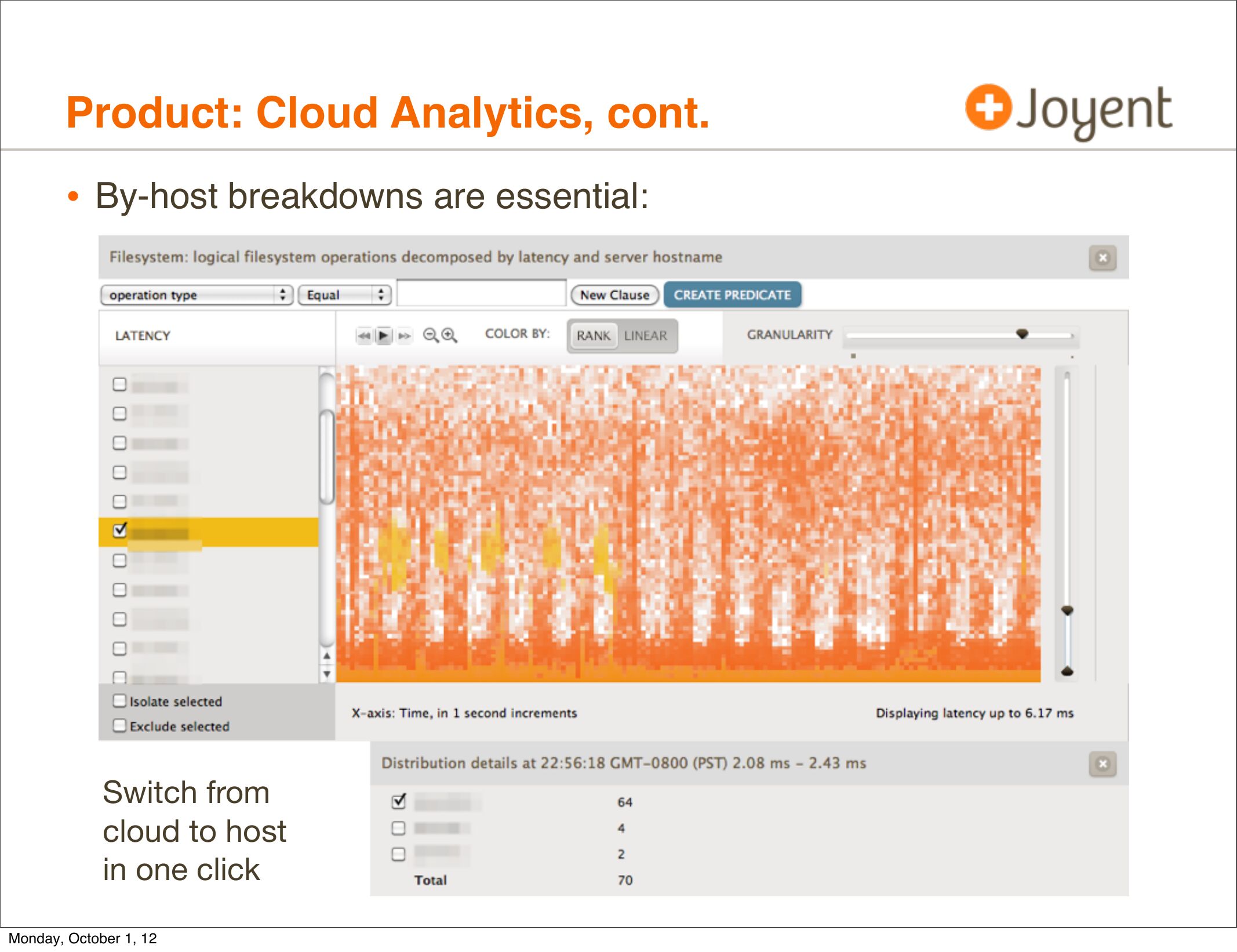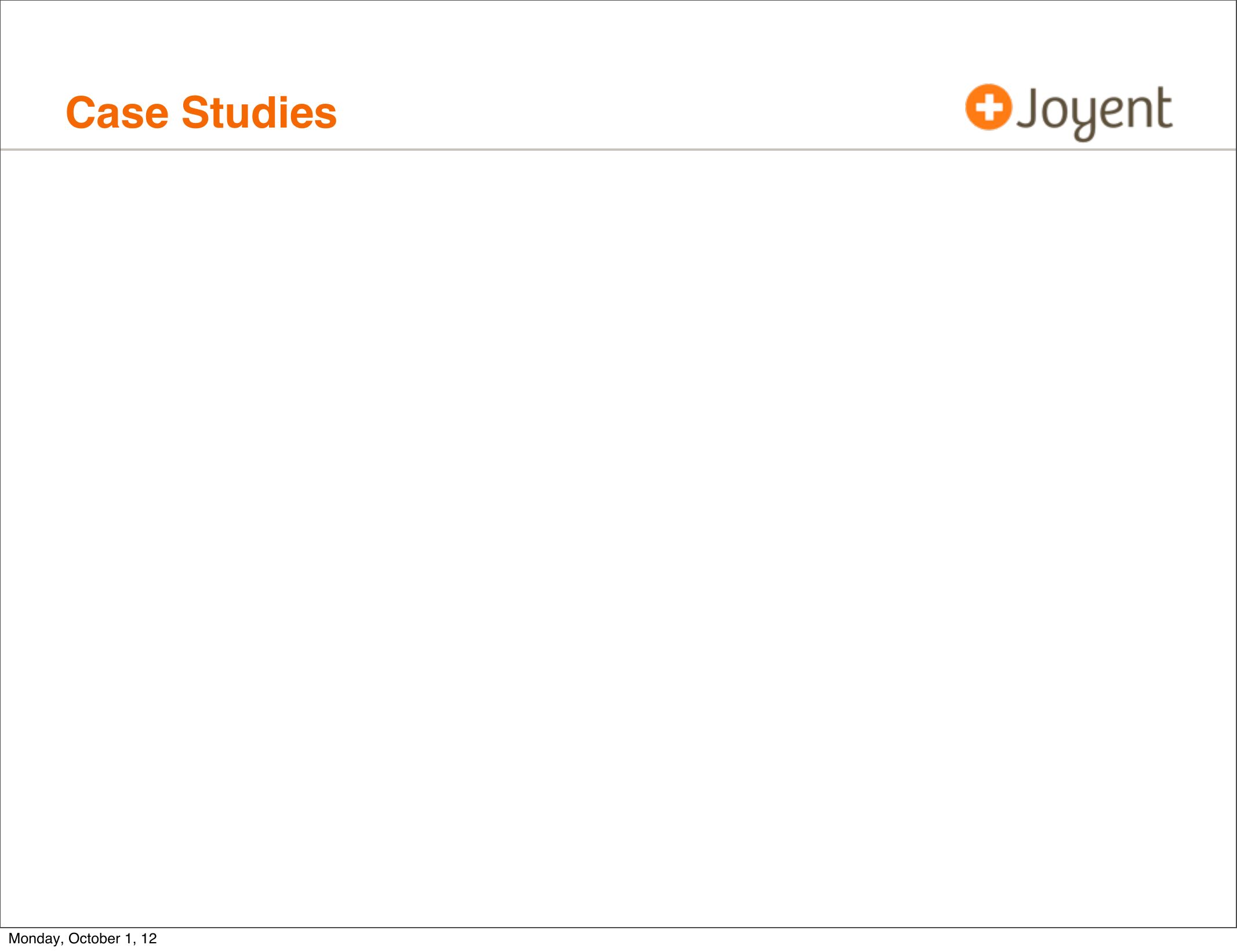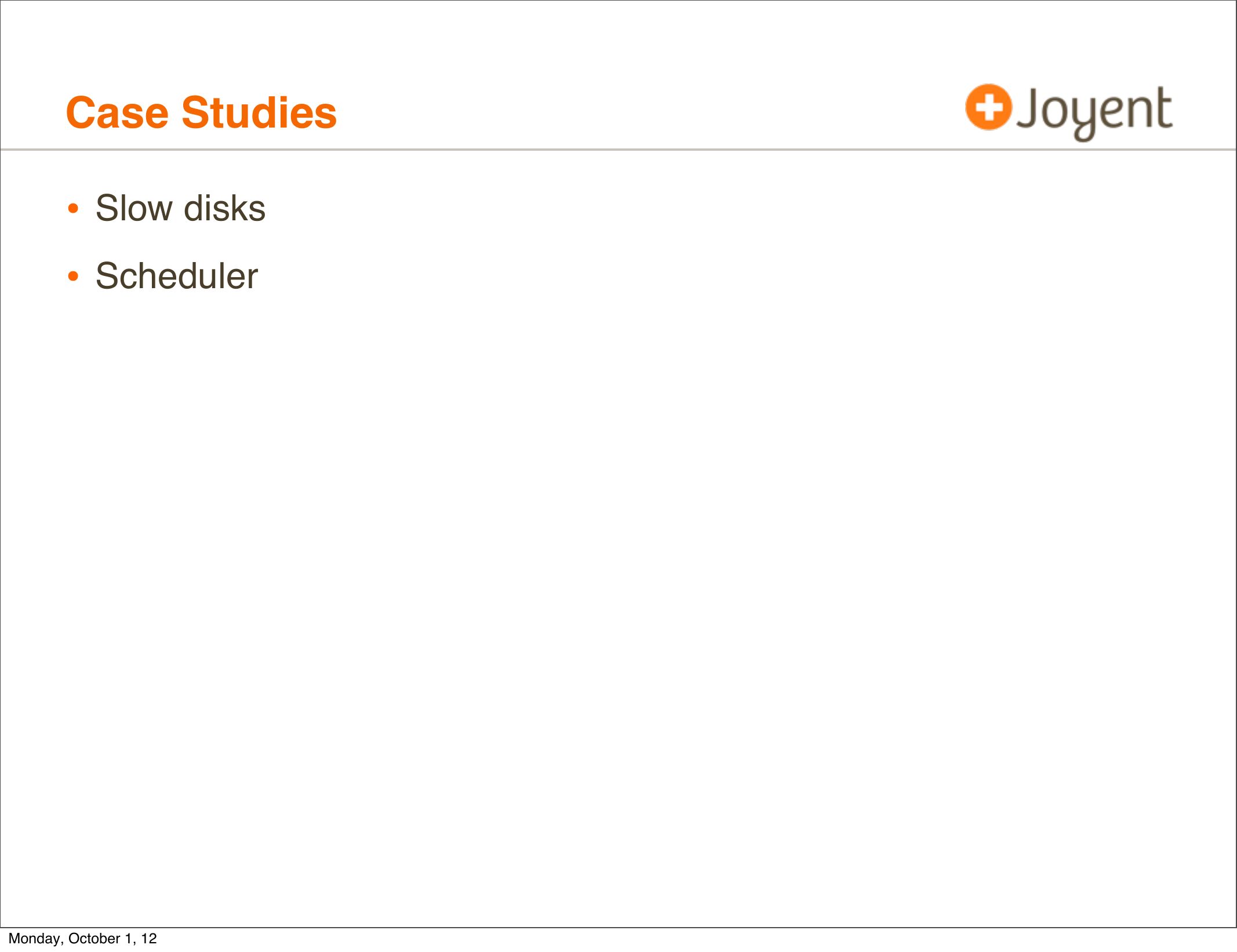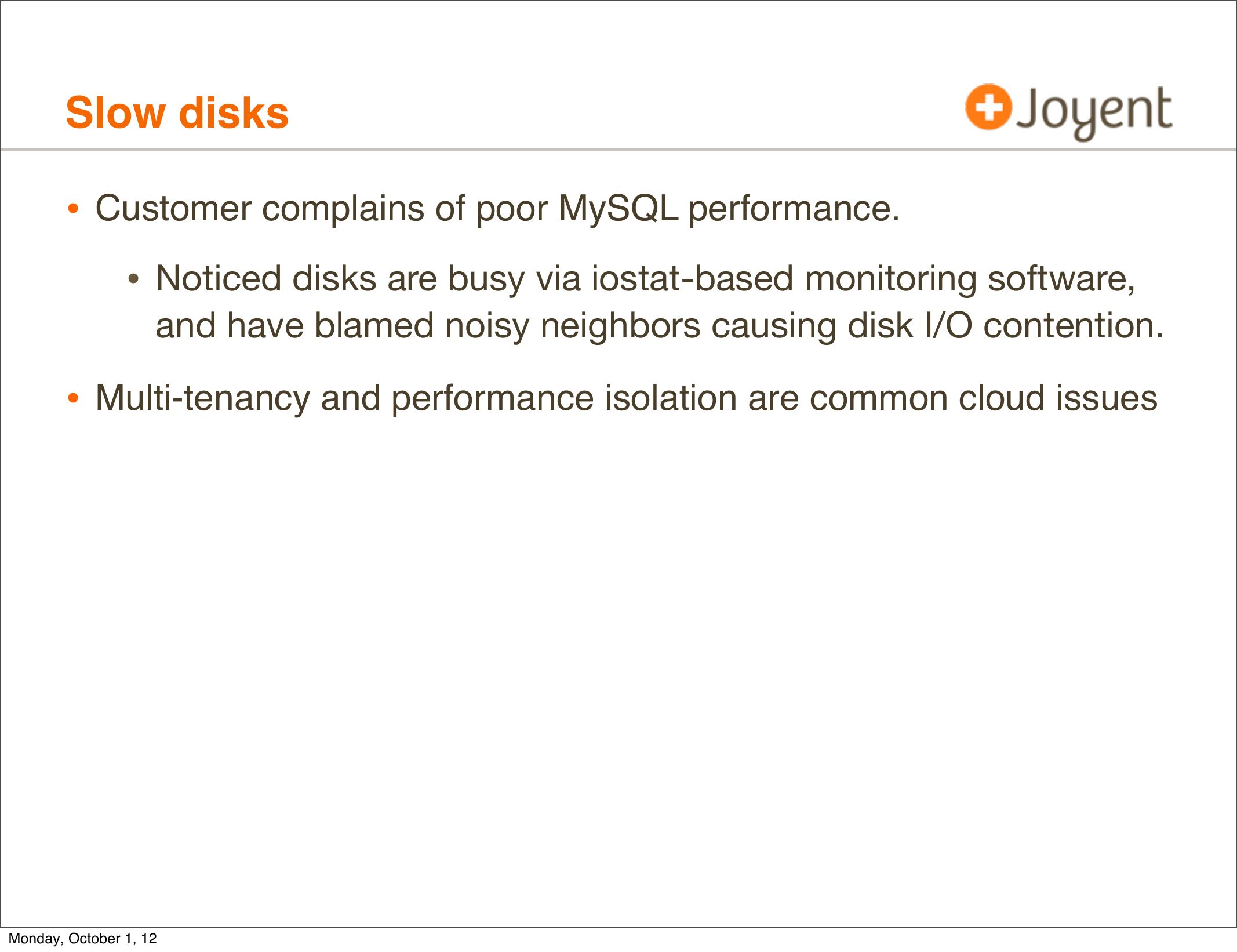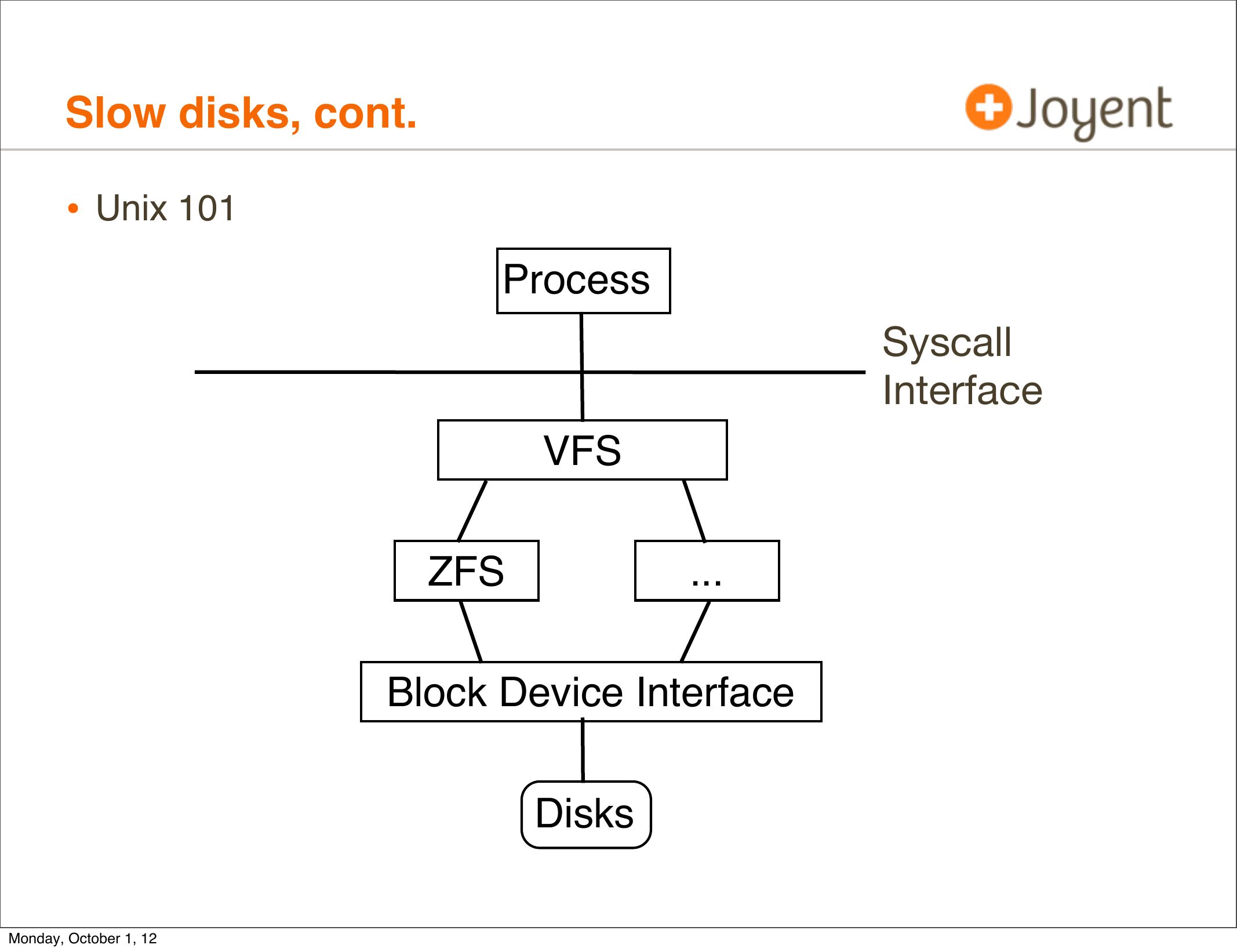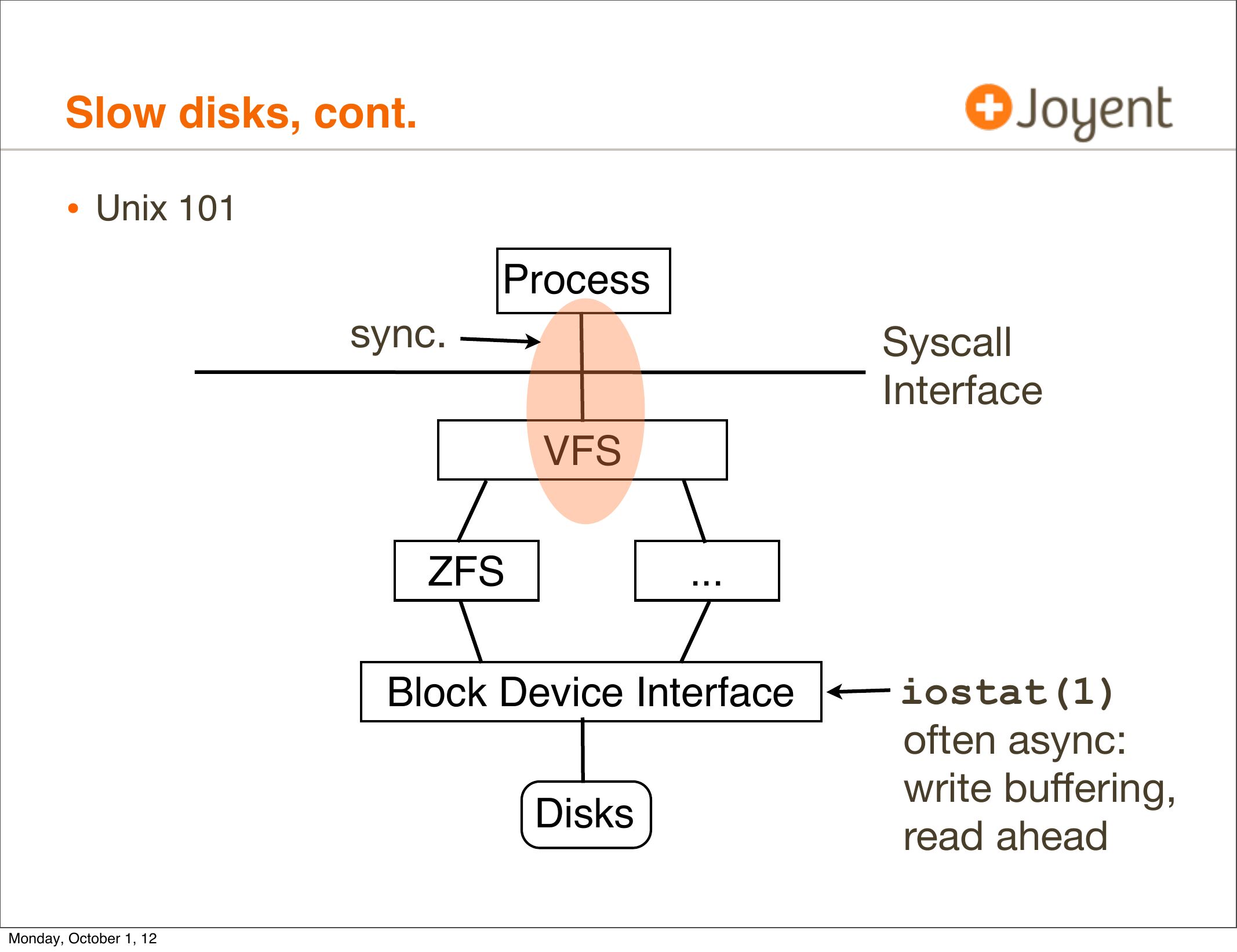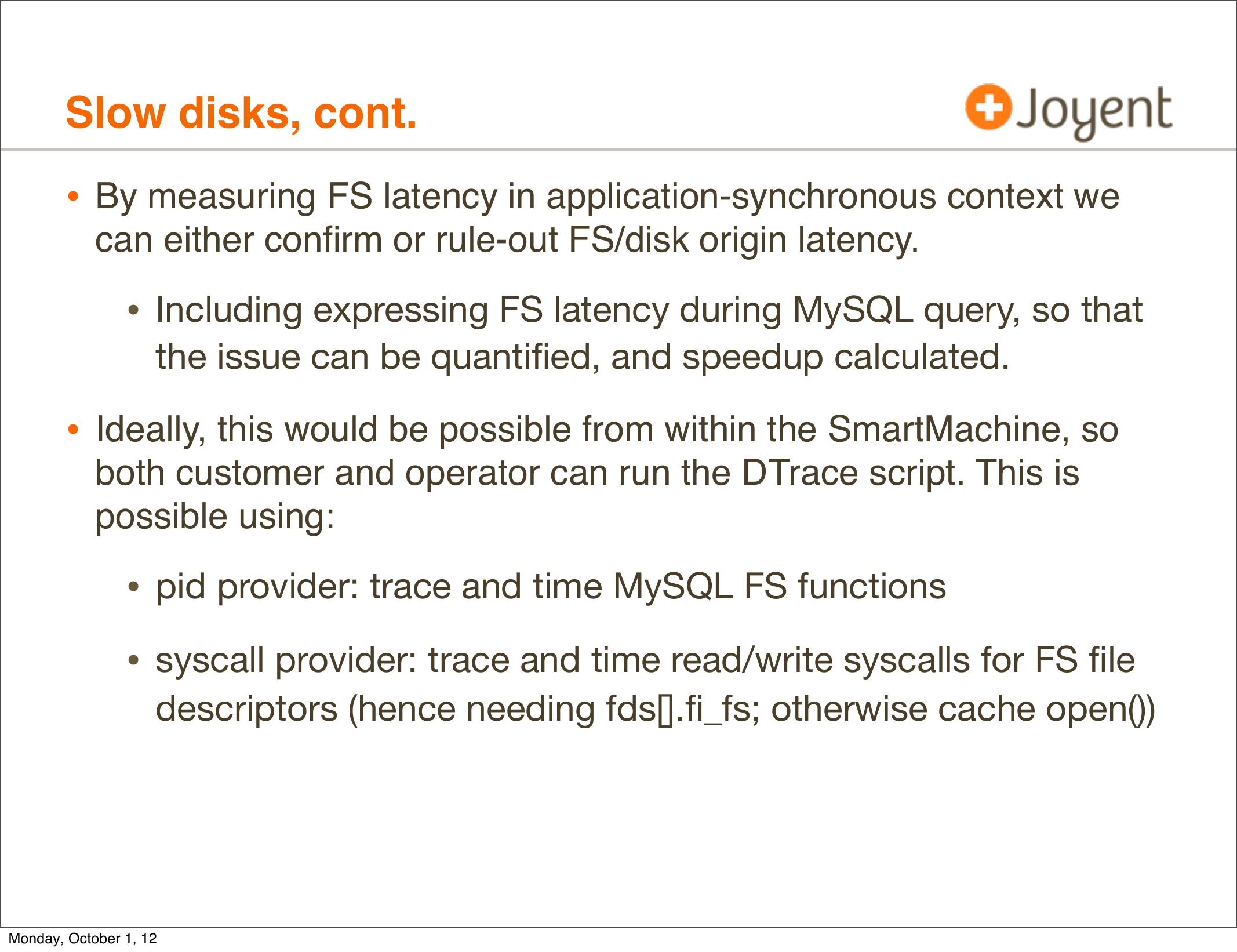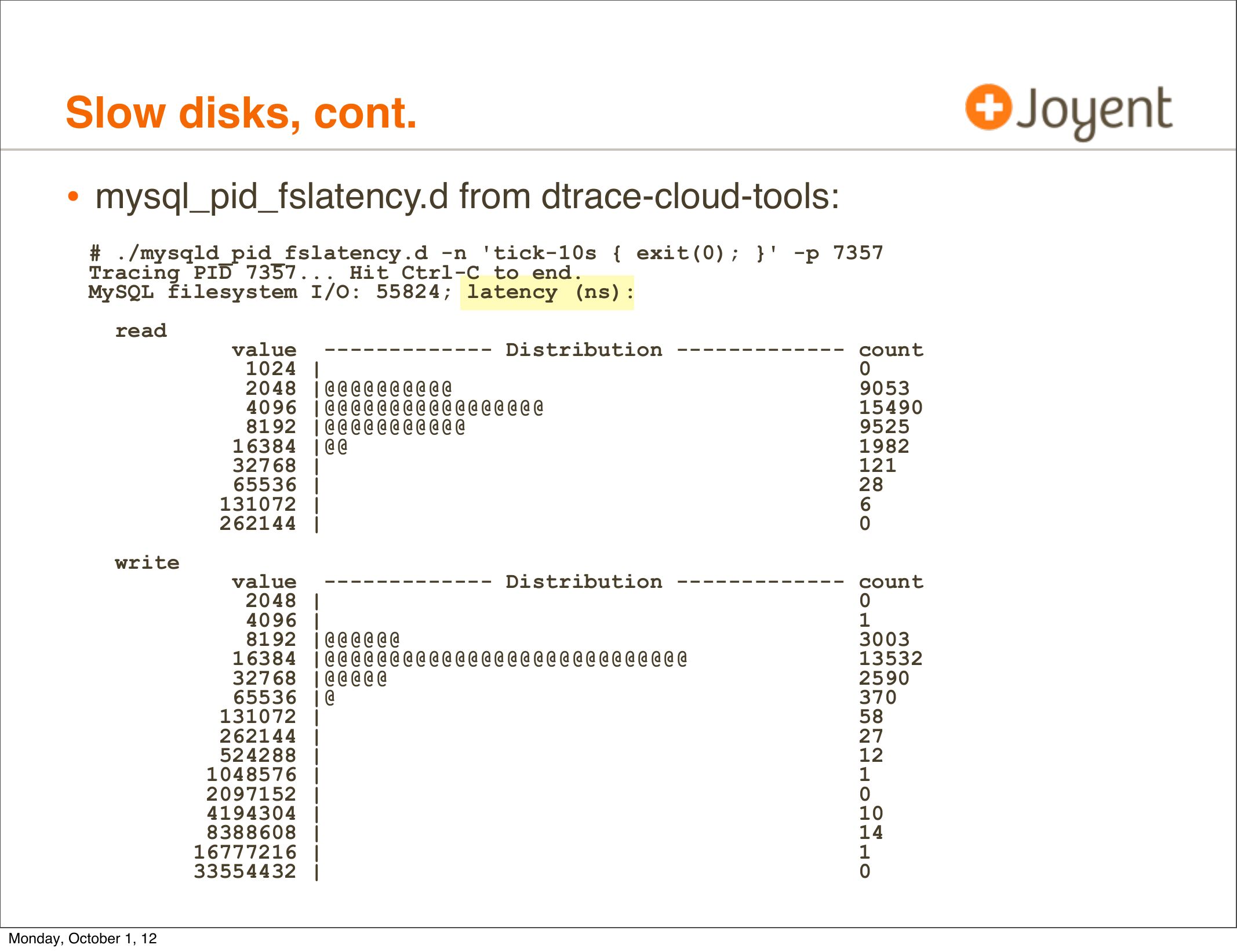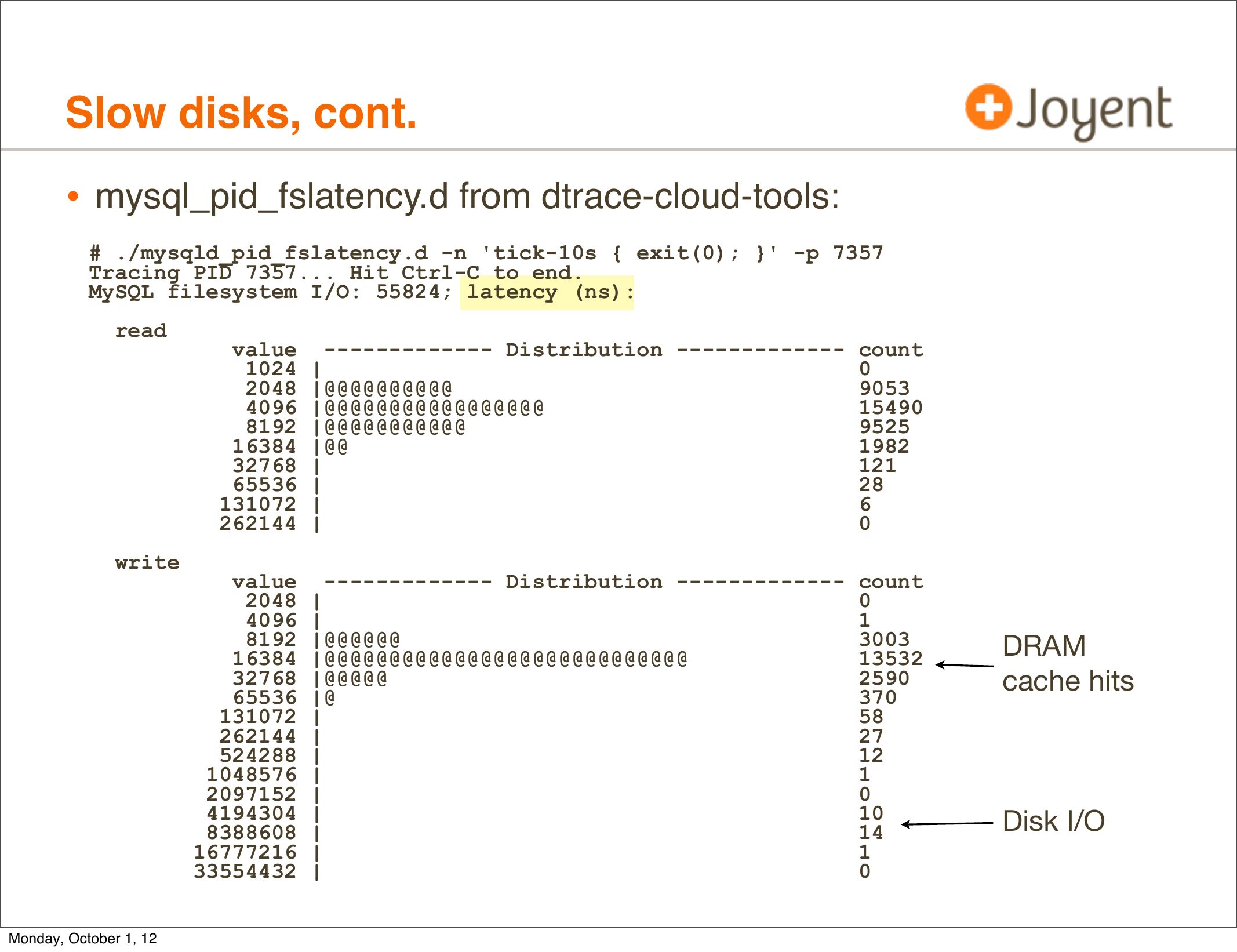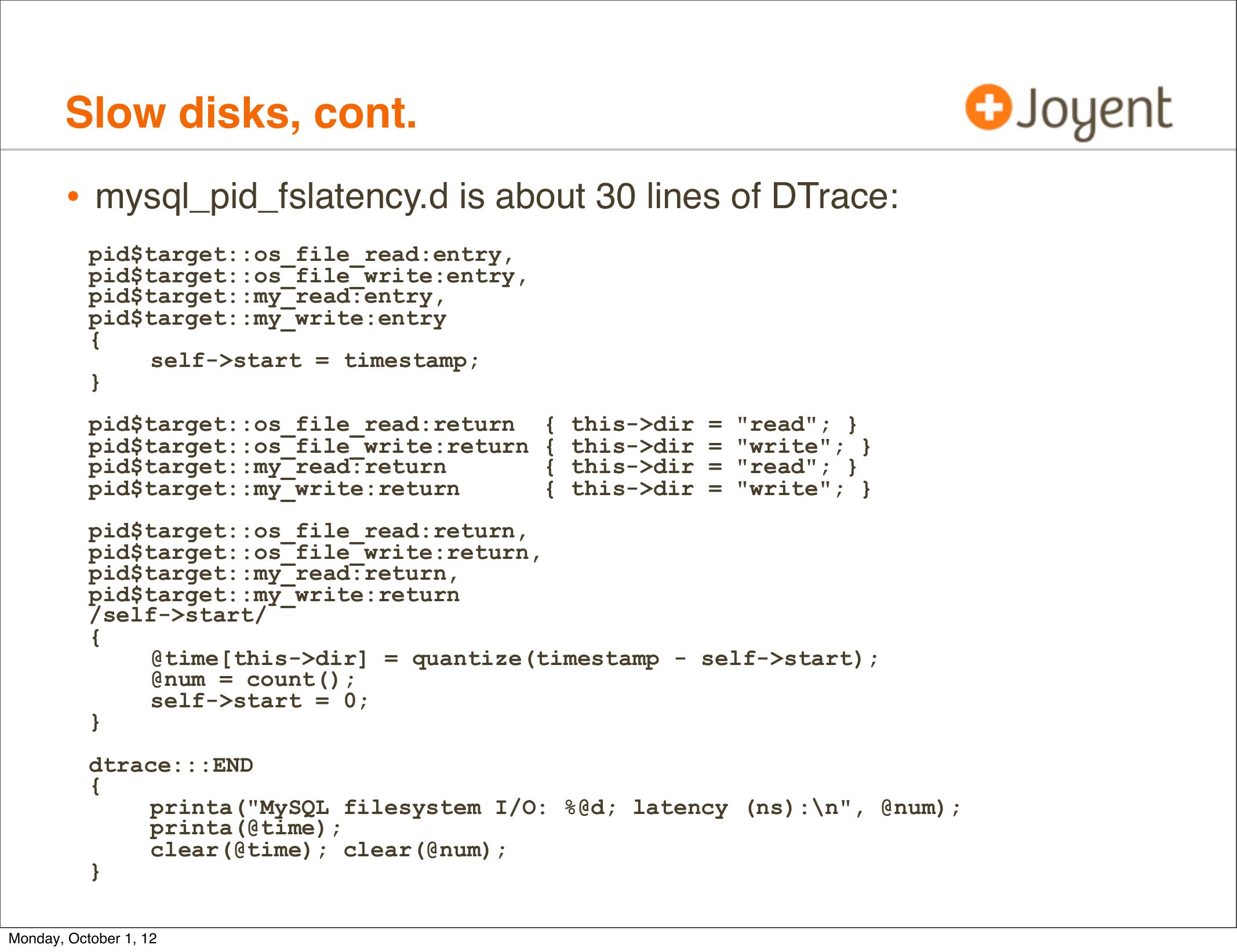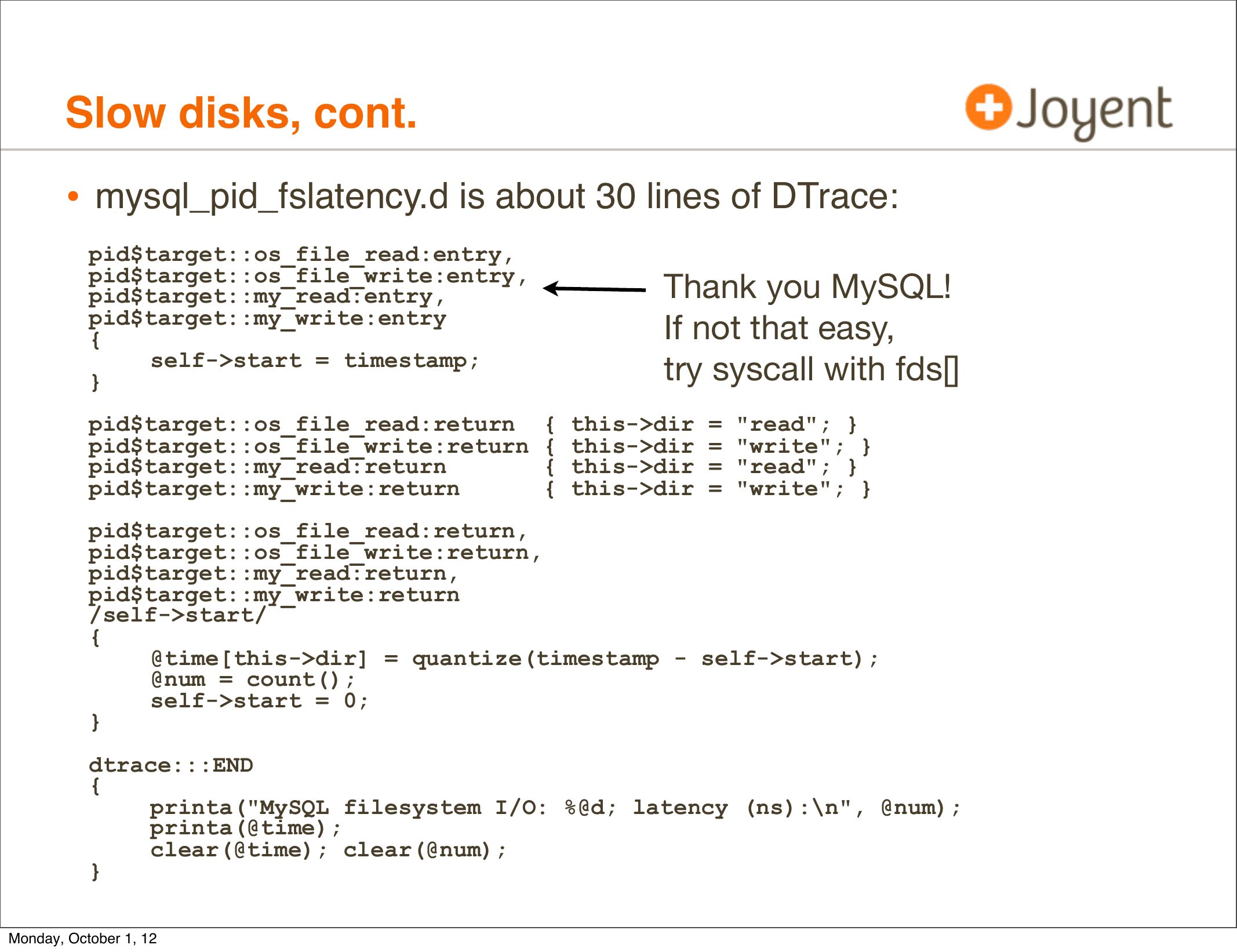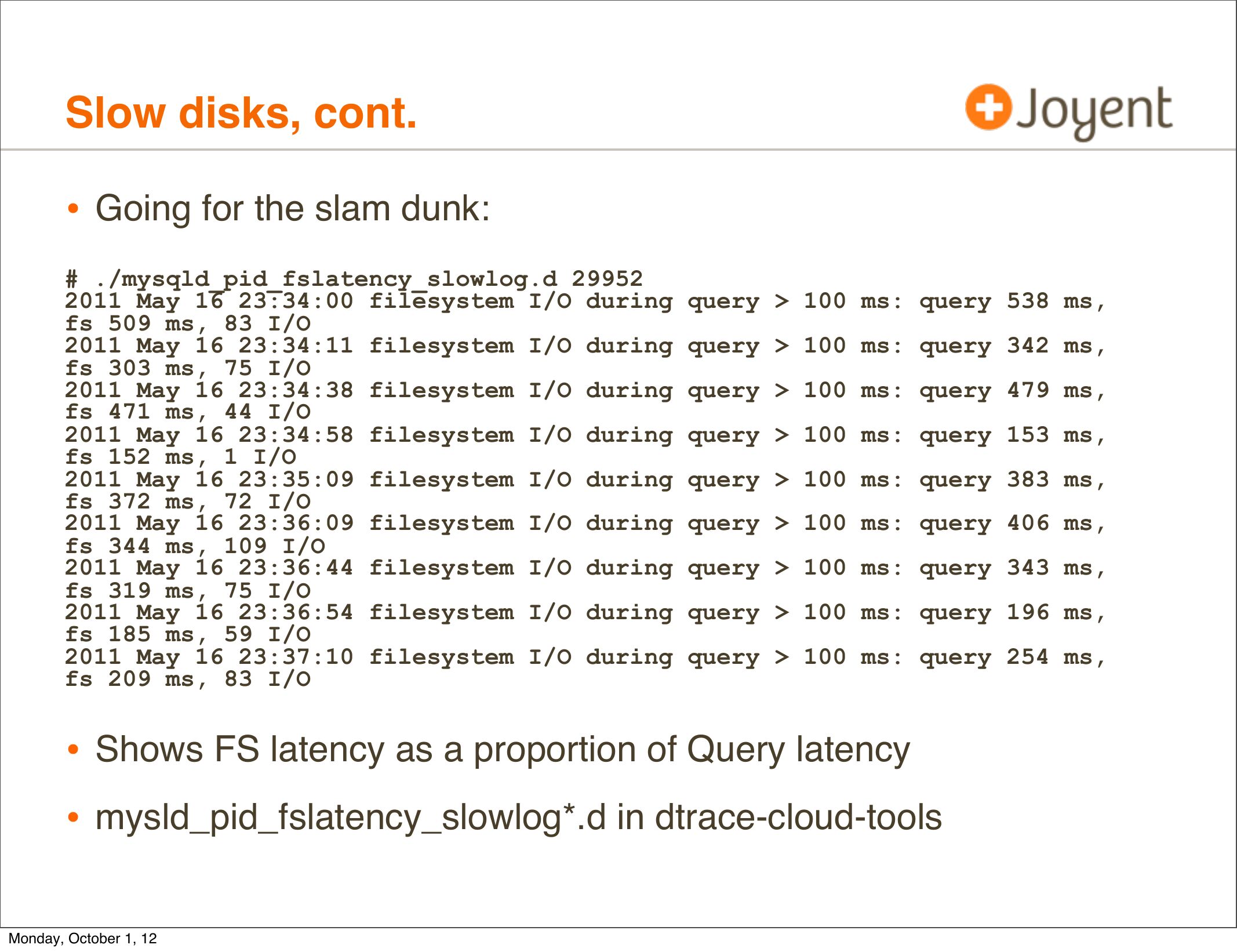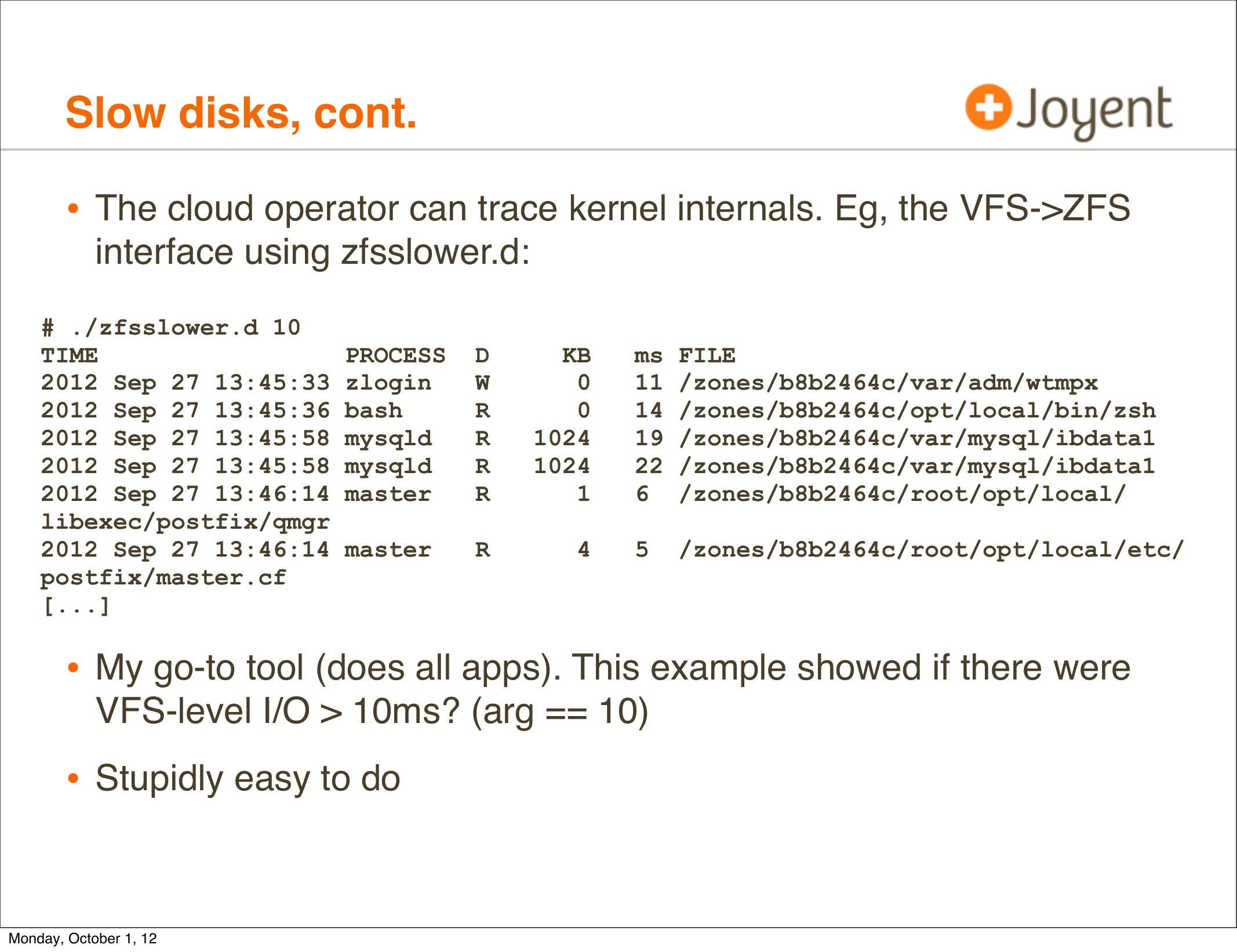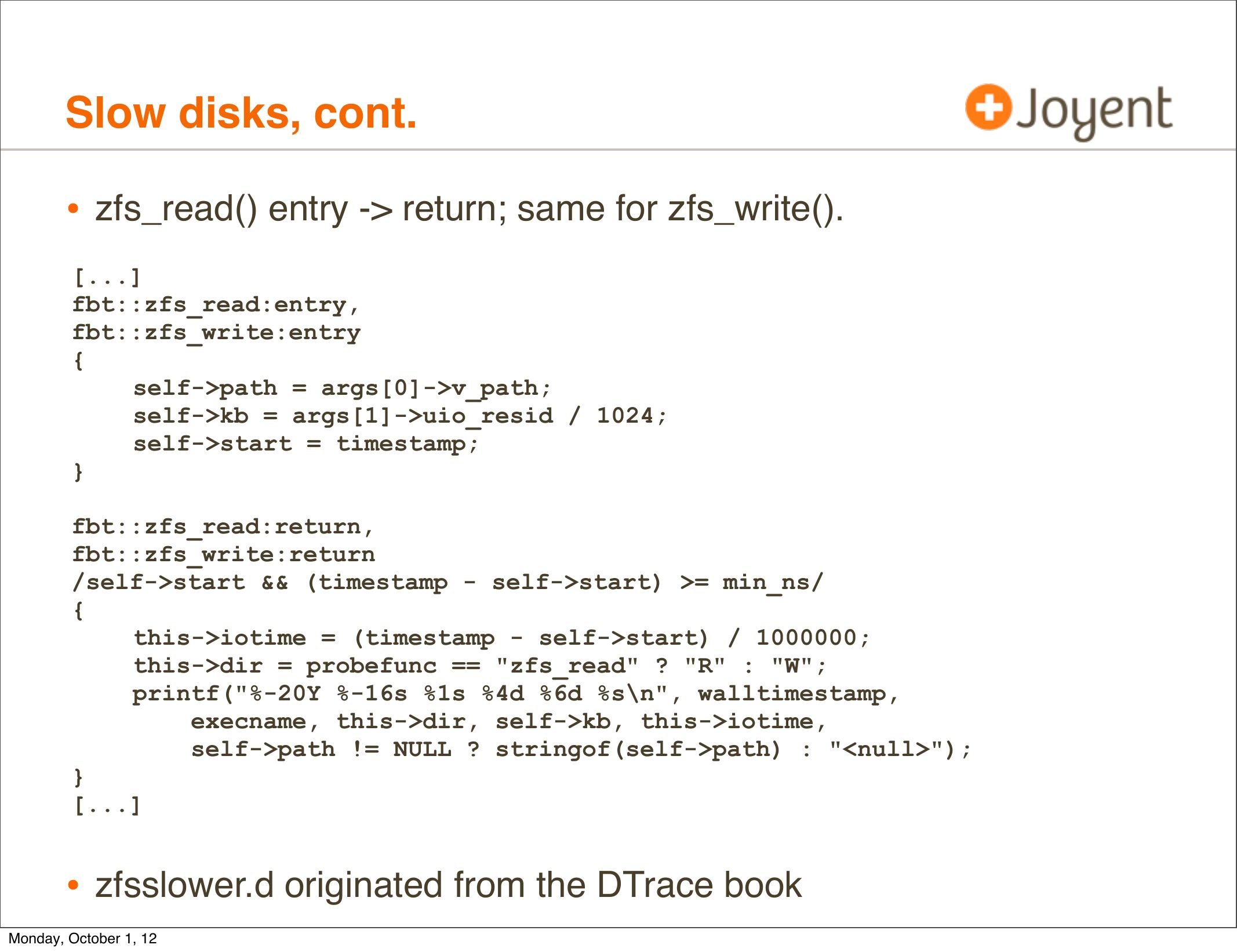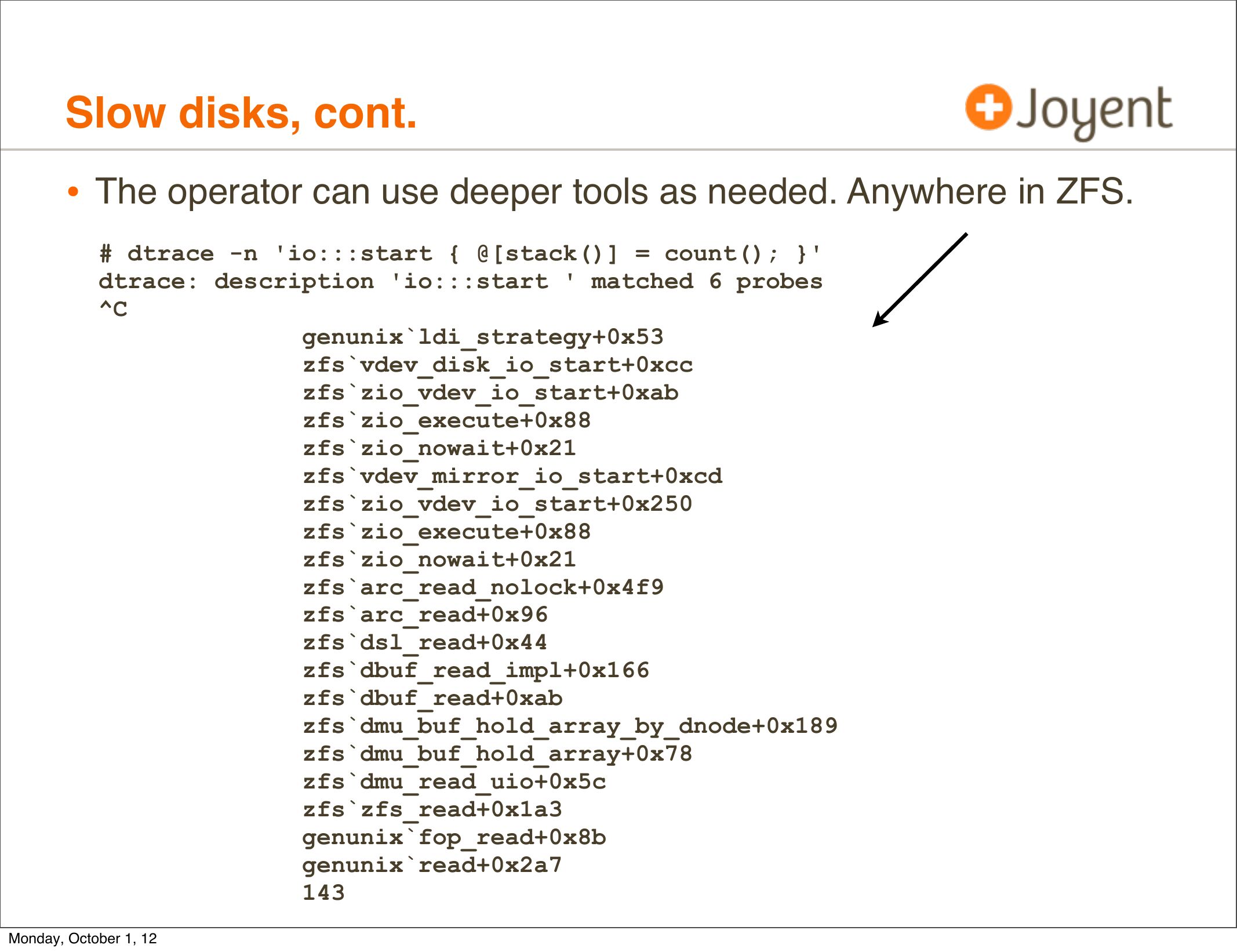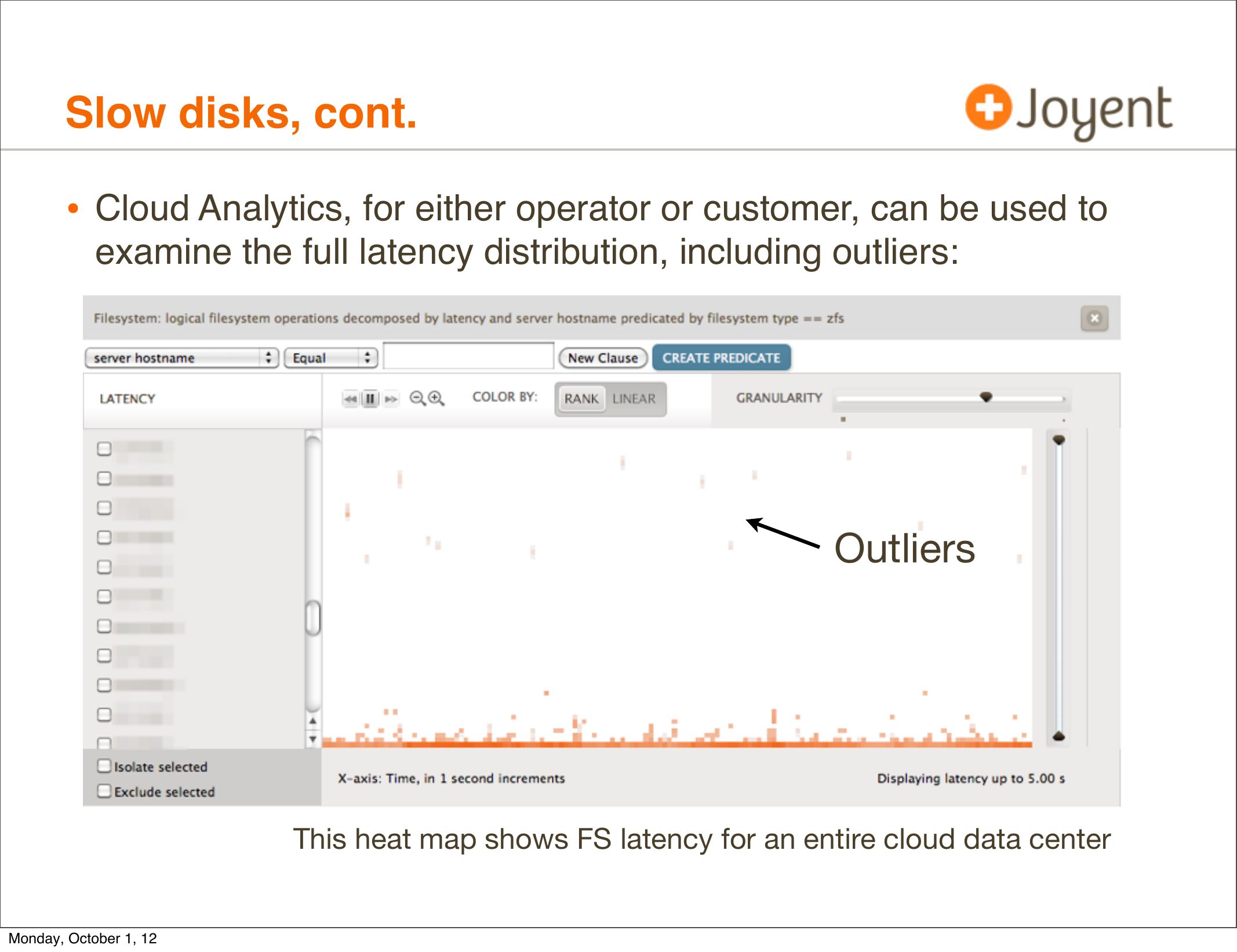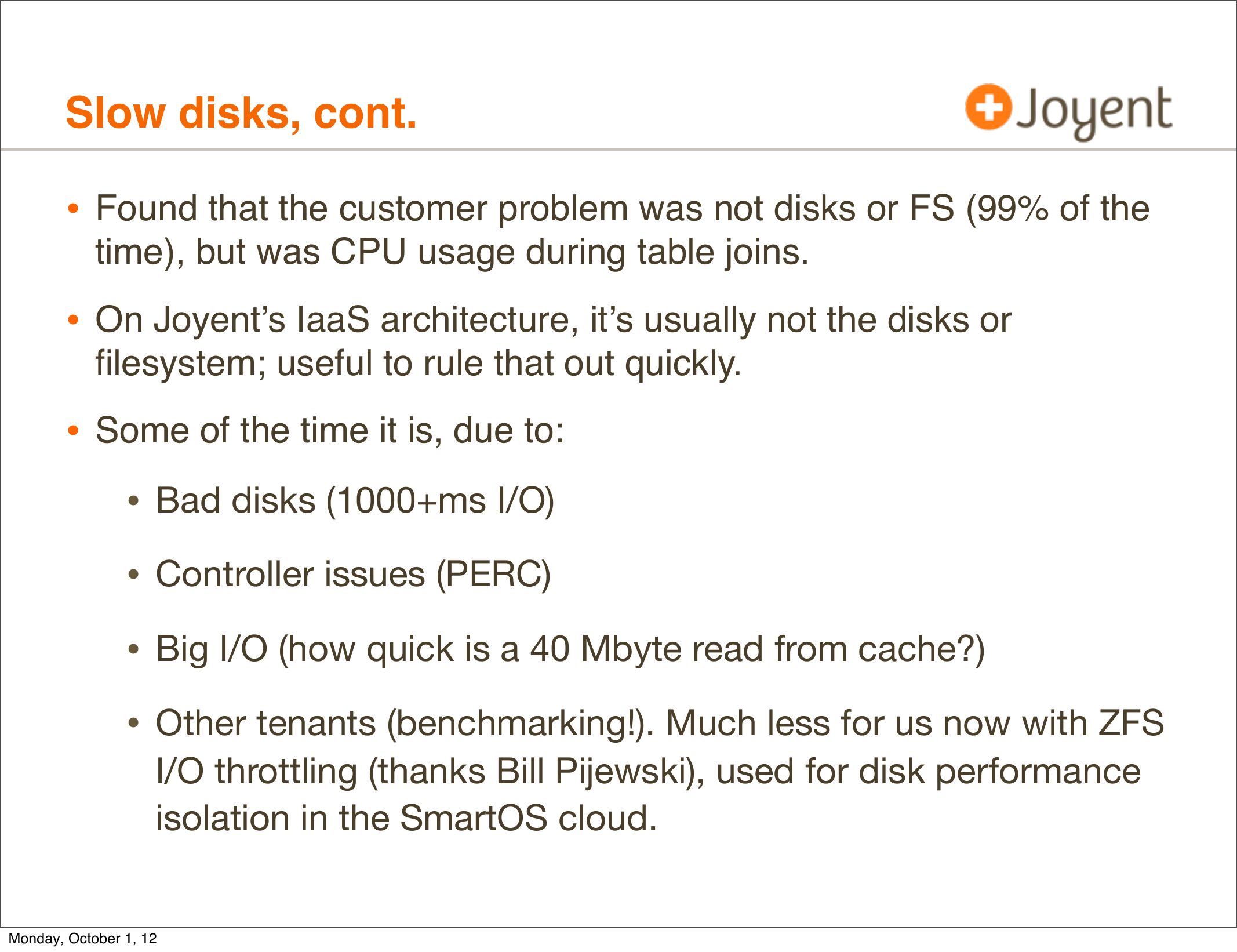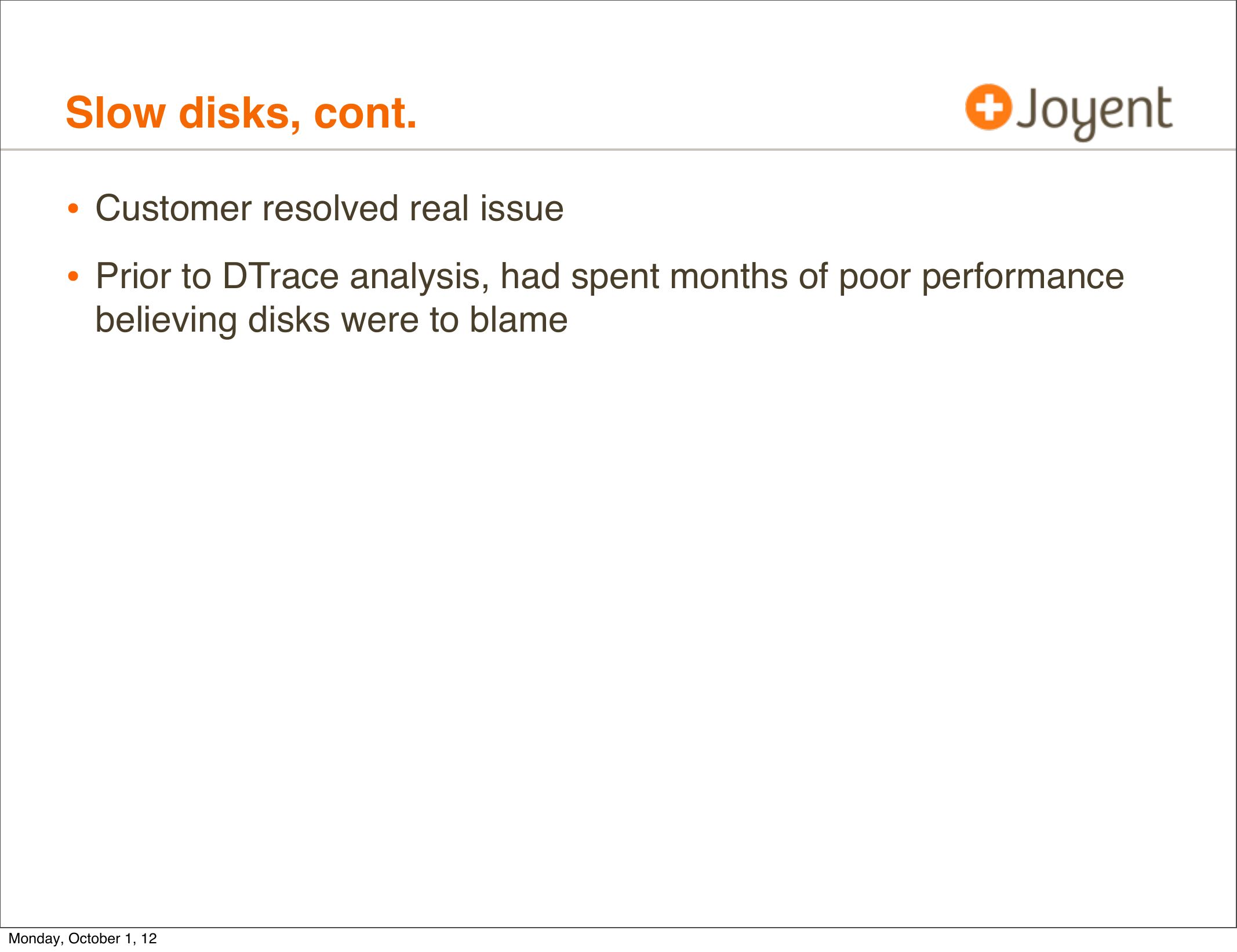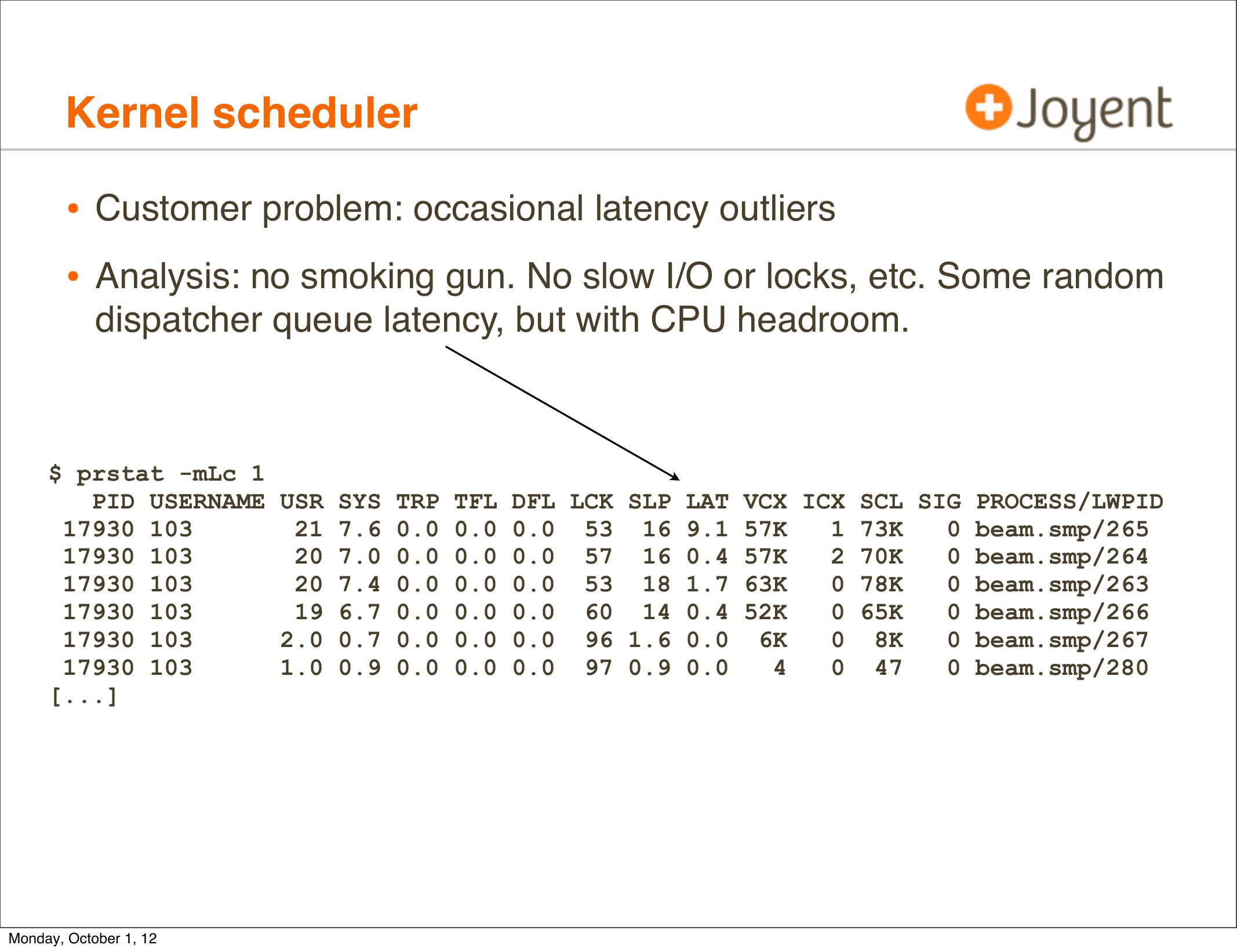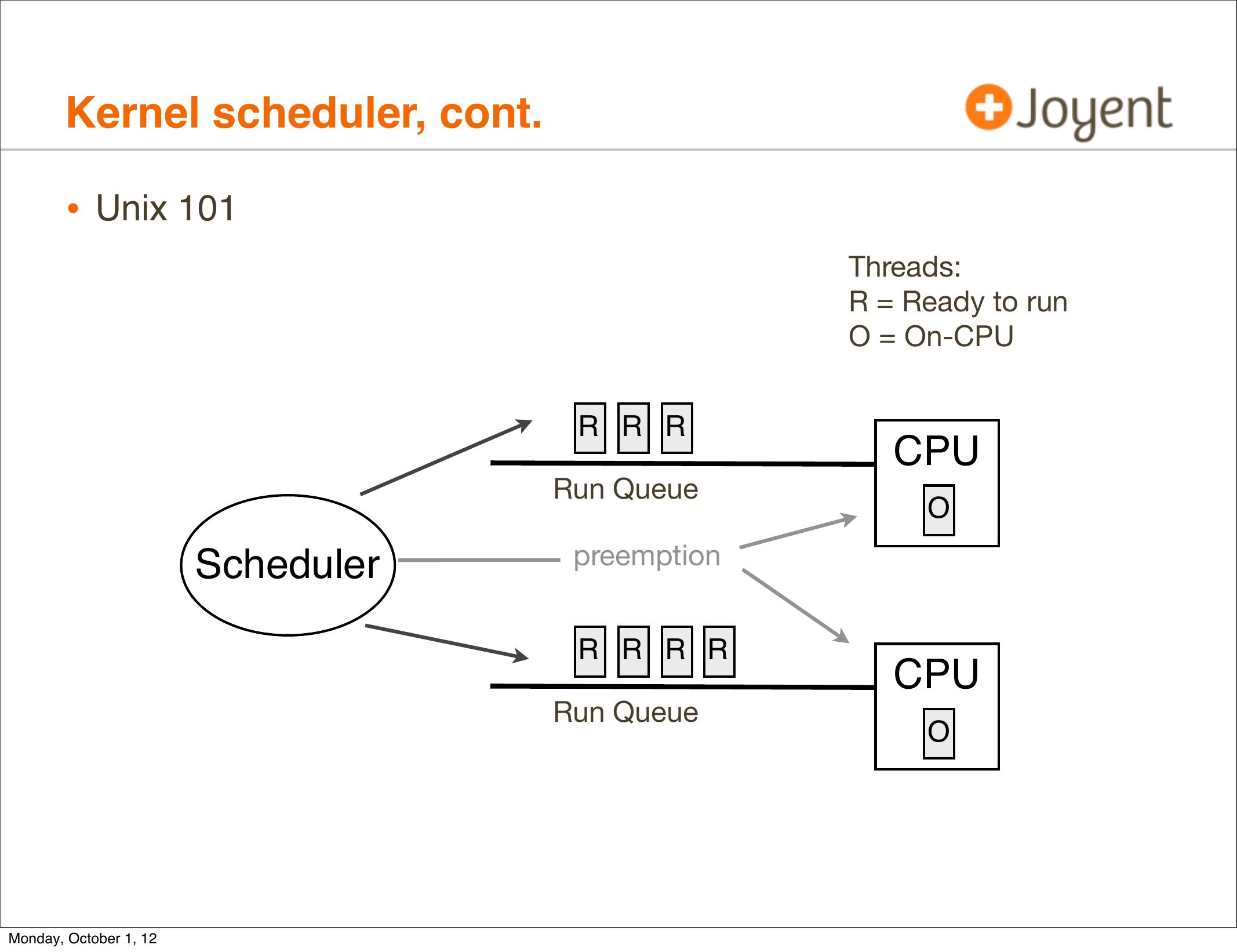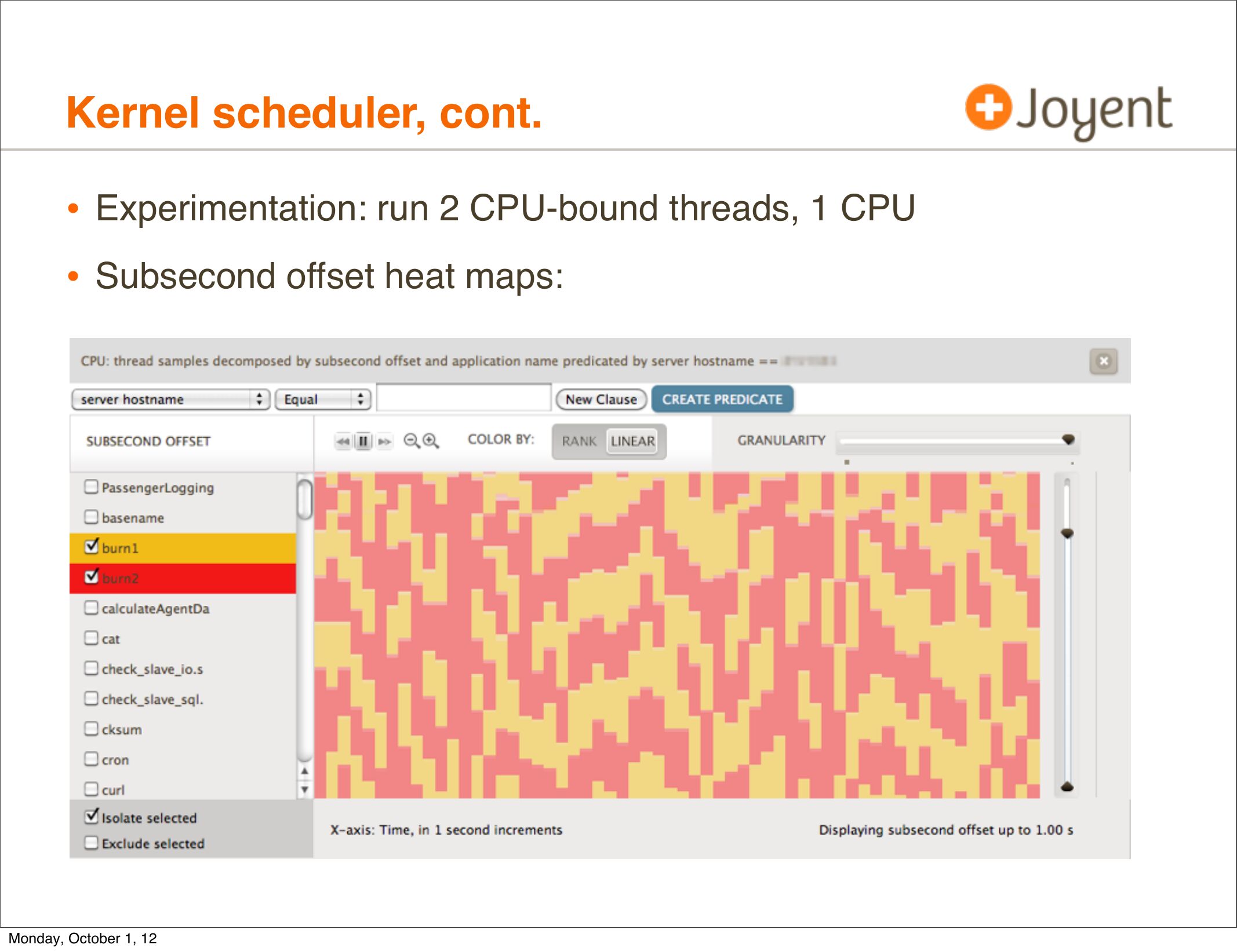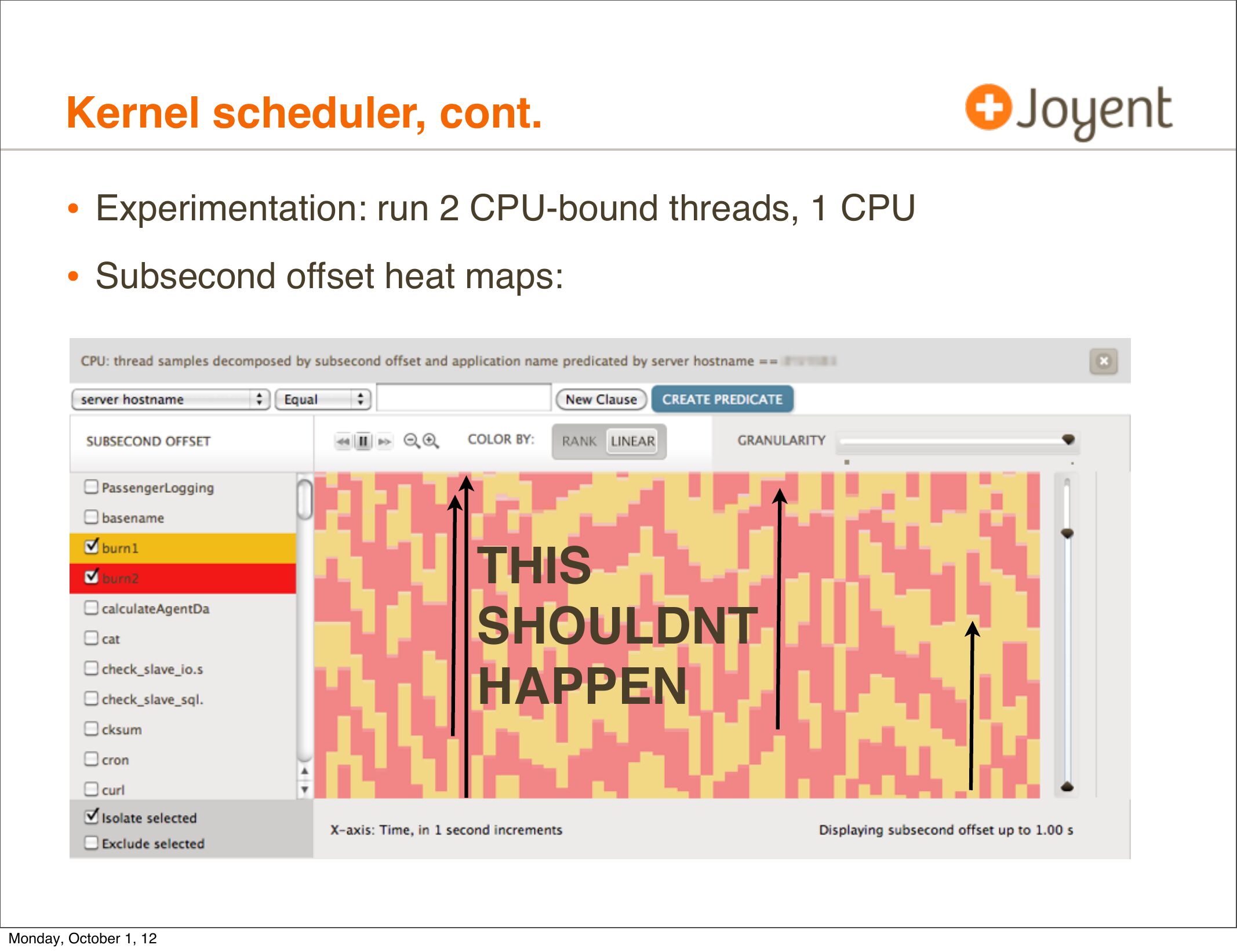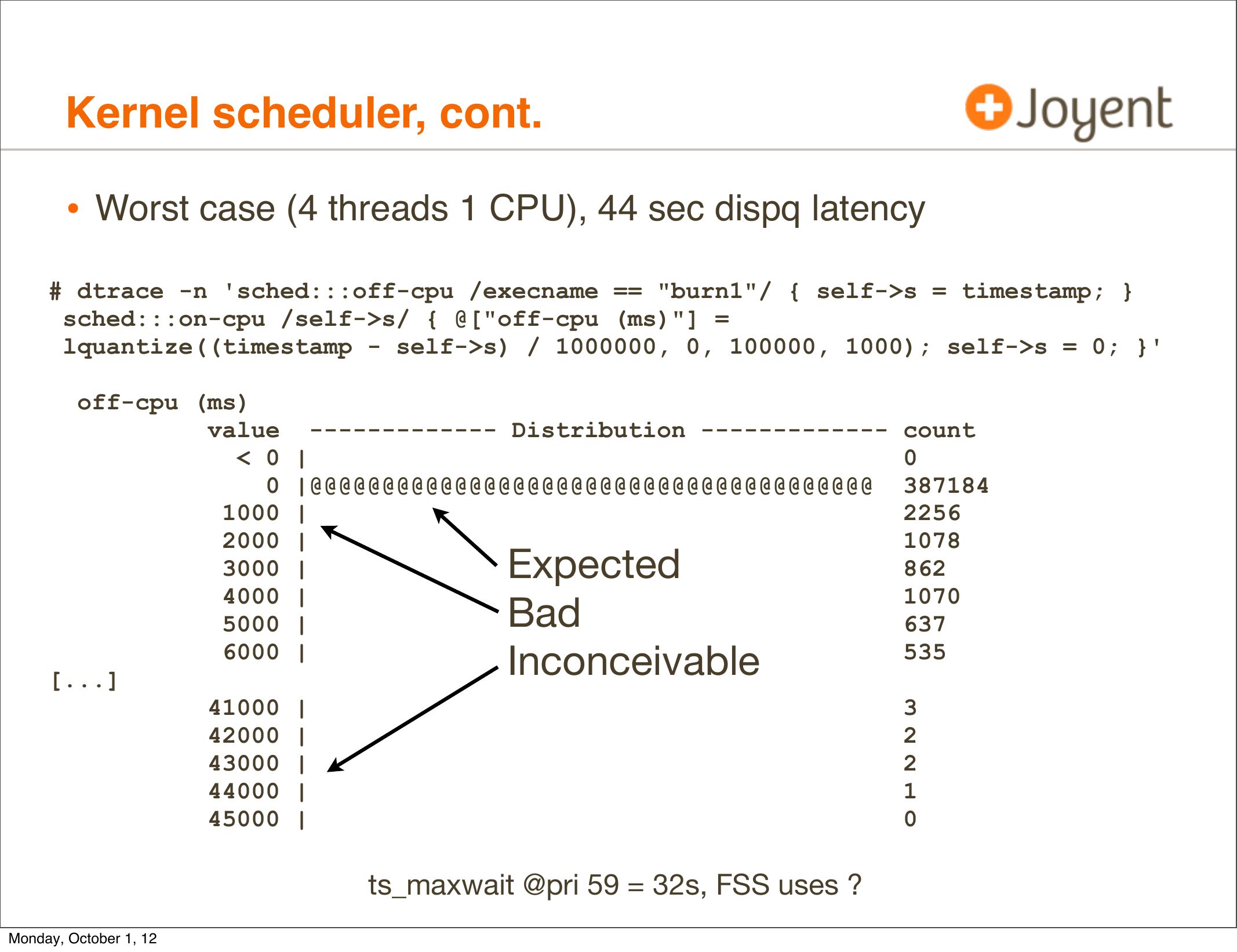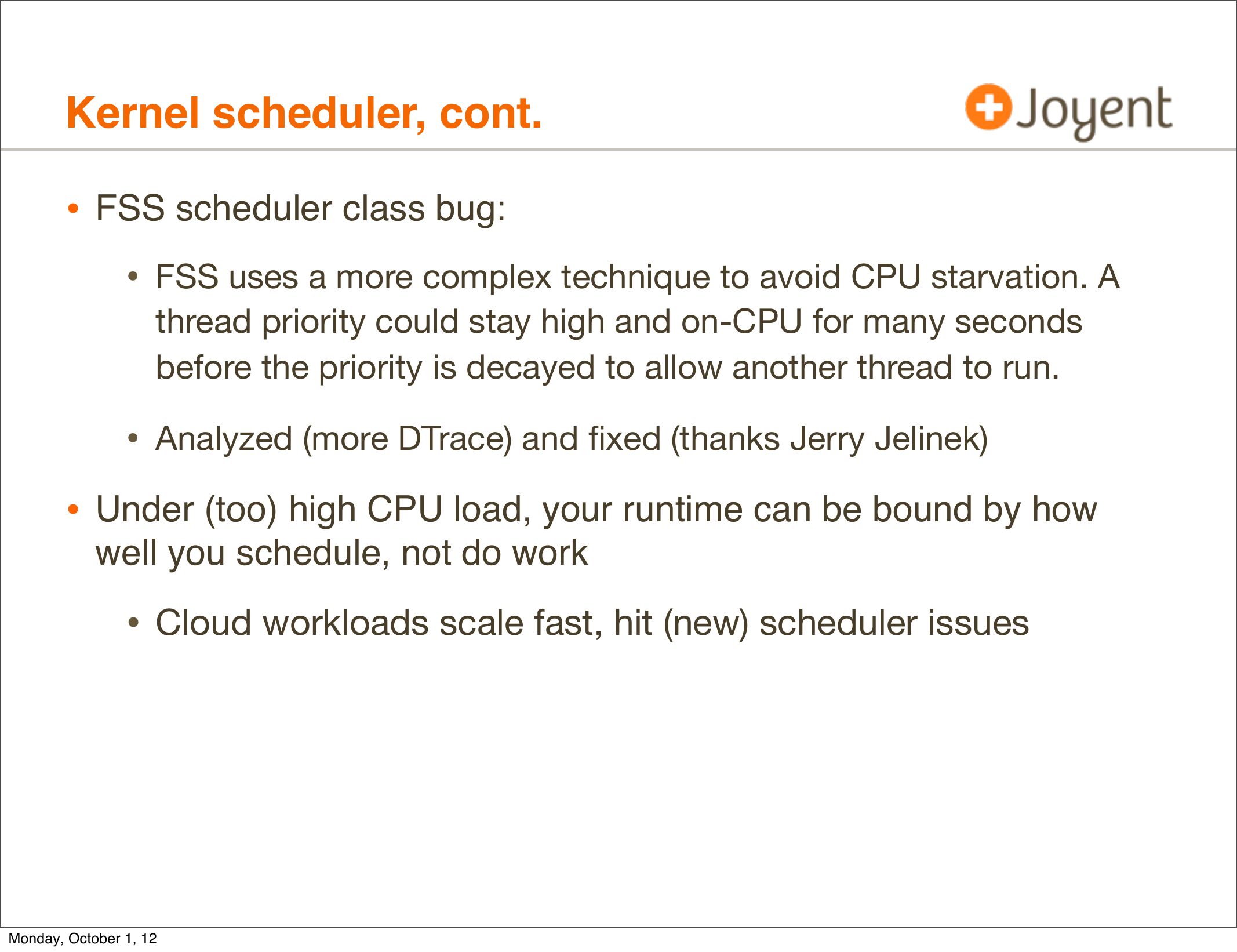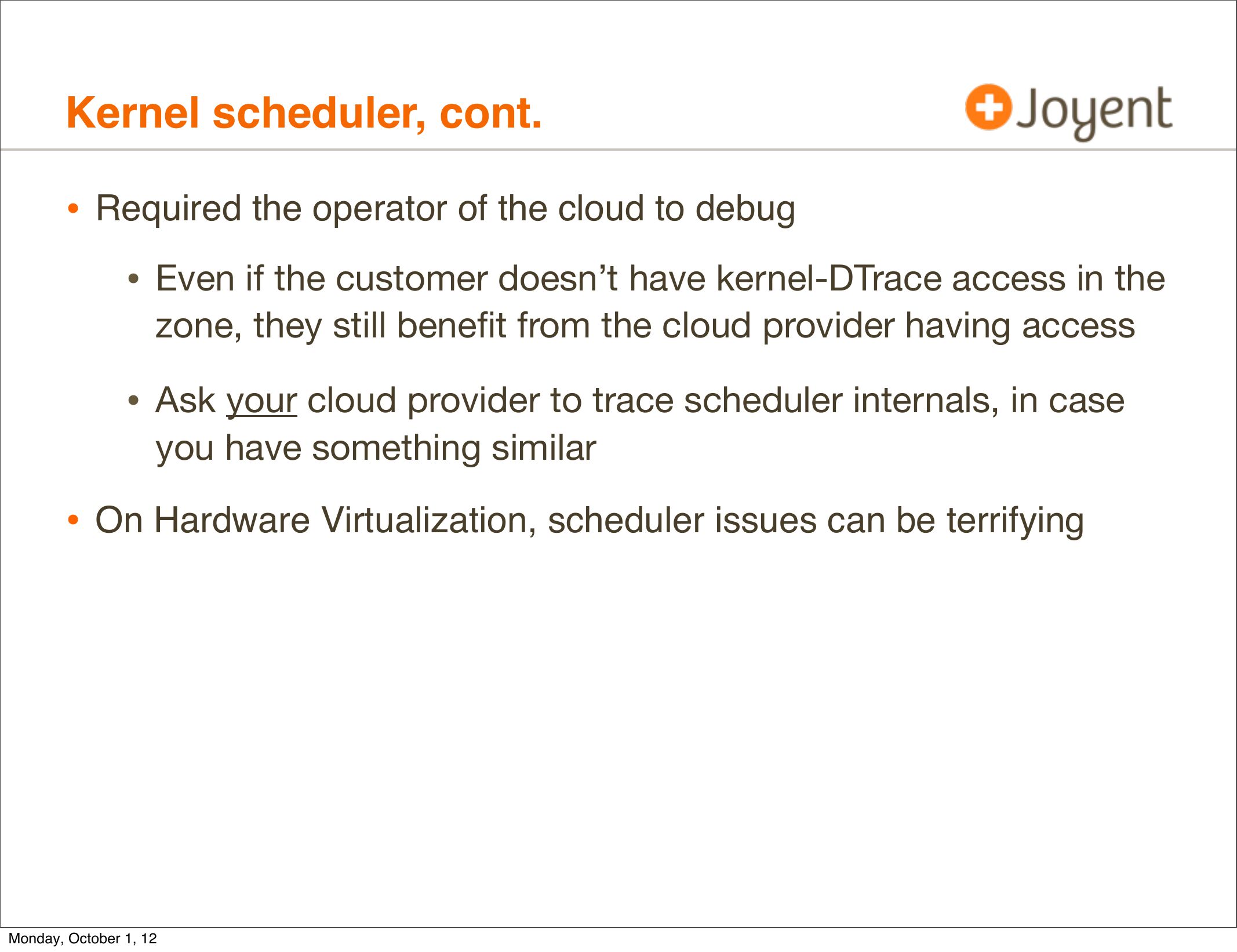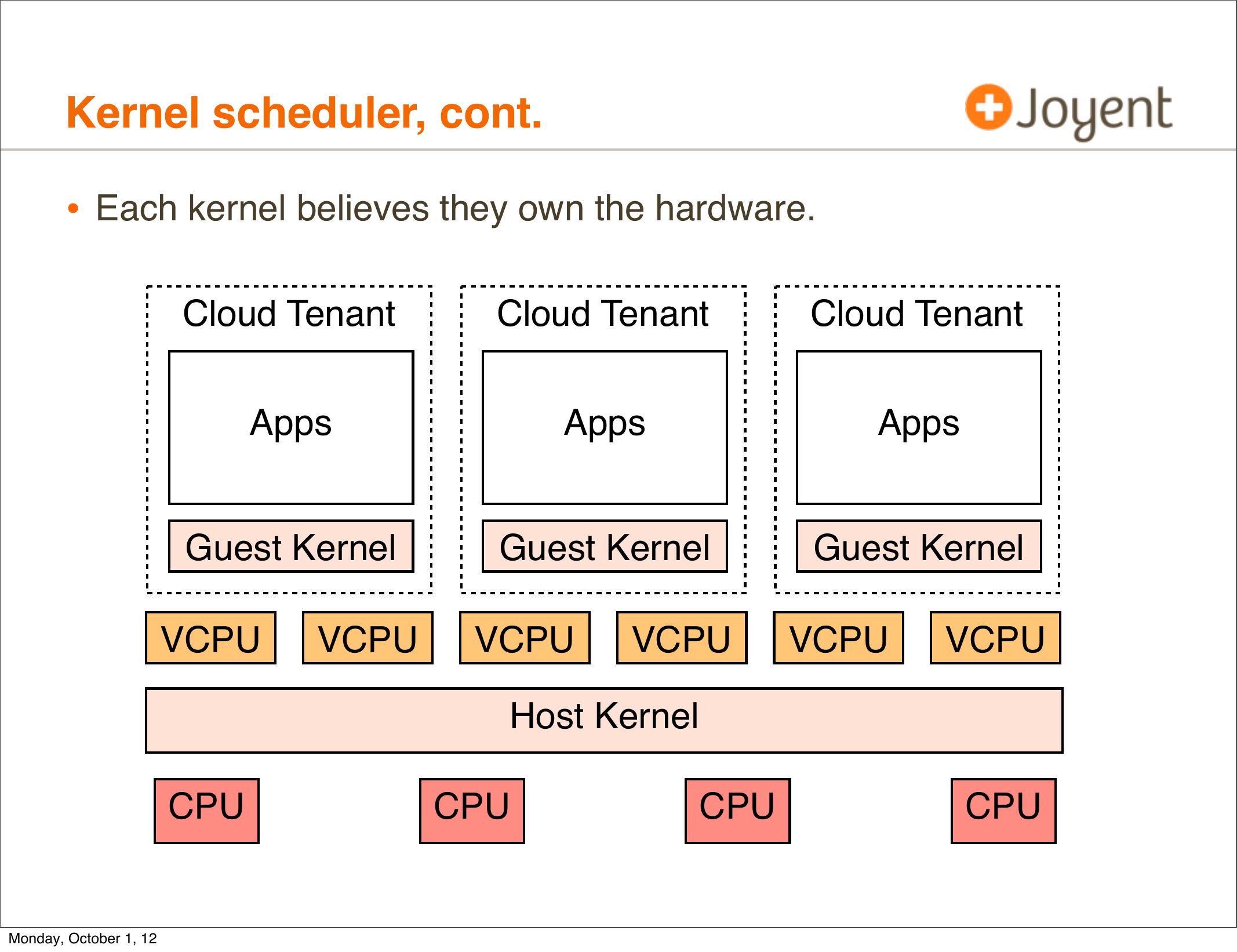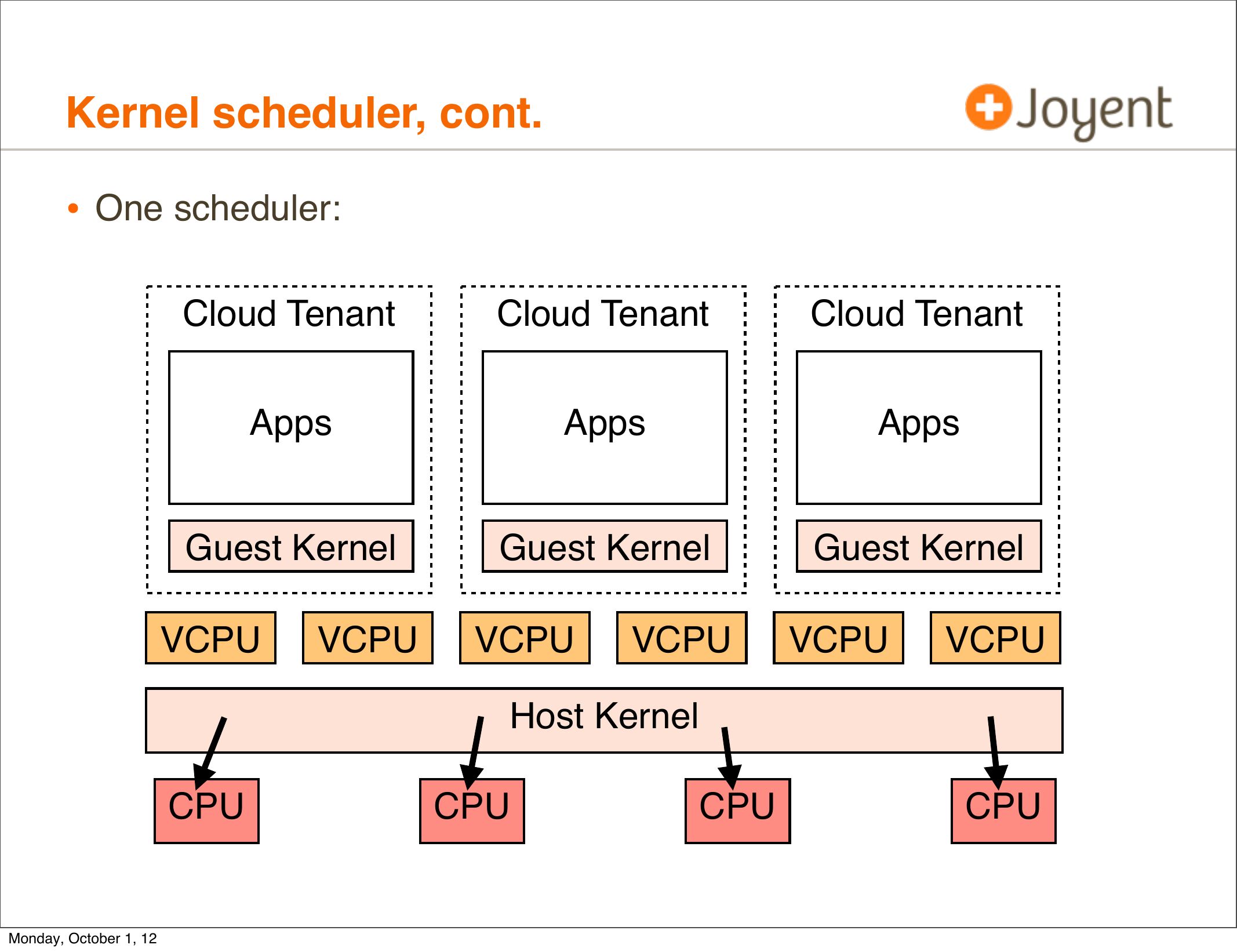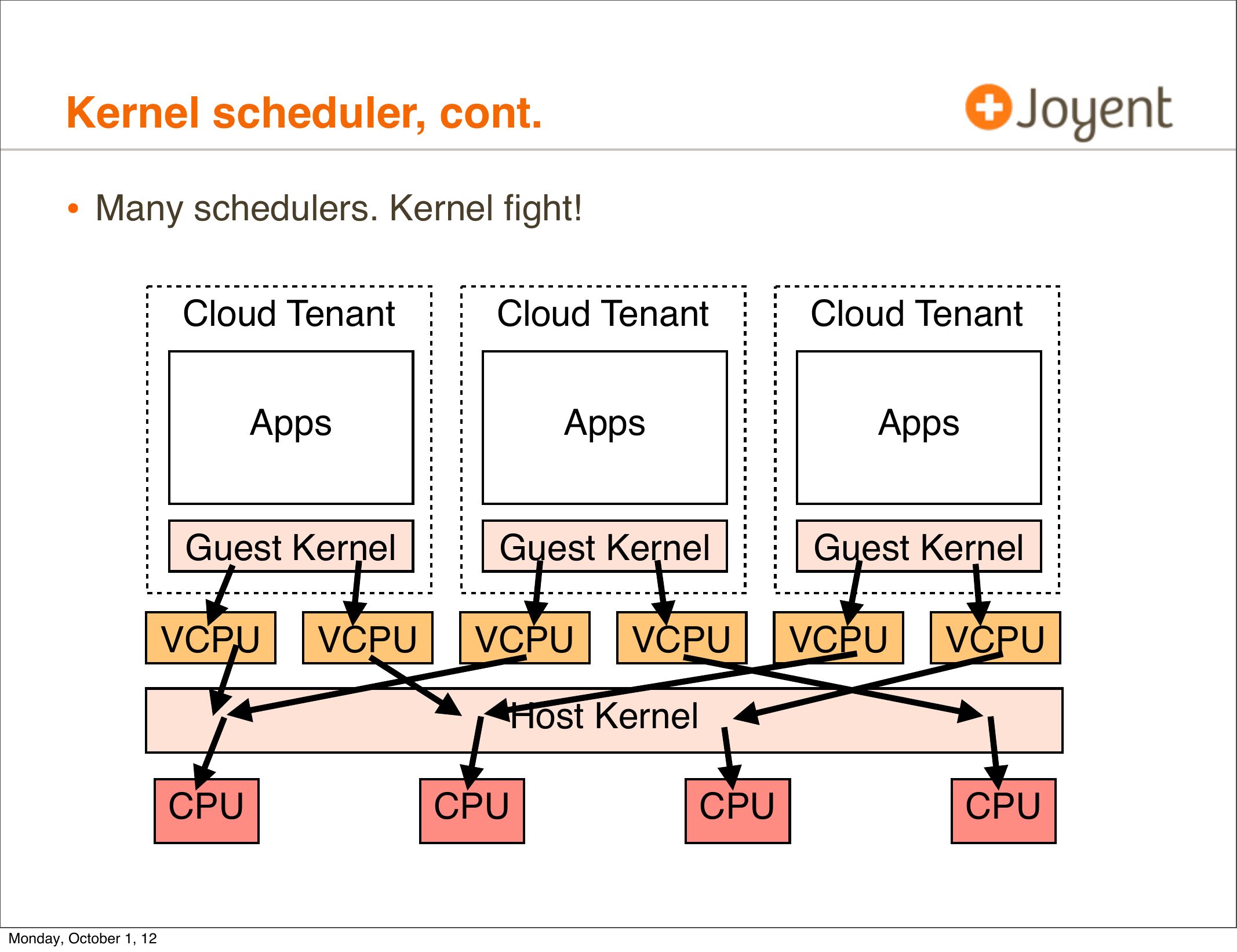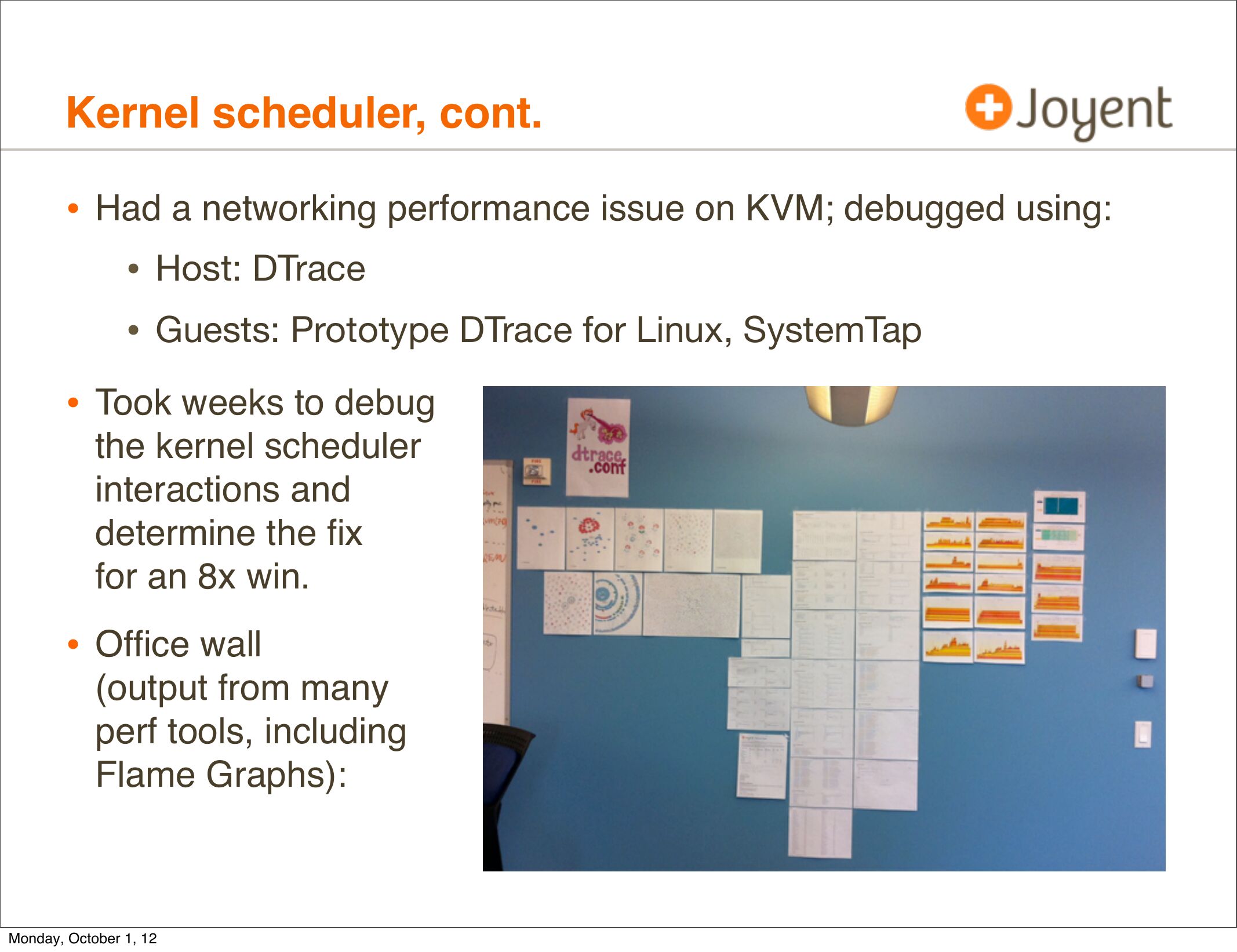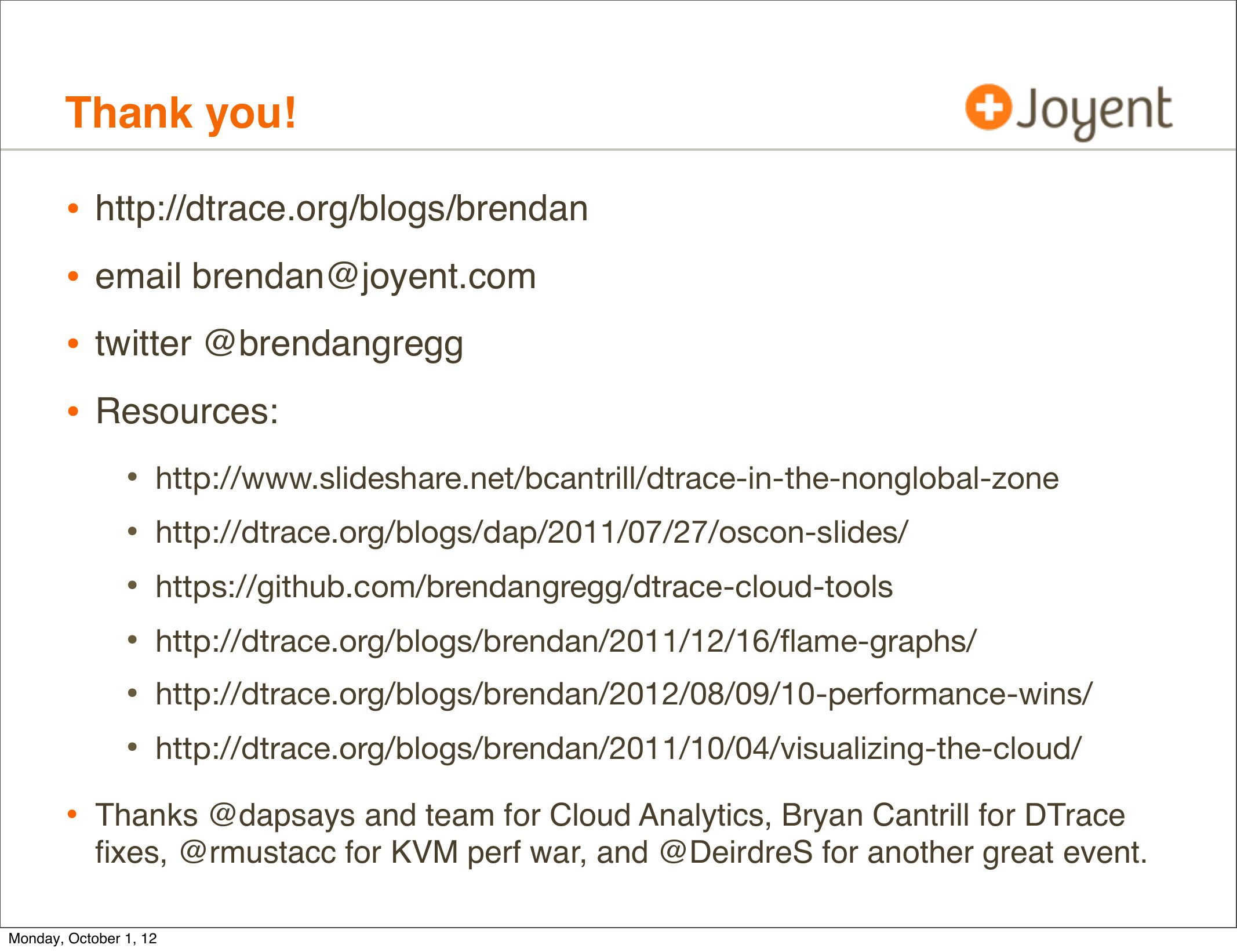illumosday 2012: DTracing the Cloud
Video: http://www.youtube.com/watch?v=uZTMuXXFG38A talk for illumosday 2012 by Brendan Gregg.
Description: "Cloud computing facilitates rapid deployment and scaling, often pushing high load at applications under continual development. DTrace allows immediate analysis of issues on live production systems even in these demanding environments – no need to restart or run a special debug kernel.
For the illumos kernel, DTrace has been enhanced to support cloud computing, providing more observation capabilities to zones as used by Joyent SmartMachine customers. DTrace is also frequently used by the cloud operators to analyze systems and verify performance isolation of tenants.
This talk covers DTrace in the illumos-based cloud, showing examples of real-world performance wins."
PDF: dtracecloud2012.pdf
Keywords (from pdftotext):
slide 1:
DTracing the Cloud Brendan Gregg Lead Performance Engineer brendan@joyent.com @brendangregg Monday, October 1, 12 October, 2012slide 2:
DTracing the Cloud Monday, October 1, 12slide 3:
whoami • G’Day, I’m Brendan • These days I do performance analysis of the cloud • I use the right tool for the job; sometimes traditional, often DTrace. Traditional + some DTrace All DTrace Monday, October 1, 12slide 4:
DTrace • DTrace is a magician that conjures up rainbows, ponies and unicorns — and does it all entirely safely and in production! Monday, October 1, 12slide 5:
DTrace • Or, the version with fewer ponies: • DTrace is a performance analysis and troubleshooting tool • Instruments all software, kernel and user-land. • Production safe. Designed for minimum overhead. • Default in SmartOS, Oracle Solaris, Mac OS X and FreeBSD. Two Linux ports are in development. • There’s a couple of awesome books about it. Monday, October 1, 12slide 6:
illumos • Joyent’s SmartOS uses (and contributes to) the illumos kernel. • illumos is the most DTrace-featured kernel • illumos community includes Bryan Cantrill & Adam Leventhal, DTrace co-inventors (pictured on right). Monday, October 1, 12slide 7:
Agenda • Theory • Cloud types and DTrace visibility • Reality • DTrace and Zones • DTrace Wins • Tools • DTrace Cloud Tools • Cloud Analytics • Case Studies Monday, October 1, 12slide 8:
Theory Monday, October 1, 12slide 9:
Cloud Types • We deploy two types of virtualization on SmartOS/illumos: • Hardware Virtualization: KVM • OS-Virtualization: Zones Monday, October 1, 12slide 10:
Cloud Types, cont. • Both virtualization types can co-exist: Linux Windows SmartOS Cloud Tenant Cloud Tenant Cloud Tenant Apps Apps Apps Guest Kernel Guest Kernel Virtual Device Drivers Host Kernel SmartOS Monday, October 1, 12slide 11:
Cloud Types, cont. • KVM • Used for Linux and Windows guests • Legacy apps • Zones • Used for SmartOS guests (zones) called SmartMachines • Preferred over Linux: • Bare-metal performance • Less memory overheads • Better visibility (debugging) • Global Zone == host, Non-Global Zone == guest • Also used to encapsulate KVM guests (double-hull security) Monday, October 1, 12slide 12:
Cloud Types, cont. • DTrace can be used for: • Performance analysis: user- and kernel-level • Troubleshooting • Specifically, for the cloud: • Performance effects of multi-tenancy • Effectiveness and troubleshooting of performance isolation • Four contexts: • KVM host, KVM guest, Zones host, Zones guest • FAQ: What can DTrace see in each context? Monday, October 1, 12slide 13:
Hardware Virtualization: DTrace Visibility • As the cloud operator (host): Linux Linux Windows Cloud Tenant Cloud Tenant Cloud Tenant Apps Apps Apps Guest Kernel Guest Kernel Guest Kernel Virtual Device Drivers Host Kernel SmartOS Monday, October 1, 12slide 14:
Hardware Virtualization: DTrace Visibility • Host can see: • Entire host: kernel, apps • Guest disk I/O (block-interface-level) • Guest network I/O (packets) • Guest CPU MMU context register • Host can’t see: • Guest kernel • Guest apps • Guest disk/network context (kernel stack) • ... unless the guest has DTrace, and access (SSH) is allowed Monday, October 1, 12slide 15:
Hardware Virtualization: DTrace Visibility • As a tenant (guest): Linux An OS with DTrace Windows Cloud Tenant Cloud Tenant Cloud Tenant Apps Apps Apps Guest Kernel Guest Kernel Guest Kernel Virtual Device Drivers Host Kernel SmartOS Monday, October 1, 12slide 16:
Hardware Virtualization: DTrace Visibility • Guest can see: • Guest kernel, apps, provided DTrace is available • Guest can’t see: • Other guests • Host kernel, apps Monday, October 1, 12slide 17:
OS Virtualization: DTrace Visibility • As the cloud operator (host): SmartOS SmartOS SmartOS Cloud Tenant Cloud Tenant Cloud Tenant Apps Apps Apps Host Kernel SmartOS Monday, October 1, 12slide 18:
OS Virtualization: DTrace Visibility • Host can see: • Entire host: kernel, apps • Entire guests: apps Monday, October 1, 12slide 19:
OS Virtualization: DTrace Visibility • Operators can trivially see the entire cloud • Direct visibility from host of all tenant processes • Each blob is a tenant. The background shows one entire data center (availability zone). Monday, October 1, 12slide 20:
OS Virtualization: DTrace Visibility • Zooming in, 1 host, 10 guests: • All can be examined with 1 DTrace invocation; don’t need multiple SSH or API logins per-guest. Reduces observability framework overhead by a factor of 10 (guests/host) • This pic was just created from a process snapshot (ps) http://dtrace.org/blogs/brendan/2011/10/04/visualizing-the-cloud/ Monday, October 1, 12slide 21:
OS Virtualization: DTrace Visibility • As a tenant (guest): SmartOS SmartOS SmartOS Cloud Tenant Cloud Tenant Cloud Tenant Apps Apps Apps Host Kernel SmartOS Monday, October 1, 12slide 22:
OS Virtualization: DTrace Visibility • Guest can see: • Guest apps • Some host kernel (in guest context), as configured by DTrace zone privileges • Guest can’t see: • Other guests • Host kernel (in non-guest context), apps Monday, October 1, 12slide 23:
OS Stack DTrace Visibility • Entire operating system stack (example): Applications DBs, all server types, ... Virtual Machines System Libaries System Call Interface VFS Sockets UFS/... ZFS TCP/UDP Volume Managers Block Device Interface Ethernet Device Drivers Devices Monday, October 1, 12slide 24:
OS Stack DTrace Visibility • Entire operating system stack (example): Applications DBs, all server types, ... user kernel Monday, October 1, 12 Virtual Machines System Libaries System Call Interface VFS Sockets UFS/... ZFS TCP/UDP Volume Managers Block Device Interface Ethernet Device Drivers Devices DTraceslide 25:
Reality Monday, October 1, 12slide 26:
DTrace and Zones • DTrace and Zones were developed in parallel for Solaris 10, and then integrated. • DTrace functionality for the Global Zone (GZ) was added first. • This is the host context, and allows operators to use DTrace to inspect all tenants. • DTrace functionality for the Non-Global Zone (NGZ) was harder, and some capabilities added later (2006): • Providers: syscall, pid, profile • This is the guest context, and allows customers to use DTrace to inspect themselves only (can’t see neighbors). Monday, October 1, 12slide 27:
DTrace and Zones, cont. Monday, October 1, 12slide 28:
DTrace and Zones, cont.
• GZ DTrace works well.
• We found many issues in practice with NGZ DTrace:
• Can’t read fds[] to translate file descriptors. Makes using the
syscall provider more difficult.
# dtrace -n 'syscall::read:entry /fds[arg0].fi_fs == "zfs"/ { @ =
quantize(arg2); }'
dtrace: description 'syscall::read:entry ' matched 1 probe
dtrace: error on enabled probe ID 1 (ID 4: syscall::read:entry): invalid
kernel access in predicate at DIF offset 64
dtrace: error on enabled probe ID 1 (ID 4: syscall::read:entry): invalid
kernel access in predicate at DIF offset 64
dtrace: error on enabled probe ID 1 (ID 4: syscall::read:entry): invalid
kernel access in predicate at DIF offset 64
dtrace: error on enabled probe ID 1 (ID 4: syscall::read:entry): invalid
kernel access in predicate at DIF offset 64
[...]
Monday, October 1, 12
slide 29:
DTrace and Zones, cont.
• Can’t read curpsinfo, curlwpsinfo, which breaks many scripts
(eg, curpsinfo->gt;pr_psargs, or curpsinfo->gt;pr_dmodel)
# dtrace -n 'syscall::exec*:return { trace(curpsinfo->gt;pr_psargs); }'
dtrace: description 'syscall::exec*:return ' matched 1 probe
dtrace: error on enabled probe ID 1 (ID 103: syscall::exece:return): invalid
kernel access in action #1 at DIF offset 0
dtrace: error on enabled probe ID 1 (ID 103: syscall::exece:return): invalid
kernel access in action #1 at DIF offset 0
dtrace: error on enabled probe ID 1 (ID 103: syscall::exece:return): invalid
kernel access in action #1 at DIF offset 0
dtrace: error on enabled probe ID 1 (ID 103: syscall::exece:return): invalid
kernel access in action #1 at DIF offset 0
[...]
• Missing proc provider. Breaks this common one-liner:
# dtrace -n 'proc:::exec-success { trace(execname); }'
dtrace: invalid probe specifier proc:::exec-success { trace(execname); }:
probe description proc:::exec-success does not match any probes
[...]
Monday, October 1, 12
slide 30:DTrace and Zones, cont. • Missing vminfo, sysinfo, and sched providers. • Can’t read cpu built-in. • profile probes behave oddly. Eg, profile:::tick-1s only fires if tenant is on-CPU at the same time as the probe would fire. Makes any script that produces interval-output unreliable. Monday, October 1, 12slide 31:
DTrace and Zones, cont.
• These and other bugs have since been fixed for SmartOS/illumos
(thanks Bryan Cantrill!)
• Now, from a SmartOS Zone:
# dtrace -n 'proc:::exec-success { @[curpsinfo->gt;pr_psargs] = count(); }
profile:::tick-5s { exit(0); }'
dtrace: description 'proc:::exec-success ' matched 2 probes
CPU
FUNCTION:NAME
13 71762
:tick-5s
-bash
/bin/cat -s /etc/motd
/bin/mail -E
/usr/bin/hostname
/usr/sbin/quota
/usr/bin/locale -a
ls -l
sh -c /usr/bin/locale -a
• Trivial DTrace one-liner, but represents much needed functionality.
Monday, October 1, 12
slide 32:DTrace Wins • Aside from the NGZ issues, DTrace has worked well in the cloud and solved numerous issues. For example (these are mostly from operator context): • http://dtrace.org/blogs/brendan/2012/08/09/10-performance-wins/ Monday, October 1, 12slide 33:
DTrace Wins, cont. • Not surprising given DTrace’s visibility... Monday, October 1, 12slide 34:
DTrace Wins, cont. • For example, DTrace script counts from the DTrace book: 10+ 10+ Monday, October 1, 12 Applications DBs, all server types, ... Virtual Machines System Libaries System Call Interface VFS Sockets UFS/... ZFS TCP/UDP Volume Managers Block Device Interface Ethernet Device Drivers Devicesslide 35:
Tools Monday, October 1, 12slide 36:
Ad-hoc • Write DTrace scripts as needed • Execute individually on hosts, or, • With ah-hoc scripting, execute across all hosts (cloud) • My ad-hoc tools include: • DTrace Cloud Tools • Flame Graphs Monday, October 1, 12slide 37:
Ad-hoc: DTrace Cloud Tools • Contains around 70 ad-hoc DTrace tools written by myself for operators and cloud customers. ./fs/metaslab_free.d ./fs/spasync.d ./fs/zfsdist.d ./fs/zfsslower.d ./fs/zfsslowzone.d ./fs/zfswhozone.d ./fs/ziowait.d ./mysql/innodb_pid_iolatency.d ./mysql/innodb_pid_ioslow.d ./mysql/innodb_thread_concurrency.d ./mysql/libmysql_pid_connect.d ./mysql/libmysql_pid_qtime.d ./mysql/libmysql_pid_snoop.d ./mysql/mysqld_latency.d ./mysql/mysqld_pid_avg.d ./mysql/mysqld_pid_filesort.d ./mysql/mysqld_pid_fslatency.d [...] ./net/dnsconnect.d ./net/tcp-fbt-accept_sdc5.d ./net/tcp-fbt-accept_sdc6.d ./net/tcpconnreqmaxq-pid_sdc5.d ./net/tcpconnreqmaxq-pid_sdc6.d ./net/tcpconnreqmaxq_sdc5.d ./net/tcpconnreqmaxq_sdc6.d ./net/tcplistendrop_sdc5.d ./net/tcplistendrop_sdc6.d ./net/tcpretranshosts.d ./net/tcpretransport.d ./net/tcpretranssnoop_sdc5.d ./net/tcpretranssnoop_sdc6.d ./net/tcpretransstate.d ./net/tcptimewait.d ./net/tcptimewaited.d ./net/tcptimretransdropsnoop_sdc6.d [...] • Customer scripts are linked from the “smartmachine” directory • https://github.com/brendangregg/dtrace-cloud-tools Monday, October 1, 12slide 38:
Ad-hoc: DTrace Cloud Tools, cont. • For example, tcplistendrop.d traces each kernel-dropped SYN due to TCP backlog overflow (saturation): # ./tcplistendrop.d TIME 2012 Jan 19 01:22:49 2012 Jan 19 01:22:49 2012 Jan 19 01:22:49 2012 Jan 19 01:22:49 2012 Jan 19 01:22:49 2012 Jan 19 01:22:49 2012 Jan 19 01:22:49 2012 Jan 19 01:22:49 2012 Jan 19 01:22:49 [...] SRC-IP PORT DST-IP 25691 ->gt; 192.192.240.212 18423 ->gt; 192.192.240.212 38883 ->gt; 192.192.240.212 10739 ->gt; 192.192.240.212 27988 ->gt; 192.192.240.212 28824 ->gt; 192.192.240.212 65070 ->gt; 192.192.240.212 56392 ->gt; 192.192.240.212 24628 ->gt; 192.192.240.212 • Can explain multi-second client connect latency. Monday, October 1, 12 PORTslide 39:
Ad-hoc: DTrace Cloud Tools, cont.
• tcplistendrop.d processes IP and TCP headers from the in-kernel
packet buffer:
fbt::tcp_input_listener:entry { self->gt;mp = args[1]; }
fbt::tcp_input_listener:return { self->gt;mp = 0; }
mib:::tcpListenDrop
/self->gt;mp/
this->gt;iph = (ipha_t *)self->gt;mp->gt;b_rptr;
this->gt;tcph = (tcph_t *)(self->gt;mp->gt;b_rptr + 20);
printf("%-20Y %-18s %-5d ->gt; %-18s %-5d\n", walltimestamp,
inet_ntoa(&this->gt;iph->gt;ipha_src),
ntohs(*(uint16_t *)this->gt;tcph->gt;th_lport),
inet_ntoa(&this->gt;iph->gt;ipha_dst),
ntohs(*(uint16_t *)this->gt;tcph->gt;th_fport));
• Since this traces the fbt provider (kernel), it is operator only.
Monday, October 1, 12
slide 40:Ad-hoc: DTrace Cloud Tools, cont. • A related example: tcpconnreqmaxq-pid*.d prints a summary, showing backlog lengths (on SYN arrival), the current max, and drops: tcp_conn_req_cnt_q distributions: cpid:3063 max_q:8 value ------------- Distribution ------------- count -1 | 0 |@@@@@@@@@@@@@@@@@@@@@@@@@@@@@@@@@@@@@@@@ 1 1 | Text cpid:11504 max_q:128 value ------------- Distribution ------------- count -1 | 0 |@@@@@@@@@@@@@@@@@@@@@@@@@@@@@@@@@@@ 1 |@@ 2 |@ 4 |@ 8 | 16 | 32 | 64 | 128 | 256 | tcpListenDrops: cpid:11504 Monday, October 1, 12 max_q:128slide 41:
Ad-hoc: Flame Graphs • Visualizing CPU time using DTrace profiling and SVG Monday, October 1, 12slide 42:
Product • Cloud observability products including DTrace: • Joyent’s Cloud Analytics Monday, October 1, 12slide 43:
Product: Cloud Analytics • Syscall latency across the entire cloud, as a heat map! Monday, October 1, 12slide 44:
Product: Cloud Analytics, cont. • For operators and cloud customers • Observes entire cloud, in real-time • Latency focus, including heat maps • Instrumentation: DTrace and kstats • Front-end: Browser JavaScript • Back-end: node.js and C Monday, October 1, 12slide 45:
Product: Cloud Analytics, cont. • Creating an instrumentation: Monday, October 1, 12slide 46:
Product: Cloud Analytics, cont. • Aggregating data across cloud: Monday, October 1, 12slide 47:
Product: Cloud Analytics, cont. • Visualizing data: Monday, October 1, 12slide 48:
Product: Cloud Analytics, cont. • By-host breakdowns are essential: Switch from cloud to host in one click Monday, October 1, 12slide 49:
Case Studies Monday, October 1, 12slide 50:
Case Studies • Slow disks • Scheduler Monday, October 1, 12slide 51:
Slow disks • Customer complains of poor MySQL performance. • Noticed disks are busy via iostat-based monitoring software, and have blamed noisy neighbors causing disk I/O contention. • Multi-tenancy and performance isolation are common cloud issues Monday, October 1, 12slide 52:
Slow disks, cont. • Unix 101 Process Syscall Interface VFS ZFS Block Device Interface Disks Monday, October 1, 12slide 53:
Slow disks, cont. • Unix 101 Process sync. Syscall Interface VFS ZFS Block Device Interface Disks Monday, October 1, 12 iostat(1) often async: write buffering, read aheadslide 54:
Slow disks, cont. • By measuring FS latency in application-synchronous context we can either confirm or rule-out FS/disk origin latency. • Including expressing FS latency during MySQL query, so that the issue can be quantified, and speedup calculated. • Ideally, this would be possible from within the SmartMachine, so both customer and operator can run the DTrace script. This is possible using: • pid provider: trace and time MySQL FS functions • syscall provider: trace and time read/write syscalls for FS file descriptors (hence needing fds[].fi_fs; otherwise cache open()) Monday, October 1, 12slide 55:
Slow disks, cont.
• mysql_pid_fslatency.d from dtrace-cloud-tools:
# ./mysqld_pid_fslatency.d -n 'tick-10s { exit(0); }' -p 7357
Tracing PID 7357... Hit Ctrl-C to end.
MySQL filesystem I/O: 55824; latency (ns):
read
write
Monday, October 1, 12
value ------------- Distribution ------------- count
1024 |
2048 |@@@@@@@@@@
4096 |@@@@@@@@@@@@@@@@@
8192 |@@@@@@@@@@@
16384 |@@
32768 |
65536 |
131072 |
262144 |
value ------------- Distribution ------------- count
2048 |
4096 |
8192 |@@@@@@
16384 |@@@@@@@@@@@@@@@@@@@@@@@@@@@@
32768 |@@@@@
65536 |@
131072 |
262144 |
524288 |
1048576 |
2097152 |
4194304 |
8388608 |
16777216 |
33554432 |
slide 56:
Slow disks, cont.
• mysql_pid_fslatency.d from dtrace-cloud-tools:
# ./mysqld_pid_fslatency.d -n 'tick-10s { exit(0); }' -p 7357
Tracing PID 7357... Hit Ctrl-C to end.
MySQL filesystem I/O: 55824; latency (ns):
read
write
Monday, October 1, 12
value ------------- Distribution ------------- count
1024 |
2048 |@@@@@@@@@@
4096 |@@@@@@@@@@@@@@@@@
8192 |@@@@@@@@@@@
16384 |@@
32768 |
65536 |
131072 |
262144 |
value ------------- Distribution ------------- count
2048 |
4096 |
8192 |@@@@@@
16384 |@@@@@@@@@@@@@@@@@@@@@@@@@@@@
32768 |@@@@@
65536 |@
131072 |
262144 |
524288 |
1048576 |
2097152 |
4194304 |
8388608 |
16777216 |
33554432 |
DRAM
cache hits
Disk I/O
slide 57:
Slow disks, cont.
• mysql_pid_fslatency.d is about 30 lines of DTrace:
pid$target::os_file_read:entry,
pid$target::os_file_write:entry,
pid$target::my_read:entry,
pid$target::my_write:entry
self->gt;start = timestamp;
pid$target::os_file_read:return { this->gt;dir = "read"; }
pid$target::os_file_write:return { this->gt;dir = "write"; }
pid$target::my_read:return
{ this->gt;dir = "read"; }
pid$target::my_write:return
{ this->gt;dir = "write"; }
pid$target::os_file_read:return,
pid$target::os_file_write:return,
pid$target::my_read:return,
pid$target::my_write:return
/self->gt;start/
@time[this->gt;dir] = quantize(timestamp - self->gt;start);
@num = count();
self->gt;start = 0;
dtrace:::END
printa("MySQL filesystem I/O: %@d; latency (ns):\n", @num);
printa(@time);
clear(@time); clear(@num);
Monday, October 1, 12
slide 58:
Slow disks, cont.
• mysql_pid_fslatency.d is about 30 lines of DTrace:
pid$target::os_file_read:entry,
pid$target::os_file_write:entry,
pid$target::my_read:entry,
pid$target::my_write:entry
self->gt;start = timestamp;
Thank you MySQL!
If not that easy,
try syscall with fds[]
pid$target::os_file_read:return { this->gt;dir = "read"; }
pid$target::os_file_write:return { this->gt;dir = "write"; }
pid$target::my_read:return
{ this->gt;dir = "read"; }
pid$target::my_write:return
{ this->gt;dir = "write"; }
pid$target::os_file_read:return,
pid$target::os_file_write:return,
pid$target::my_read:return,
pid$target::my_write:return
/self->gt;start/
@time[this->gt;dir] = quantize(timestamp - self->gt;start);
@num = count();
self->gt;start = 0;
dtrace:::END
printa("MySQL filesystem I/O: %@d; latency (ns):\n", @num);
printa(@time);
clear(@time); clear(@num);
Monday, October 1, 12
slide 59:Slow disks, cont. • Going for the slam dunk: # ./mysqld_pid_fslatency_slowlog.d 29952 2011 May 16 23:34:00 filesystem I/O during query >gt; 100 ms: query 538 ms, fs 509 ms, 83 I/O 2011 May 16 23:34:11 filesystem I/O during query >gt; 100 ms: query 342 ms, fs 303 ms, 75 I/O 2011 May 16 23:34:38 filesystem I/O during query >gt; 100 ms: query 479 ms, fs 471 ms, 44 I/O 2011 May 16 23:34:58 filesystem I/O during query >gt; 100 ms: query 153 ms, fs 152 ms, 1 I/O 2011 May 16 23:35:09 filesystem I/O during query >gt; 100 ms: query 383 ms, fs 372 ms, 72 I/O 2011 May 16 23:36:09 filesystem I/O during query >gt; 100 ms: query 406 ms, fs 344 ms, 109 I/O 2011 May 16 23:36:44 filesystem I/O during query >gt; 100 ms: query 343 ms, fs 319 ms, 75 I/O 2011 May 16 23:36:54 filesystem I/O during query >gt; 100 ms: query 196 ms, fs 185 ms, 59 I/O 2011 May 16 23:37:10 filesystem I/O during query >gt; 100 ms: query 254 ms, fs 209 ms, 83 I/O • Shows FS latency as a proportion of Query latency • mysld_pid_fslatency_slowlog*.d in dtrace-cloud-tools Monday, October 1, 12slide 60:
Slow disks, cont. • The cloud operator can trace kernel internals. Eg, the VFS->gt;ZFS interface using zfsslower.d: # ./zfsslower.d 10 TIME PROCESS 2012 Sep 27 13:45:33 zlogin 2012 Sep 27 13:45:36 bash 2012 Sep 27 13:45:58 mysqld 2012 Sep 27 13:45:58 mysqld 2012 Sep 27 13:46:14 master libexec/postfix/qmgr 2012 Sep 27 13:46:14 master postfix/master.cf [...] ms FILE 11 /zones/b8b2464c/var/adm/wtmpx 14 /zones/b8b2464c/opt/local/bin/zsh 19 /zones/b8b2464c/var/mysql/ibdata1 22 /zones/b8b2464c/var/mysql/ibdata1 6 /zones/b8b2464c/root/opt/local/ /zones/b8b2464c/root/opt/local/etc/ • My go-to tool (does all apps). This example showed if there were VFS-level I/O >gt; 10ms? (arg == 10) • Stupidly easy to do Monday, October 1, 12slide 61:
Slow disks, cont.
• zfs_read() entry ->gt; return; same for zfs_write().
[...]
fbt::zfs_read:entry,
fbt::zfs_write:entry
self->gt;path = args[0]->gt;v_path;
self->gt;kb = args[1]->gt;uio_resid / 1024;
self->gt;start = timestamp;
fbt::zfs_read:return,
fbt::zfs_write:return
/self->gt;start && (timestamp - self->gt;start) >gt;= min_ns/
this->gt;iotime = (timestamp - self->gt;start) / 1000000;
this->gt;dir = probefunc == "zfs_read" ? "R" : "W";
printf("%-20Y %-16s %1s %4d %6d %s\n", walltimestamp,
execname, this->gt;dir, self->gt;kb, this->gt;iotime,
self->gt;path != NULL ? stringof(self->gt;path) : "gt;");
[...]
• zfsslower.d originated from the DTrace book
Monday, October 1, 12
slide 62:
Slow disks, cont.
• The operator can use deeper tools as needed. Anywhere in ZFS.
# dtrace -n 'io:::start { @[stack()] = count(); }'
dtrace: description 'io:::start ' matched 6 probes
genunix`ldi_strategy+0x53
zfs`vdev_disk_io_start+0xcc
zfs`zio_vdev_io_start+0xab
zfs`zio_execute+0x88
zfs`zio_nowait+0x21
zfs`vdev_mirror_io_start+0xcd
zfs`zio_vdev_io_start+0x250
zfs`zio_execute+0x88
zfs`zio_nowait+0x21
zfs`arc_read_nolock+0x4f9
zfs`arc_read+0x96
zfs`dsl_read+0x44
zfs`dbuf_read_impl+0x166
zfs`dbuf_read+0xab
zfs`dmu_buf_hold_array_by_dnode+0x189
zfs`dmu_buf_hold_array+0x78
zfs`dmu_read_uio+0x5c
zfs`zfs_read+0x1a3
genunix`fop_read+0x8b
genunix`read+0x2a7
Monday, October 1, 12
slide 63:Slow disks, cont. • Cloud Analytics, for either operator or customer, can be used to examine the full latency distribution, including outliers: Outliers This heat map shows FS latency for an entire cloud data center Monday, October 1, 12slide 64:
Slow disks, cont. • Found that the customer problem was not disks or FS (99% of the time), but was CPU usage during table joins. • On Joyent’s IaaS architecture, it’s usually not the disks or filesystem; useful to rule that out quickly. • Some of the time it is, due to: • Bad disks (1000+ms I/O) • Controller issues (PERC) • Big I/O (how quick is a 40 Mbyte read from cache?) • Other tenants (benchmarking!). Much less for us now with ZFS I/O throttling (thanks Bill Pijewski), used for disk performance isolation in the SmartOS cloud. Monday, October 1, 12slide 65:
Slow disks, cont. • Customer resolved real issue • Prior to DTrace analysis, had spent months of poor performance believing disks were to blame Monday, October 1, 12slide 66:
Kernel scheduler • Customer problem: occasional latency outliers • Analysis: no smoking gun. No slow I/O or locks, etc. Some random dispatcher queue latency, but with CPU headroom. $ prstat -mLc 1 PID USERNAME USR SYS TRP TFL DFL LCK SLP LAT VCX ICX SCL SIG PROCESS/LWPID 17930 103 21 7.6 0.0 0.0 0.0 53 16 9.1 57K 1 73K 0 beam.smp/265 17930 103 20 7.0 0.0 0.0 0.0 57 16 0.4 57K 2 70K 0 beam.smp/264 17930 103 20 7.4 0.0 0.0 0.0 53 18 1.7 63K 0 78K 0 beam.smp/263 17930 103 19 6.7 0.0 0.0 0.0 60 14 0.4 52K 0 65K 0 beam.smp/266 17930 103 2.0 0.7 0.0 0.0 0.0 96 1.6 0.0 6K 0 8K 0 beam.smp/267 17930 103 1.0 0.9 0.0 0.0 0.0 97 0.9 0.0 0 47 0 beam.smp/280 [...] Monday, October 1, 12slide 67:
Kernel scheduler, cont. • Unix 101 Threads: R = Ready to run O = On-CPU R R R Run Queue Scheduler preemption R R R R Run Queue Monday, October 1, 12 CPU CPUslide 68:
Kernel scheduler, cont. • Unix 102 • TS (and FSS) check for CPU starvation Priority Promotion R R R R R R R Run Queue CPU Starvation Monday, October 1, 12 CPUslide 69:
Kernel scheduler, cont. • Experimentation: run 2 CPU-bound threads, 1 CPU • Subsecond offset heat maps: Monday, October 1, 12slide 70:
Kernel scheduler, cont. • Experimentation: run 2 CPU-bound threads, 1 CPU • Subsecond offset heat maps: THIS SHOULDNT HAPPEN Monday, October 1, 12slide 71:
Kernel scheduler, cont.
• Worst case (4 threads 1 CPU), 44 sec dispq latency
# dtrace -n 'sched:::off-cpu /execname == "burn1"/ { self->gt;s = timestamp; }
sched:::on-cpu /self->gt;s/ { @["off-cpu (ms)"] =
lquantize((timestamp - self->gt;s) / 1000000, 0, 100000, 1000); self->gt;s = 0; }'
off-cpu (ms)
value ------------- Distribution ------------- count
slide 72:
Kernel scheduler, cont.
• FSS scheduler class bug:
• FSS uses a more complex technique to avoid CPU starvation. A
thread priority could stay high and on-CPU for many seconds
before the priority is decayed to allow another thread to run.
• Analyzed (more DTrace) and fixed (thanks Jerry Jelinek)
• Under (too) high CPU load, your runtime can be bound by how
well you schedule, not do work
• Cloud workloads scale fast, hit (new) scheduler issues
Monday, October 1, 12
slide 73:
Kernel scheduler, cont.
• Required the operator of the cloud to debug
• Even if the customer doesn’t have kernel-DTrace access in the
zone, they still benefit from the cloud provider having access
• Ask your cloud provider to trace scheduler internals, in case
you have something similar
• On Hardware Virtualization, scheduler issues can be terrifying
Monday, October 1, 12
slide 74:
Kernel scheduler, cont.
• Each kernel believes they own the hardware.
Cloud Tenant
Cloud Tenant
Cloud Tenant
Apps
Apps
Apps
Guest Kernel
Guest Kernel
Guest Kernel
VCPU
VCPU
VCPU
VCPU
VCPU
VCPU
Host Kernel
CPU
Monday, October 1, 12
CPU
CPU
CPU
slide 75:
Kernel scheduler, cont.
• One scheduler:
Cloud Tenant
Cloud Tenant
Cloud Tenant
Apps
Apps
Apps
Guest Kernel
Guest Kernel
Guest Kernel
VCPU
VCPU
VCPU
VCPU
VCPU
VCPU
Host Kernel
CPU
Monday, October 1, 12
CPU
CPU
CPU
slide 76:
Kernel scheduler, cont.
• Many schedulers. Kernel fight!
Cloud Tenant
Cloud Tenant
Cloud Tenant
Apps
Apps
Apps
Guest Kernel
Guest Kernel
Guest Kernel
VCPU
VCPU
VCPU
VCPU
VCPU
VCPU
Host Kernel
CPU
Monday, October 1, 12
CPU
CPU
CPU
slide 77:
Kernel scheduler, cont.
• Had a networking performance issue on KVM; debugged using:
• Host: DTrace
• Guests: Prototype DTrace for Linux, SystemTap
• Took weeks to debug
the kernel scheduler
interactions and
determine the fix
for an 8x win.
• Office wall
(output from many
perf tools, including
Flame Graphs):
Monday, October 1, 12
slide 78:
Thank you!
• http://dtrace.org/blogs/brendan
• email brendan@joyent.com
• twitter @brendangregg
• Resources:
• http://www.slideshare.net/bcantrill/dtrace-in-the-nonglobal-zone
• http://dtrace.org/blogs/dap/2011/07/27/oscon-slides/
• https://github.com/brendangregg/dtrace-cloud-tools
• http://dtrace.org/blogs/brendan/2011/12/16/flame-graphs/
• http://dtrace.org/blogs/brendan/2012/08/09/10-performance-wins/
• http://dtrace.org/blogs/brendan/2011/10/04/visualizing-the-cloud/
• Thanks @dapsays and team for Cloud Analytics, Bryan Cantrill for DTrace
fixes, @rmustacc for KVM perf war, and @DeirdreS for another great event.
Monday, October 1, 12
